CFE DRIVES ENERGY EFFICIENCY











CPM moving up the gears with conditioner technology.
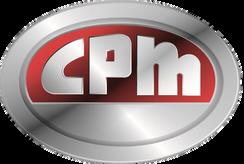 CPM 24-LT-10 Conditioner
CPM 24-LT-10 Conditioner
To find out more about our products and services and to contact Lauren, visit trouwnutrition.co.uk

















“Find out how our feed mill efficiency team can fine tune your process to save you money whilst reducing your carbon footprint.”
Lauren James Feed Additive Product Manager Trouw Nutrition GB
SUBSCRIPTION RATES:
One year: £80
Two years: £150
Three years: £200
ISSN 0950-771X








Views expressed by contributors are not necessarily those of the Publisher.

Feed Compounder September/OctOber 2023 page 1 Opinion: The Most Volatile Ever? 2 Ryan Mounsey: Feed Production Update 4 Robert Ashton: 10 Ways to Make a Difference 12 Colin Ley: View from Europe 14 Christine Pedersen: Milk Matters 16 Know what is in the Clamp and Supplement Precisely 17 Matthew Wedzerai: Scientifically Speaking … 18 Roger Dean: Company Reports & Accounts 20 Green Pages 22 Feed Trade Topics From the Island of Ireland Optimising Energy Usage in the Pelleting Process - Time for Change 26 With Con Lynch and Louis White Feeding People While Preserving the Planet 30 With Mark Lyons, Vaugn Holder and Nikki Putnam In Memory of Alf Croston 32 By Andrew Mounsey and Nevil and Roger Croston Futureproofing our Returns from Essential Oil Feed Additives 34 By Iain Campbell Extracting More Feed Value from Home Grown Forages 36 By Dr Philip Ingram ForFarmers 2023 First-Half Results 38 Precision Feeding of Poultry 40 By Ralph Bishop Optimum performance Under Oxidative Stress with Hydroxy-SelenoMethionine 42 By Florence Rudeaux New Products in the Feed Industry 47 In Brief 48 Why Levels of Mycotoxins May Be Increasing in Europe 53 By Sander Janssen Feed Production Machinery, Pelleting & Extruding 54 Feed Ingredients: Protein Products 56 Novel Ingredients for Feed / the Search for Soya Replacement 59 People 60 Buyers’ Guide 62 COMMENT COMPOUNDE R F EED Contents September/October 2023 Vol. 43 No. 5
Print
and On-Line
© Feed Compounder 2023 DEPUTY EDITOR: Ryan Mounsey ADVERTISEMENT/SALES MANAGER: Fiona Mounsey EDITOR: Andrew Mounsey PUBLISHED BY: Pentlands Publishing Ltd Plas Y Coed Velfrey Road Whitland SA34 0RA United Kingdom Tel: +44 (0) 1994 240002 Web site: www.feedcompounder.com E-mail: mail@feedcompounder.com
THE MOST VOLATILE EVER?
It’s a big statement to say something is the best, or worst, in living memory, but the UK grain trade is pretty close to justifying a ‘most volatile ever’ description as we approach the business end of the 2023 harvest.
Market volatility, driven by Russia’s invasion of Ukraine, and carried on by changing weather patterns globally, is creating a trading environment where cereal prices are moving up and down by anything between £3 and £6 a tonne on a daily basis. The daily rise and fall for oilseeds is even more pronounced at between £5 and £10 a tonne.
Add to this, severe on-farm anxieties over the quality of the current crop against the background of massive changes in input costs over the last two years and our volatility description could almost be termed something of an under-statement.
In addition, talking to growers and traders recently, there is also widespread concern over malting barley samples, some of which already look to be more suited to the feed sector than their preferred whisky production outlets. It’s all looking ‘very average’ at present, was how one UK grower summed up his harvest to date.
It’s much the same elsewhere in Europe with Copa and Cogeca, the EU farmer and farm co-op organisation, seeking urgent action from the European Commission in the face of a 2023 arable harvest which they say has deteriorated rapidly over the last two months.
The Brussels-based organisation has warned that the European cereals crop is in the throes of possibly its worst harvest since 2007, potentially leaving total output 10% below the sector’s most recent 5-year average.
How all this will play into the feed ingredients market is perplexing, especially with AHDB talking up the prospect of bigger crops being available in Ukraine and Russia (although such crops may never become available globally this year). There’s also the existence of larger than normal maize crops in the US to take into account.
Move too quickly on a feed ingredients purchase in such circumstances, therefore, and you could miss an emerging low price opportunity. Wait too long and you could be left with thoughts of what might have been as you pay the price of a delayed decision.
Many farmers, in an attempt to extract the best they can from the 2023 market, are sitting with more stored grain than usual, some of it from 2022. Their hope is that last year’s £250-£300 a tonne wheat prices will return, thoughts that are prompting them to reject the option of selling at today’s £180/190 a tonne trading range. The best advice for those in this situation is surely to average their returns over the last 24 months and accept this year’s reality. The other side of the coin,
after all, is that the £700-£800 tonne demanded for nitrogen in 2022 has been replaced by a £360 a tonne market this year with phosphate and potash back down at £400 to £450 a tonne. Best to accept that while input costs rise and fall so do crop values, hopefully balancing each other out in the process.
The same philosophy applies to buying feed ingredients, of course, although it’s always easier to recognise what others need to do to balance their books than to accept the same obvious logic in relation to our own industry.
Copa/Cogeca’s solution is for the European Commission to apply greater flexibility to its implementation of the CAP this year, avoiding placing farmer access to basic support under any kind of pressure. The organisation has also called for derogations to be applied in 2024, reflecting the extent to which current climatic conditions are already influencing plans for the next agricultural year.
A prolonging of the current suspension of import duties on ammonia and urea is also being sought, alongside their extension to other mineral fertilisers, as well as the suspension of antidumping measures relating to Urea Ammonium Nitrate. Copa/Cogeca’s argument is that such a combination of measures would help farmers cope with ‘a very difficult situation’ in which growers are being ‘squeezed from all sides’.
While the Commission’s ‘just back from holiday’ officials grapple with such demands, the rest of us have to cope with even more volatility while these options are considered. One of the rules of Brussels seems to be that if you think something is settled, or that a policy position is securely in place, then you will almost certainly be wrong.
The other side of this year’s volatile market concerns the way in which consumers are behaving in response to food price inflation and the all-round rise of the cost of living. While long-term global demand for meat remains secure, the short-term market is problematic. The latest retail figures, released by the UK’s Office for National Statistics (ONS), show food stores sales volumes falling by 2.6% in July 2023, continuing a steady decline in sales volume since January 2021.
Retailers report that the increased cost of living, including as applied to food, continues to affect sales. Consumer price inflation, as reported in July 2023, shows the cost of food and non-alcoholic drinks increasing by 14.9% during the previous 12 months, a rise which helps to explain why food store sales volumes are currently 5.1% below preCovid-19 levels (February 2020).
A volatile end to 2023 seems certain therefore, demanding extra close attention to be given to buying and selling activities within a definite ‘survival of the fittest’ marketplace.
page 2 September/OctOber 2023 Feed Compounder Comment section is sponsored by Compound Feed Engineering Ltd www.cfegroup.com opinion

Reduced nitrogen excretion Reduced carbon footprint Reduced soybean meal use Optigen®, the superior non-protein nitrogen source for ruminant nutrition. A cost-effective solution to help you overcome the protein challenge by managing fluctuating feed costs and improving the sustainability of your business. Optigen can be included in compound feeds and blends. Find out how Alltech can help you improve the sustainability of your business. sustainably Boosting the limits of your protein stock Alltech.com/uk Call: 01780 764512 ukenquiries@alltech.com
Feed Production Update
By Ryan Mounsey

GREAT BRITAIN Monthly Production Update - June
Total production of compounds, blends and concentrates, including integrated poultry units, during the month of June 2023 declined by 6,700 tonnes or 0.6 per cent from its year previous return to 1,135,400 tonnes, the lowest output for the period since 2016. Moreover, the total under review was a marked 22,400 tonnes or 2.0 per cent below the 10 year average for June.
Total feed production during the month of June 2023 was made up of: 50.9 per cent poultry feed, 27.2 per cent cattle and calf feed, 14.8 per cent pig feed, 3.5 per cent sheep feed, 1.3 per cent horse feed and 2.3 per cent other feed.
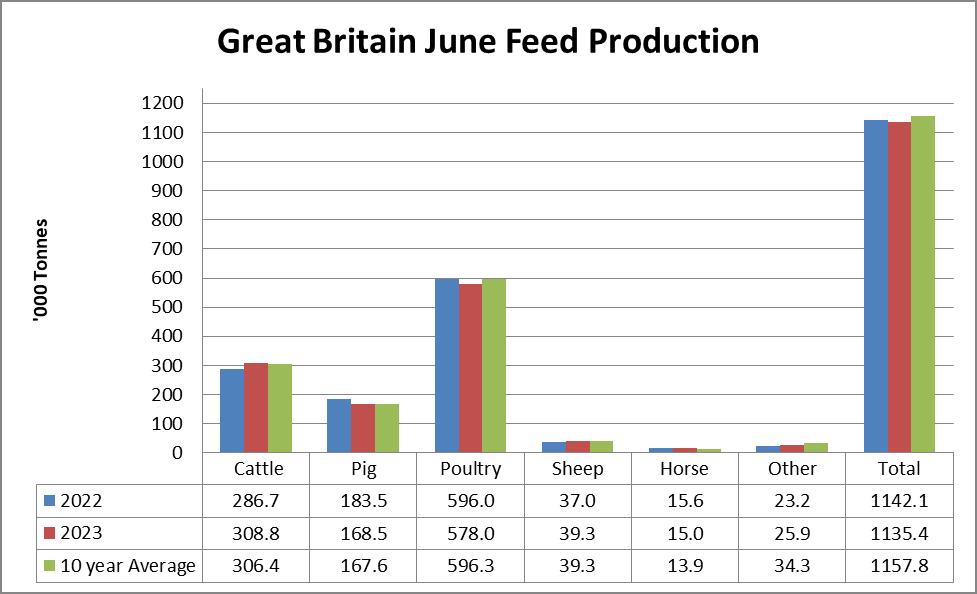
At 578,000 tonnes of output, total poultry feed was at its lowest June level since 2015 and was 18,000 tonnes or 3.0 per cent down on the return from the corresponding month a year previously. The current production was lower than all but two totals from the past decade and dropped 18,300 tonnes or 3.1 per cent below the decade long average for the month.
In contrast with the sector itself, both the poultry rearing and breeding compounds and turkey compounds subsectors bettered their respective year previous returns. The former did so by 1,000 tonnes or 3.6 per cent up to 28,900 tonnes and the latter by 800 tonnes or 16.0 per cent up to 5,800 tonnes, following two successive year-on-year declines. On the other hand, output of broiler feed compounds fell by 28,000 tonnes or 13.5 per cent to 180,100 tonnes, its lowest level for June since 2016. In addition, a 7,500 tonnes or 7.2 per cent decline in production of layer compounds brought output down to 96,600 tonnes, the lowest for the category since 2017. Finally, output of chick rearing compounds decreased by a more moderate 100 tonnes or 0.8 per cent to 11,900 tonnes.
Total cattle and calf feed production surpassed its year previous
counterpart by 22,100 tonnes or 7.7 per cent and rose to 308,800 tonnes, its second highest total of the past 5 years for the timeframe. In addition, 2023’s total was 3,330 tonnes or 1.1 per cent in excess of the 10 year average for June.
All cattle and calf feed elements outpaced their corresponding year previous returns. The standout figure from the sector was the 8,500 tonnes or 5.0 per cent rise in the output of compounds for dairy cows up to 177,900 tonnes, its highest return for June since 1995. Production of blends for dairy cows rose considerably from its 2022 return to 56,900 tonnes, an increase of 6,800 tonnes or 13.6 per cent. All other cattle compounds surpassed its year earlier counterpart by 1,800 tonnes or 5.5 per cent, however, the output of 34,500 tonnes was the second lowest for the month since 2002. Having fallen steeply for the past two Junes, production of all other cattle blends rose by a considerable 3,600 tonnes or 20.1 per cent to 21,500 tonnes; cattle protein concentrates followed the same pattern and bettered its year previous return by 500 tonnes or 9.3 per cent with an output of 5,900 tonnes. Total calf feed output for June in 2023 arrested a sequence of three consecutive year-on-year downturns as it grew by 900 tonnes or 8.0 per cent from a year earlier to 12,100 tonnes.
For the thirteenth calendar month in succession, total pig feed had decreased below its corresponding year earlier total, in this case, by 15,000 tonnes or 8.2 per cent to 168,500 tonnes. However, due to considerably lower outputs from the first half of the preceding decade, the current total was more or less in line with the 10 year average for the month, being just 100 tonnes or 0.1 per cent higher.
Not only were all pig feed subsectors down on their outputs from the corresponding month a year previous but three were at their lowest level for June since records were kept in their current form. Production of pig protein concentrates had halved from 2022 levels to 200 tonnes; pig starter and creep feed output had dropped by 500 tonnes or 10.6 per cent from a year earlier to 4,200 tonnes; and pig growing compounds production declined by 4,500 tonnes or 14.9 per cent to 25,700 tonnes. Additionally, pig finishing compounds fell by a notable 8,700 tonnes or 8.7 per cent from the record high for June from a year previous to 91,400 tonnes. Production of both link and early grower feed and pig breeding compounds fell by less substantial totals; the former did so by 500 tonnes or 4.8 per cent down to 9,800 tonnes and the latter by 500 tonnes or 1.3 per cent to 37,300 tonnes.
Following two year-on-year declines in output, total sheep feed production for June increased by 2,300 tonnes or 6.2 per cent from a year earlier to 39,300 tonnes. Moreover, the total under review outstripped the decade long average for the month by 300 tonnes or 0.8 per cent.
Blends for breeding sheep output remained at the same level as it was at in the period under review a year previously of 1,000 tonnes, whereas production of blends for growing and finishing sheep surpassed its 2022 return by 1,300 tonnes or 28.3 per cent and grew to 5,900 tonnes, a record for June. In contrast, compounds for breeding sheep were at their lowest total for June since 2002 of 2,800 tonnes, 900 tonnes or 24.3 per cent down on a year earlier. At 29,200 tonnes,
page 4 September/OctOber 2023 Feed Compounder Comment section is sponsored by Compound Feed Engineering Ltd www.cfegroup.com
UK & IRELAND PREMIER SUPPLIER
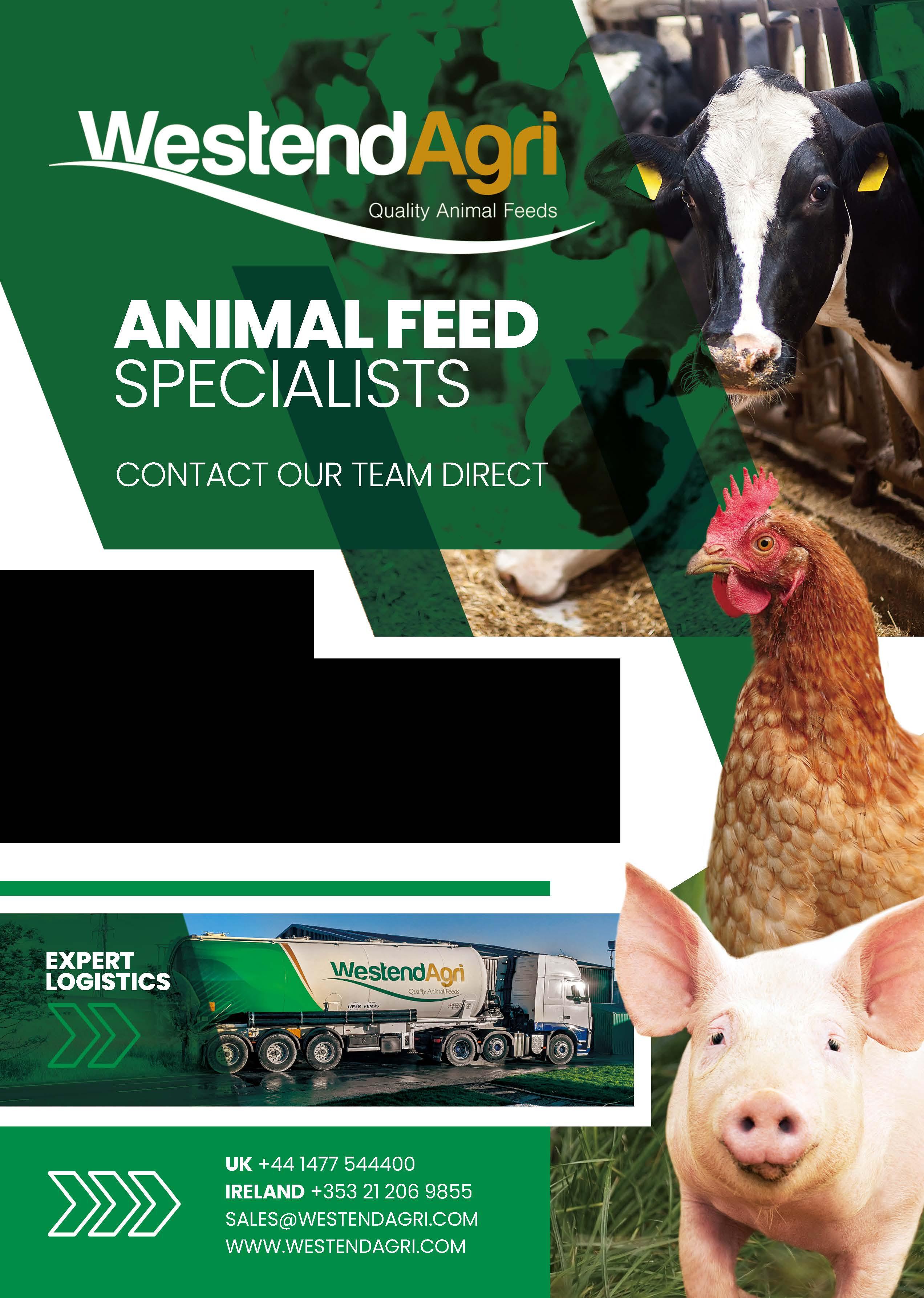
- Feed Phosphates

- Feed Grade Urea
- Sodium Bicarbonate
- Oyster Shell Grits
- Magnesium Oxide
- Emulsifiers

- Caustic Soda Pearl
- Cubicle Liners
- Protected Fats
compounds for growing and finishing sheep had increased from the corresponding month a year previously by 2,000 tonnes or 7.4 per cent and sheep protein concentrates had bettered their 2022 output by 100 tonnes or 25.0 per cent, rising to 500 tonnes or output.
June total horse feed production had declined by 600 tonnes or 3.8 per cent from its level a year earlier to 15,000 tonnes. Despite this drop, the current output was 700 tonnes or 4.8 per cent greater than the decade long average for the month.
A rise of 2,700 tonnes or 11.6 per cent from a year previous brought June total other feed production up to 25,900 tonnes. However, the total under review was nevertheless a considerable 8,400 tonnes or 27.9 per cent below the 10 year average for June.
Second Quarter Overview
Total production of compounds, blends and concentrates, including integrated poultry units, during the second quarter of 2023 in Great Britain dropped below its year earlier counterpart for the second year in succession. The output under review, of 3,120,400 tonnes, was 134,300 tonnes or 4.1 per cent lower than in 2022. Furthermore, the current total was 147,600 tonnes or 4.6 per cent lower than the decade long average for the period.
Total feed production during the second quarter of 2023 was made up of: 47.1 per cent poultry feed, 29.5 per cent cattle and calf feed, 14.5 per cent pig feed, 5.1 per cent sheep feed, 1.5 per cent horse feed and 2.3 per cent other feed.
Total second quarter poultry feed was at its lowest level for the timeframe since 2012, a decrease from a year previous of 93,300 tonnes or 6.0 per cent brought output down to 1,471,000 tonnes for Q2. The current total was also a similar 96,600 tonnes or 6.4 per cent below the 10 year average for the quarter.
At 921,000 tonnes, total cattle and calf feed production surpassed its year earlier total by 20,300 tonnes or 2.1 per cent. However, despite this increase, the total under review was still 6,400 tonnes or 0.7 per cent lower than the decade long second quarter average.
A sizeable decline from the corresponding period a year previous of 54,400 tonnes or 11.0 per cent brought total second quarter pig feed production down to 452,000 tonnes, its lowest total for the period since 2018. Moreover, 2023’s total was 11,300 tonnes or 2.5 per cent down on the 10 year average for the timeframe.
For the second year in succession, total sheep feed output for Q2

failed to match its year previous level. At 158,300 tonnes, the production under review was 6,200 tonnes or 3.2 per cent down on that of 2022 and additionally, was 15,600 tonnes or 9.4 per cent lower than the second quarter average for the past decade.
Total Q2 horse feed production had dipped below the record high level amassed for the timeframe a year earlier, doing so by 2,700 tonnes or 5.7 per cent down to 45,800 tonnes. However, this was the fourth highest total for the period on record and as a result, the production under review was 3,200 tonnes or 7.2 per cent in excess of the 10 year average for the quarter.
At 72,500 tonnes, total other feed production was only the second sector to better its year previous output. It surpassed 2022’s total of 2,500 tonnes or 2.8 per cent. Despite this upturn, the current return was the second lowest for the timeframe since 2006 and was therefore a considerable 19,500 tonnes or 23.7 per cent down on the 10 year average for Q2.
Production was markedly down across the majority of species in the second quarter and even in both cases where production was greater than a year previous, outputs were lower than the long term average for the period. With the release of the Q2 figures, production from the first half of the year is available to analyse and this is done below.
Half-Year Production
Total production of compounds, blends and concentrates, including integrated poultry units, during the first half of 2023 had decreased by 420,400 tonnes or 6.1 per cent from the corresponding period a year earlier to 6,460,400 tonnes. Production from the period was at its lowest level since 2012 and in addition, was 3981,100 tonnes or 6.0 per cent lower than the average for the timeframe over the past decade.
Total feed production during the first of 2023 was made up of: 44.6 per cent poultry feed, 30.4 per cent cattle and calf feed, 14.0 per cent pig feed, 7.3 per cent sheep feed, 1.6 per cent horse feed and 2.0 per cent other feed.
For the first time in seven years, total poultry feed production for the first half of a year had dropped below three million tonnes of output. The current output, of 2,882,900, was 204,500 tonnes or 6.6 per cent down on its year previous total. Furthermore, 2023’s H1 return was 193,100 tonnes or 6.5 per cent down on the 10 year average for the period under review.
Production from all poultry feed subsectors was below that of the corresponding timeframe a year previously. Integrated poultry unit output was at its second lowest first-half level since records were kept in their current form of 1,029,700 tonnes, 41,300 tonnes 3.9 per cent less than a year previous. Similarly, turkey feed output for the first half of 2023 was at its lowest level on record of 28,900 tonnes, down 4,000 tonnes or 10.3 per cent from a year earlier. Layer feed production in the timeframe had declined for the third year in succession, in this case by 55,800 tonnes or 9.5 per cent to 516,900 tonnes; the output of poultry breeding and rearing feed decreased by 9,200 tonnes or 5.1 per cent to 150,900 tonnes. Finally, broiler chicken feed and chick rearing feed
page 6 September/OctOber 2023 Feed Compounder Comment section is sponsored by Compound Feed Engineering Ltd www.cfegroup.com
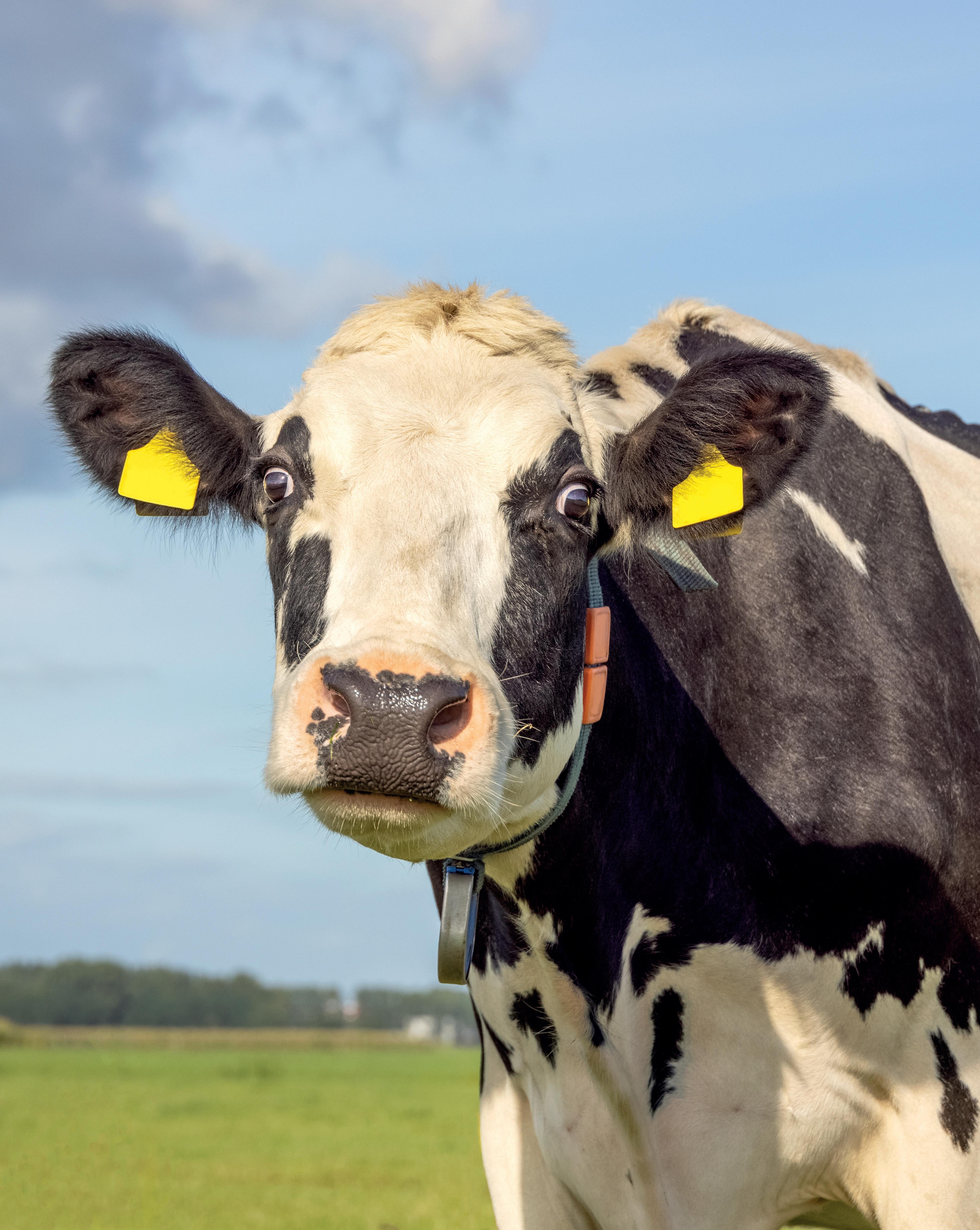
production both fell by 8.8 per cent from the first half levels from a year previous, the former decreased by 103,300 tonnes down to 979,100 tonnes, its lowest total in seven years, and the latter by 7,100 tonnes to 61,000 tonnes.
Total cattle and calf feed production during the first half of 2023 was closely aligned with that of its 2022 counterpart. The output under review of 1,967,000 tonnes was 3,100 tonnes or 0.1 per cent lower than a year earlier. The current total was a more significant 71,100 tonnes or 3.6 per cent below the decade long average for the period.
Despite the overall downturn in production, output from the largest cattle and calf feed category, dairy cow compounds, was up 18,900 tonnes or 1.8 per cent to 1,047,100 tonnes. Following a sharp decline in first-half output a year previously, blends for dairy cow production also surpassed its 2022 return by 29,000 tonnes or 6.8 per cent, up to 396,900 tonnes. In contrast, all other cattle feed declined from a year earlier by 26,300 tonnes or 9.1 per cent to its lowest level on record for the timeframe of 256,900 tonnes. All other cattle blends output for H1 also fell sharply from a year previous, down 16,900 tonnes or 10.0 per cent to 137,700 tonnes. Production of all calf feed was at its lowest level for the first half of a calendar year since 2011; the 83,100 tonnes or output was 6,500 tonnes or 6.5 per cent below that of a year earlier. Lastly, protein concentrates for cattle and calves production fell by 1,300 tonnes or 2.7 per cent to 45,400 tonnes.
Having risen year on year for the five years, total first half pig feed production was 149,700 tonnes or 14.9 per cent down on a year earlier at 904,700 tonnes. Furthermore, the total under review was 32,400 tonnes or 3.5 per cent under the decade long average for H1.
All pig feed subsectors dropped significantly from their respective returns of a year previous. Most notably, first-half pig growing feed production decreased 38,100 tonnes or 20.4 per cent to its lowest level for the period on record of 132,900 tonnes. Production of pig starters and creep feed and pig protein concentrates were both also at their lowest H1 outputs since records were kept in their current form, dropping below their year previous counterparts by 3,800 tonnes or 14.3 per cent to 20,800 tonnes and 900 tonnes or 32.1 per cent to 1,400 tonnes respectively. Pig finishing feed output fell a marked 86,300 tonnes or 17.0 per cent from the unmatched total for the period in 2022 to 498,100 tonnes; this was, however, the third highest first-half output for the subsector on record. At 202,400 tonnes, pig breeding feed was at its lowest H1 output since 2018, down 15,800 tonnes or 7.0 per cent
from a year previous and lastly, pig link and early grower feed had fallen by 4,900 tonnes or 9.3 per cent to 49,200 tonnes.
A decline in first-half output of 41,600 tonnes or 7.3 per cent brought total sheep feed production to 473,500 tonnes, its lowest total for the timeframe since 2005. The current output was an even greater 56,600 tonnes or 11.3 per cent lower than the 10 year average for the first half of the year.
Despite this downturn, blends for growing and finishing sheep, at 32,200 tonnes and protein concentrates for sheep and lambs, at 3,200 tonnes had both surpassed their year previous counterparts, doing so by 2,200 tonnes or 6.6 per cent and 300 tonnes or 7.7 per cent respectively. In contrast, first-half production of blends for breeding sheep had decreased by over a quarter to 14,400 tonnes, the lowest total for the period on record and 6,800 tonnes or 29.8 per cent down on 2022. Compounds for breeding sheep production were also at its lowest level for the timeframe under review; it had fallen 25,600 tonnes or 9.9 per cent to 192,800 tonnes of output. The sector’s largest element, compounds for growing and finishing sheep, at 230,900 tonnes of production in the first half of 2023, was 11,700 tonnes or 4.7 per cent down on a year previous.
Total H1 horse feed production, at 103,400 tonnes, had decreased from a year earlier by 4,800 tonnes or 4.4 per cent. Nevertheless, this was the fifth highest total for the month on record and as such, outpaced the decade long first-half average by 5,300 tonnes or 5.3 per cent.
A fifth successive, year-on-year decline in total other feed output from the first 6 months of a calendar year dropped production to its lowest level since 1995 of 129,100 tonnes. This was 16,100 tonnes or 9.5 per cent down on a year previous and an even more notable 47,300 tonnes or 31.0 per cent lower than the 10 year H1 average.
Total production from every month comprising the first half of 2023 was below that of its year earlier counterpart demonstrating a consistent drop-off in feed production in the year to date. Outputs from all sectors were also lower than their year previous returns and only in the horse feed sector was production greater than the long term average. Its appears that Great British animal feed production is on course for its lowest return for a decade if there is no change in trend during the second half of 2023.

NORTHERN IRELAND Monthly Production Update – May
Total production of compounds, blends and concentrates during May 2023 in Northern Ireland surpassed its year earlier return by a considerable 19,500 tonnes or 10.3 per cent to 209,000 tonnes. This was the second highest May total on record, only below the output of 2018, and as such, was 20,500 tonnes or 10.9 per cent in excess of the decade long average for the month.
Total feed production during May 2023 was made up of: 50.1 per cent cattle and calf feed, 36.4 per cent poultry feed, 9.0 per cent pig feed, 1.9 per cent sheep feed and 2.5 per cent other feed.
An increase of 10,100 tonnes or 10.7 per cent from a year previous brought May cattle and calf feed production up to 104,800 tonnes, its
page 8 September/OctOber 2023 Feed Compounder Comment section is sponsored by Compound Feed Engineering Ltd www.cfegroup.com
BEYOND NUTRITION, THINK FUNCTION!
Inneus® is the first solution highlighting the functionality of amino acids for animal nutrition in European Union.
Inneus® is part of the new Metex Animal Nutrition solutions, dedicated to intestinal health and welfare.
Several scientific trials have shown the ability of Inneus® solutions to enhance piglets or birds’ resilience against various physiological and sanitary challenges.

metexanimalnutrition.com Tailored for animal, inspired by nature

Inneus_multispecies_ADhp_Eng_202302
highest level since 2018 and the third highest since records were kept in their current form. Additionally, the output under review outpaced the 10 year average for May by 11,800 tonnes or 12.7 per cent.

In contrast with the sector as a whole, production of beef coarse mixes or blends fell 700 tonnes or 4.4 per cent below its year previous counterpart. All other cattle compounds and protein concentrates for cattle and calf were both at the same outputs as a year previous at 300 tonnes and 100 tonnes of production respectively. The remaining subsectors all bettered their respective returns. The sector’s largest element, dairy cow compounds had increased to record high output for the month of 55,300 tonnes, surpassing its year earlier total by 5,100 tonnes or 10.2 per cent. Other calf compounds, at 6,200 tonnes of output, was also at an unrivalled production total for the month of May, bettering its year previous return by 1,200 tonnes or 23.2 per cent. Production of dairy coarse mixes or blends had risen by 3,900 tonnes or 26.0 per cent from its 2022 return for May to 18,800 tonnes, the second highest total for the month on record. Lastly, beef cattle compounds output grew by 700 tonnes or 8.1 per cent to 9,200 tonnes.
At 76,000 tonnes, total May poultry feed had surpassed its year previous return by 10,100 tonnes or 15.4 per cent, rising to its second highest total on record. 2023’s output was also in excess of the decade long average for May which it bettered by 8,000 tonnes or 11.8 per cent
Turkey and other poultry feed production during the May of 2023 rose considerably from the corresponding period a year previously. The 2,500 tonnes of output from the period was 1,600 tonnes or 195.0 per


cent greater than the all-time low posted in the corresponding month of 2022. Broiler feed and chick rearing feed both also markedly surpassed their year previous counterparts: the former did so by 8,500 tonnes or 24.8 per cent up to 42,800 tonnes and the latter by 500 tonnes or 24.8 per cent to 2,600 tonnes. Finally, layer and breeder feed production declined by 500 tonnes or 1.8 per cent from a year earlier to 28,100 tonnes.
Total pig feed was the only sector in May where production fell below that of a year earlier, doing so by 1,700 tonnes or 8.2 per cent to 18,900 tonnes. This was the lowest total for the month since 2018 and yet, due to the considerably lower output from the first half of the past decade, the current total surpassed the 10 year average by 800 tonnes or 4.2 per cent.
Production from all pig feed sectors fell below their year earlier counterparts. A decrease in output of 800 tonnes or 9.1 per cent from the record high of a year previous brought pig finishing feed production down to 7,900 tonnes; pig starter and creep feed production fell from a year earlier by the same proportion, 9.1 per or 200 tonnes to 2,100 tonnes. Pig link and early grower feed and pig growing feed both declined from their respective 2022 returns by 300 tonnes, the former to 2,800 tonnes, down by 10.5 per cent and the latter to 3,500 tonnes, down by 7.0 per cent. Lastly, pig breeding feed output for May fell for the second year in succession, in this case, by 100 tonnes or 3.3 per cent to 2,600 tonnes.

After a significant fall in output a year previously, May total sheep feed production rose 700 tonnes or 20.9 per cent to 4,000 tonnes. This increase brought the total under review to the same level as the decade long average for the month. Production of breeding sheep compounds for sheep, having halved a year previously, had grown by 200 tonnes or 31.3 per cent to 600 tonnes of output.
Production of coarse mixes or blends for sheep remained at the same level as it has been at for the past four Mays at 800 tonnes, whereas growing and finishing compounds for sheep rose by 500 tonnes from a year previous to its second highest total for the month on record of 2,600 tonnes, a sizeable increase of 24.6 per cent.
At 5,300 tonnes of output, total other feed production had surpassed its corresponding year earlier return by 200 tonnes or 4.8 per cent. However, the current output was still 100 tonnes or 1.5 per cent lower than the 10 year average for May, thanks, in large part, to the anomalously high return of 2019.
page 10 September/OctOber 2023 Feed Compounder Comment
Compound
Engineering Ltd www.cfegroup.com
section is sponsored by
Feed
NAME OF THE VETERINARY MEDICINAL PRODUCT: FLUBENMIX 5%, 50 mg/g Premix for Medicated Feeding Stuff. ACTIVE INGREDIENT: Flubendazole 50mg. Legal Category: POM-VPS , Vm 43877/4013. Drug premixes for animal feed. For animal treatment only. To be supplied only on veterinary prescription. Administration by a veterinary surgeon or under their supervision. Target species: Pigs, chickens, turkeys, geese, partridges and pheasants. CONTRAINDICATIONS: Do not use in cases of hypersensitivity to the active substance or to any of the excipients. WITHDRAWAL PERIOD(S): Meat and offal: pigs: 3 days, chickens: 5 days, turkeys, geese, pheasants and partridges: 7 days. Chicken eggs: 0 days. Not for use in other poultry laying eggs for human consumption.

















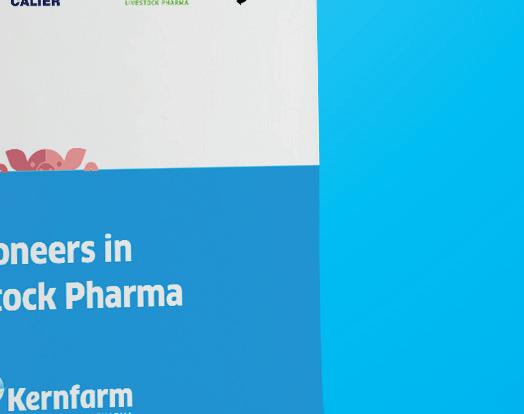

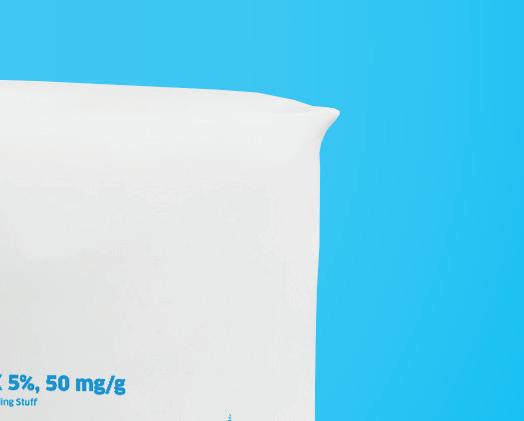
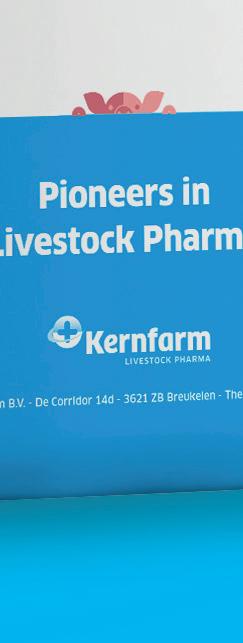











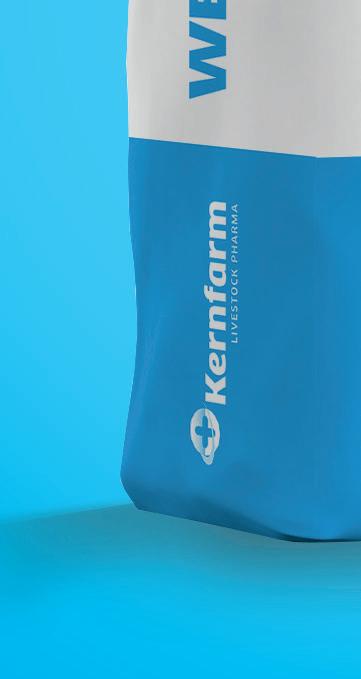







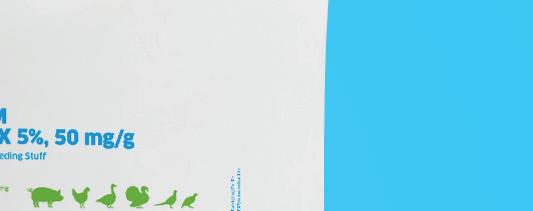











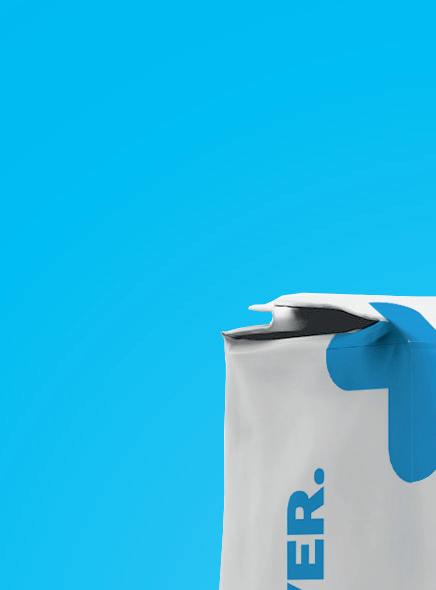


















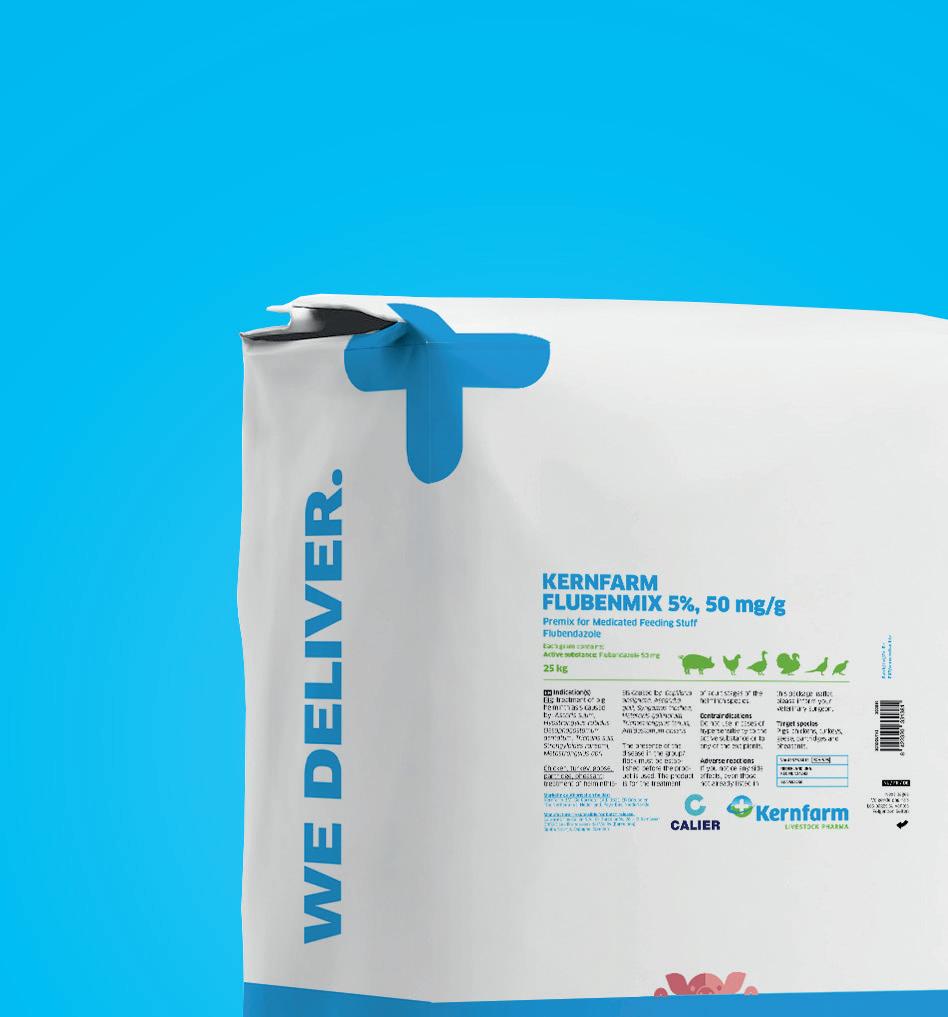
AUTHORISATION HOLDER:
3621 ZB Breukelen, The Netherlands. Use Medicines Responsibly. Advice should be sought from prescriber. Further information is available from the SPC or contact Kernfarm B.V. info@kernfarm.com, www.kernfarm.com. Date advert designed: feb 2023.
your local wholesaler!
5%, 50mg/g
YOUR TRUSTED
formula
PRODUCT
MARKETING
Kernfarm B.V. De Corridor 14D,
IT’S ALL IN Check
KERNFARM FLUBENMIX
THE MIX
Flubendazole
ONE
PRICED
For pigs, poultry and game birds WELL
Need a dewormer? Refresh yourself. Your ubendazole premix alternative is already here. MORE INFO? SEE KERNFARM.COM OR SCAN QR CODE
Always available
Ten Ways … to make a difference
 By Robert Ashton
By Robert Ashton
We all want to do good and many aspire to leave the world a better place, but where do you draw the line between out and out altruism and self-interest? Making sure we have enough money to live comfortably and realise personal ambitions has to be our priority, and some seek public office only because it creates opportunities to influence decisions that can impact on their personal prosperity. Can one really justify acting in ways that improve your lot, because you are also improving the lot of others?
Others are motivated by religious fervour to make seemingly huge personal sacrifices for the benefit of others. While their behaviour is commendable, it can make them impossibly smug and immune to constructive feedback, because they believe that their actions are divinely inspired. It can somehow seem that the more they sacrifice the better they feel. How can that be sensible?
I’ve been reflecting on the motivation for doing good, because in the last few months, since moving to the Suffolk coast, I have found myself taking on three trustee roles: one with a steam museum and two with Quaker charities. I know that I have experience, expertise and contacts able to help all three over the hurdles they face, and now I am wholly focused on being a writer, they give me useful opportunities to use hard learned skills from my former life. Here then are ten ways I think you might choose make a difference to the lives of others:
1. Plant golden seeds – The management writer Charles Handy once told me that when someone who has no personal interest in you says you’re doing a great job, it has far more impact than if it comes from your mum, partner or boss. Taking the time to tell someone they’re doing well takes little effort, but can make all the difference to their motivation.
2. Become a trustee – I’ve had many trustee roles over the years, and have found them really useful when running my own business as they taught me a lot about HR and financial management. Don’t wait until you’re old to consider becoming a trustee, but recognise that you are trading your expertise and network for useful business experience you might not otherwise gain.
3. Pick up litter – There is evidence that suggests that keeping the place neat and tidy reduces littering, graffiti and vandalism. Don’t do what I once did and pick up what someone’s just discarded and hand it back to them. That’s unnecessarily provocative and might earn you a black eye. But picking up litter is a behaviour others will often copy, so why not start a trend in your neighbourhood?
4. Sponsor someone – I’m sure that like me, every week brings you invitations to sponsor someone’s run, or help fund medical
treatment for a seriously ill child. Unless it’s someone close to me, I tend to pass on these and instead support community share issues where I know the result will be a community owned business that can deliver lasting impact. But that’s my preference and yours might be different. Sponsoring encourages innovation, can be tax efficient and is catching too!
5. Think and act ‘green’ – One of the problems with our quest to achieve ‘net-zero’ is that those best able to change policy and practice will be dead long before the impact of doing nothing is felt. However, if everyone takes a few steps in the right direction, the world will move a lot closer to becoming environmentally sustainable. Do your bit.
6. Mentor a vulnerable adult – I can tell you from experience that there’s nothing that makes you feel more grateful for what you have, than to mentor a recently released offender as he rebuilds his life after a long prison sentence. It’s also gratifying to be able to help them practically as they prepare for job interviews and fill in forms to claim benefits or find a place to live. Who could you mentor?
7. Challenge a bully – It takes courage to challenge someone who’s being anti-social and often they’re under the influence of drink or drugs, so there’s a real chance of being physically attacked. Rather than tackle someone on your own, invite other by-standers to join you in stepping in. Be prepared to offer support if their aggression turns into tears, or to back off if you no longer feel safe.
8. Speak to that person looking depressed on the platform edge – Asking if someone is OK costs nothing, and might just save a life. 99 people in 100 who look sad are just that: sad. But one in a hundred might be feeling desperate enough to act irrationally. I’m always mindful of the phrase that ‘suicide is a permanent solution to a temporary problem.’ On a lighter note, I’ve long been a fan of conversations with strangers, for example when you find yourselves sitting together on a train on in a waiting room.
9. Volunteer – There are a million ways to volunteer, and only you will know if the way you choose makes a difference. My experience has often been to challenge the assumptions about what volunteers are being asked to do, which isn’t always what’s needed! Volunteering can be good whatever your age, background of job. Play the field and don’t say yes to the first opportunity, unless sure it’s right for you, and the organisation.
10. Doing something usually beats doing nothing – Activity always wins over inertia and doing something, even if not quite the right thing gets you closer to making the difference you want in the world. Doing something is a good place to start!
When you become receptive to the idea of getting involved with things and trying to make life better for others, it’s really important to not overcommit and to say no to things that don’t feel right, or don’t fit with your work or home life. You cannot help others if in doing so, you harm yourself.
page 12 September/OctOber 2023 Feed Compounder Comment section is sponsored by Compound Feed Engineering Ltd www.cfegroup.com
COREmill has been built on 40 years of experience in the Milling Industry; we have designed our software around the specific challenges of the milling & grain industry.
Providing agritech solutions for over 40 years, helping clients to innovate, grow and adapt to change.
COREmill manages 50% of all Irish grain intake
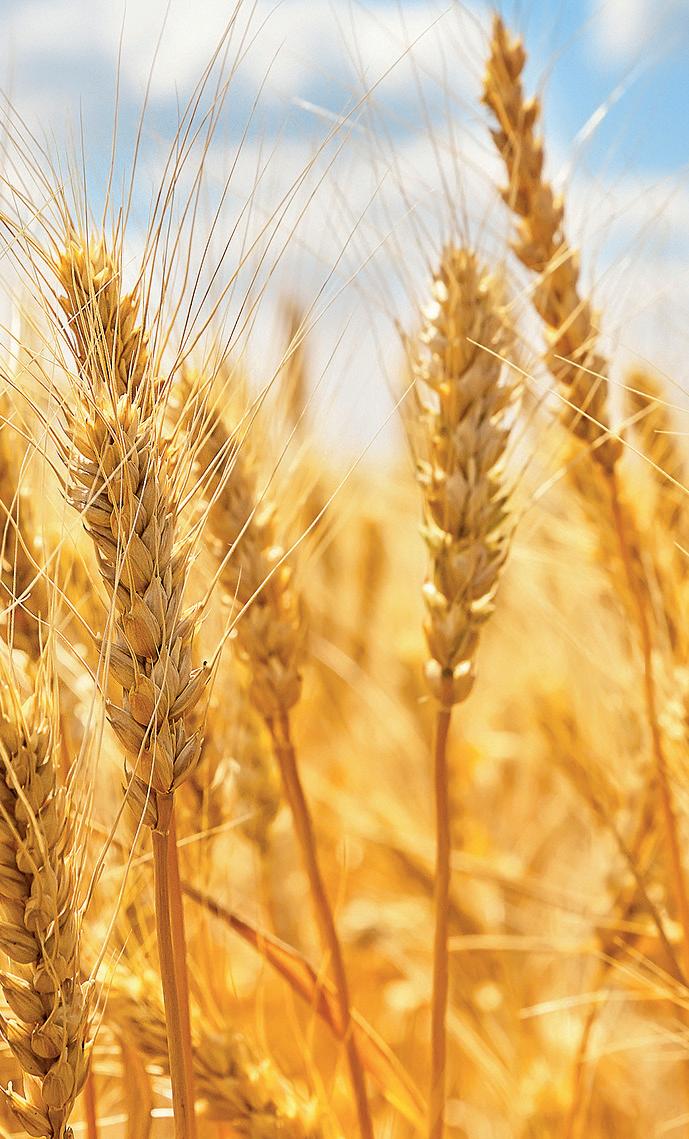
T : +353 25 41400
E : info@coretechnology.ie
W : coretechnology.ie
COREmill is trusted by 40% of feed compounders in Ireland
View From Europe
By Colin Ley
Europe goes big on sustainability
Meat production is no longer a simple process of feeding livestock, slaughtering, and processing at the right stage of growth, and putting a quality product on the consumer’s plate.
Today’s farm-to-plate chain must also be transparently sustainable, in every sense of the word. Views will differ on the validity of this requirement but it’s probably more beneficial to focus on how our industry can best contribute to the demands surrounding modern meat production than debating how we reached this point in the first place. For better or worse, the sustainability argument has moved on, so let’s concentrate of what lies ahead.
In this context, I really enjoyed the comment made recently by Hsin Haung, Chair of the Food and Agriculture Organization (FAO) Livestock Environmental Assessment and Performance (LEAP) Steering Committee.
Seeking to encourage farmers and support industries to inform politicians (Ministry of Agriculture, Ministry of the Environment, Ministry of Health, etc.) of the many contributions that livestock production makes toward a sustainable food system, he said: “A food system cannot be sustainable without livestock.”
With so many arguing that meat production is bad for the environment, even bad for our health, it is reassuring to have someone who actually knows what he’s talking about and speaking in such positive terms about the role of livestock in today’s sustainable food chain.
“On current trends, it is clear is that we need to produce more food,” said Mr Haung, speaking primarily in his other role as secretary general of the International Meat Secretariat (IMS). “As the global population continues to grow, more livestock products are needed, particularly in countries where people currently don’t even have enough to meet basic nutritional requirements.
“Nearly 1 billion people are still under nourished. Livestock production, however, is a pillar of livelihood, rural development, and culture in numerous countries. Providing nutritious food in a sustainable and equitable manner will be a significant challenge, to which our livestock industries are well positioned to respond. Livestock can significantly contribute to the delivery of the UN’s Sustainable Development Goals.”
While acknowledging that it has become very difficult to have a balanced discussion on livestock in 2023, he urged all involved in the meat-based food chain to engage the public in a two-way discussion to better explain our industry’s current complexities. Maybe then we could reach a position of shared understanding.
Livestock production systems, he added, have been on a continuous journey of improvement, including embracing a culture of improving sustainability.

IMS, which is a Paris-based nonprofit organisation representing the
meat industry, is currently participating in a three-year cycle (2022-2024) of international cooperation which includes the upcycling of agricultural products that cannot be consumed by humans. This features the conversion of such items into ‘valuable and nutritive’ food, alongside the reusing and recycling of waste and residues which also contribute to agrifood systems that are both sustainable and efficient.
Positive input from Mr Haung, who will be expanding on his ideas during an IMS-backed Livestock Supply Chain Connect event in London on September 20-21.
International Year of Millets 2023
Providing livestock producers with ready and reliable supplies of compound feed is a crucial part of the sustainability story. Having access to ready and reliable sources of raw materials is essential, of course, in getting us all to the starting line of feed production, especially in a world where the growing of traditional grains is subject to an increasing climatic challenge.
In this context, it would be remiss to allow the International Year of Millets 2023, as designated by the Food and Agricultural Organization (FAO), to pass without appropriate mention. Millets, after all, have shown themselves to be equipped to grow on arid lands with minimal inputs and to be resilient to changes in climate. They are therefore an ideal solution for countries to increase self-sufficiency and reduce reliance on imported cereals.
These are not my words but those used by FAO to express the hope that millets will be given a wider production platform in the future, rather than being consigned solely to their Africa/Asia history, valuable as that is. With the conventional production of cereals across Europe often coming under severe temperature and water pressures, all possible alternatives need to be explored. That definitely includes millets which are viewed (by some anyway) as being able to grow twice as fast as wheat, while consuming 70% less water than rice.
Facts like these always need investigation, so we should treat such headline figures with a degree of caution. The core message, however, is that millets represent a potential solution to future production demands and clearly warrant our attention.
It’s also worth remembering that FAO previously declared 2013 as the International Year of Quinoa, a focus which has certainly raised the prominence of that crop during the last decade. Hopefully, the Organization’s current attention will do the same for millets, potentially increasing the impact of the crop in its traditional African and Asian heartlands while also making it a more commercial human and animal feed alternative across Europe and the rest of the world.
Research and development response
Responding to FAO’s 2023 focus on millets, the Italy-based gluten-free diet and nutritional needs business, Dr Schär, recently stated that 40% of the world’s plant species are at risk of extinction. This, they added, is due to rapid climate change, drought, deforestation, urbanisation, pollution, and intensive monoculture.
“Europe is currently suffering from increasingly critical climatic conditions,” said Ombretta Polenghi, Director of Global Research & Innovation at Dr Schär, speaking as an introduction to promoting a company project called VItaMì (Varietà Italiane di Miglio) which is centred
page 14 September/OctOber 2023 Feed Compounder Comment section is sponsored by Compound Feed Engineering Ltd www.cfegroup.com
on the development of new millet varieties with improved (it is claimed) agronomic, technological and nutritional characteristics.
Since launching in 2020 with the first implementation of crosses between selected millet varieties, VItaMì has embraced greenhouse cultivations of around 6,000 millet lines. These were drawn from four different crosses and have led to the selection of 1,000 plants for further field-based development.
Following the project’s first field trials in 2022, and the initial selection of the best lines that emerged, the innovation team at Dr Schär has committed itself to delivering ‘top varieties to trusted partners by 2025’, with the aim of commercial seed supplies being ready for release by 2026.
I’m sure there are other developers out there doing equally valuable breeding and development work, of course, so excuse me for not mentioning you by name. Instead of complaining at being overlooked, however, just make sure you get your message out there.
EU returns to action
Having focused attention in my previous column on the extended holiday enjoyed by the European Commission (EC) in August, it seems only fair to give a mention to the hosting of an agriculture-based ministerial meeting by the Spanish Presidency (of the EC) at the beginning of September.
Due to be held at the Palacio de Congresos of Córdoba (shortly after Feed Compounder went to press) the agenda focus was set to be placed on the search for innovative solutions and the use of new technologies to make agriculture more sustainable and competitive in the face of climate change and its consequences.
Working sessions were planned to discuss how to address growing global food insecurity caused by climate change, economic crises and conflicts, challenges which are seen as ‘seriously jeopardising the goal of eradicating hunger and malnutrition, as comprised in the 2030 Sustainable Development Strategy’.
Also on the table for discussion was a legislative proposal concerning plant varieties produced using new genomic techniques (NGTs). This is one of key measures being pursued by the Spanish Presidency before its term of office concludes at the end of December.
According to the Spanish plan, NGTs will make it possible to develop plant varieties which are better adapted to the new conditions derived from climate change, especially those related to drought. The aim is to develop seeds and plants resistant to pests and diseases and to use fewer natural resources, less fertiliser and fewer plant protection products. The result being sought is more sustainable and profitable production for farmers.
If this plan works as envisaged, the proposed new legal framework will allow NGTs to be used in breeding ‘more resilient varieties in a shorter period of time and at lower cost than current methods’. It is also seen as helping transition the EC towards a ‘more sustainable, productive and climate change-adapted model, which will also reduce the EU’s dependency on imports in the face of unstable political scenarios’.
This sounds like Spain’s Presidency team is fully refreshed after its holiday and has returned to work with a determination to make the most of its remaining four months in charge.
Bug splats
One of the more interesting press notes to reach me in recent days
was centred on the exploits of pilots as Essex and Suffolk Gliding Club who had noticed an increasing number of bug splats on glider wings. Not immediately relevant to feed compounding you may say, but stay with me.
For effective gliding, apparently, you need clean wings, not ones covered in bug splats. Faced with the task of extra cleaning this summer, therefore, the Essex and Suffolk pilots decided to ask their local wildlife trust what was happening. This led to the launch of a new bug splat counting project which could ultimately impact crop production efficiency across the UK.
Gathering details of what bugs are out there, both at ground level and in the air, is helping wildlife specialists track changing pollinating insect numbers, whose survival and choice of location can have a significant influence on plant and crop production.
The risk is that as insect populations change, due to new weather patterns or land use developments, some species may disappear, resulting in gaps being created in beneficial insect communities. This could be detrimental to the control of aphids on growing crops.
When everything is in balance, our current insect populations complement each other in the jobs they do, working together to both pollinate plants and protect crops. In dealing with aphids, for example, ladybirds feed on the top of a crop, where aphids typically settle. As protective measure, however, aphids quite often drop to ground level to avoid ladybirds, at which point ground beetles take over and eat the aphids off the ground.
According to Dr Lorna Cole, an agricultural ecologist with SAC Consulting in Scotland, changes are taking place and it’s vital to keep track of what these are, and which insects are being affected. She’s running a study in Ayrshire with the Scottish Wildlife Trust which includes farmers in the development of a so-called ’superhighway’ of nectar and pollen-rich sites for wild pollinators.
“We are certainly seeing changes in insect populations due to climate change with some species moving up the country in recent times,” she told me. “Regular monitoring of such changes is important, especially to raise awareness of any new pests that may emerge or other adjustments in the current spread of species.”
She’s also encouraging farmers to take a little extra time to improve wildlife habitats on their land to give surviving insects the best possible chance to help with crop production and aphid consumption.
Invasive species
Still with insects, a major report on the rapidly growing threat that invasive alien species pose to biodiversity, ecosystem services, sustainable development and human well-being was due to be published in early September. Not available when Feed Compounder went to press, the report will definitely be worth finding.
Produced by the Intergovernmental Platform on Biodiversity and Ecosystem Services (IPBES), the report is called ‘Assessment Report on Invasive Alien Species and their Control’. Resulting from more than four years research, compiled at a total cost of US$1.5 million, the report has been prepared by 86 international experts from 49 countries.
Pre-release publicity declared that invasive alien species are one of the five major direct drivers of biodiversity loss, a fact which, in itself, makes this a must-read document.
Feed Compounder September/OctOber 2023 page 15
Milk Matters
By Christine Pedersen Senior Dairy Business Consultant The Dairy Group christine.pedersen@thedairygroup.co.uk www.thedairygroup.co.uk
With lower milk prices and high input costs putting pressure on cashflows and profits, producers are asking where they can cut costs. Feed costs are typically around one third of the total cost of production so are a logical place to start. There are several ways dairy farmers can reduce their feed costs; maximising the use of home-grown forage and reducing feed costs continues to be a large driver for increasing farm profitability.
AHDB reports latest grass growth and quality figures and there is no surprise to see that average grass growth rates through the summer have been significantly higher than previous years:

high levels of forage dry matter intake (up to 16 kg/head/day for milking cows) thus displacing more expensive concentrates. In contrast to previous years, grass silage stocks are plentiful, but initial reports of average 1st and 2nd cut quality indicate low protein, high fibre silages. Averages hide variable results and regular forage analysis will allow rations to be updated and adjusted as necessary.
Average dairy concentrate prices have started to reduce over the summer months as prices for both cereals and proteins have fallen. Rations formulated with cereals and rapeseed meal currently offer the best value for money on the basis of the energy and protein that they supply and give tried and tested results when starch and fibre levels are balanced. Rapeseed meal and feed grade urea frequently represent better value than soya and many of our clients feed little or no soya with no adverse effects on performance. It goes without saying that eliminating any feed additives not deemed cost-effective will save costs.
CALF HOUSING FOR HEALTH AND WELFARE
Farmers in England have recently learned that they will be able to apply for a Calf Housing for Health and Welfare grant to build new, upgrade, or replace existing calf housing buildings to deliver health and welfare benefits for calves up to 6 months of age. My colleague, Jamie Radford, says: “The grant provides farmers with a great opportunity to increase calf growth rates through improved calf health and welfare and ultimately improve cow performance. It is well documented that increasing daily liveweight gain of heifer calves has a positive impact on their milk yield. Studies have shown that for every 0.1kg daily liveweight gain increases, milk yield in the first lactation can increase by up to 200kg.

Producers may be inclined to reduce concentrate inputs to utilise the available grazing but the success of this strategy will depend on the quality of the grazing available, stage of lactation and cow grouping options.
Starting from the basic principle that all classes of livestock should be fed to meet recommended nutrient levels, where milking cows are fed a single ration there is always a compromise in meeting the requirements of cows at different stages of lactation. Fresh cows have high nutrient requirements to produce milk – if nutrients are undersupplied in early lactation, peak milk can drop and the income potential for the whole lactation will be reduced. Fertility is likely to be affected too with excessive loss of body condition impacting on conception rates and fewer peak milk yields in the following 12-month period, again reducing the income potential. Where infrastructure and labour allow the herd to be split, target higher intakes of grazing for pregnant, late lactation cows whilst buffer feeding fresh calvers to ensure that their nutritional requirements are met for peak production. Producers should be reminded to monitor body condition score regularly and adjust diets and/or groups to ensure cows are in the correct body condition for their stage of lactation.
Where there is sufficient forage of appropriate quality to ensure that nutrient requirements can be met, rations can be formulated with
Calf housing conditions may be compromised due to poor ventilation and a layout that is labour intensive. At a time when labour is difficult to find, this grant will allow farmers to design their calf facilities to maximise efficiency and implement new technologies that in turn will provide data to assist in making management decisions.”
The grant which will open for applications this autumn is competitive, and applications will be scored against the funding priorities. There will be a 3-stage application process:
Stage One: Online checker to check eligibility and how well the project fits the funding priorities.
Stage Two: Ambient Environment Assessment - details of the design and specification of the proposed calf housing project.
Stage Three: Full Application including accounts, quotes and vet support.
Grants can cover up to a maximum rate of 40% of the eligible costs of a project. The minimum grant is £15,000 (40% of £37,500). The maximum grant is £500,000 per applicant business. The minimum grant amount does not include costs associated with rooftop solar photovoltaic (PV) panels. If rooftop solar PV panels are included, 25% of the eligible costs of purchase and installation will be grant funded. Buildings must have a roof that is designed to support solar PV panels, for use as part of the project or potential use in the future with certain exceptions.
The Calf Housing for Health and Welfare grant will gather information on projects receiving public investment including calf mortality, medicine use, temperature and humidity data. Supplying
page 16 September/OctOber 2023 Feed Compounder Comment section is sponsored by Compound Feed Engineering Ltd www.cfegroup.com
this information will be part of the agreement obligations, and failure to provide this information may delay the claim payment.
All projects must meet the legal requirements for calf housing. This grant offers funding to help farmers deliver higher standards for health and welfare and is not intended to help meet the minimum standards. There are no similar grants on offer in Wales, Scotland or Northern Ireland at present.
SFI 2023
The Government has also announced that farmers in England can sign up for the Sustainable Farming Incentive (SFI) 2023 from 18 September. For intensive grassland farmers, the action “Legumes on improved grassland” which requires establishment of legumes (red
clover, white clover, alsike clover, sainfoin, lucerne, bird’s foot trefoil) into new or existing swards with a payment rate of £102/ha could be part of a whole farm application. For those keen to establish herbal leys or maintain existing herbal leys, the “Herbal Leys” action with a payment rate of £382 per hectare per year could be attractive. These are 2 of 23 actions on offer including soil health, moorland, hedgerows, integrated pest management, farmland wildlife, buffer strips, and low input grassland. Farmers can choose their own combination of actions in a new ‘pick and mix’ structure and SFI actions and Countryside Stewardship (CS) options can be combined in the same parcels, and on the same areas of land within parcels, if the land is eligible for both schemes and the actions are compatible. Payments under SFI 2023 will be made quarterly in arrears.
Know what is in the Clamp and Supplement Precisely
Attention to detail when rationing will be needed to get the best from this year’s grass silages to help maintain margins in the face of the current milk price: feed price challenges.
Discussing the results of over 1800 first cuts and 500 second cuts analysed at the company’s laboratory in Ashbourne, Trouw Nutrition GB Ruminant Technical Development Manager Dr Liz Homer advised that while quantity does not seem to be an issue this year, quality may hinder dry matter intakes, requiring precise supplementation.
“Grass growth in the first half of the season was above average although cutting dates were disrupted by the weather. Mid-season growth has remained high due to the wet July which should reflect in larger third and subsequent cuts helping to increase total stocks.
“The weather is also affecting maize crops. While crops in the field look strong, the lack of sunshine could have implications for cob development and starch content. So understanding forage quality is going to be key.”
The results show dry matters are good for both first and second cuts. Metabolisable energy is averaging over 11MJ/kgDM with crude protein over 14%DM. However, NDF and lignin contents are high which will affect digestibility and intakes.
“Although the headline figures are good, overall we are looking at
2023 Grass Silage Average Analyses to 1 August (Source: TNGB)
more fibrous and less digestible forages with lower rumen fermentable carbohydrate and protein. This means silages will need careful balancing to keep the rumen fired up to digest the higher fibre, increase forage intakes and make the most of silage stocks.
“Nutritionists will need to concentrate on ensuring diets balance rumen fermentable carbohydrate and protein, to optimise microbial protein and rumen energy supply. It will be a case of providing the supplements that will do the job and perform optimally in the rumen, rather than buying on headline analysis and price.”
Dr Homer stresses that averages are only a guide and says it is vital that farmers get all clamps analysed regularly through the season so diets can be fine tuned as required. She points out that most clamps will be very variable comprising different cuts and different swards harvested at different times in varying conditions.
“The only way to account for variability is to analyse clamps on a regular basis, certainly at least monthly. This will allow better informed decisions to be made about supplementation to optimise the contribution from forage and income over feed costs.
“Hopefully farmers will have good forage stocks and with regular analysis will be able to make the most of their investment in forage,” Dr Homer concludes.
Feed Compounder September/OctOber 2023 page 17
Early first cuts First cut Second cut Number of samples 500 1828 494 Dry matter (%) 31.0 31.2 35.4 D value (%) 69.6 70.2 69.1 Crude protein (%DM) 14.3 14.3 14.2 Metabolisable energy (MJ/kgDM) 11.1 11.2 11.1 NDF (%DM) 44.5 44.7 44.3 Lignin (g/kgDM) 40.2 40.7 40.2 Rapidly Fermentable carbohydrates (g/ kgDM) 192.7 195.4 195.9 Total fermentable carbohydrates (g/kgDM) 417.1 421.5 425.2 Rapidly Fermentable Protein (g/kgDM) 92.5 91.9 89.5 Total Fermentable Carbohydrates (g/kgDM) 104.2 103.8 102.8 DyNE (MJ/kgDM) 5.80 5.79 5.85
Scientifically Speaking …
By Matthew Wedzerai
Health-impacting properties of insects
Besides being valuable protein sources, insects are rich sources of antimicrobial compounds that could be explored as potential antibiotic alternatives. In this study, researchers from the University of Parma shed light on the different antimicrobial properties that could be harnessed to improve the health and welfare of animals.
Sustainable nutrition and food security are the focus of the global agenda supported by the United Nations Sustainable Development Goals ( United Nations, 2015 ). One of the aims is to feed safe, sufficient, and nutritious food to the ever-increasing world population. The irresistible feed-food competition draws attention towards the unveiling of new protein sources that could serve both human and animal needs. Insects are a promising feed protein source due to their high nutritional value and positive effects on animal health. But what exactly can they offer to support animal health? Evidence: the resilience of insects to infections by different parasites indicates they are an excellent type of biomass for the extraction of various
antimicrobial compounds.
In this review, recently published in the journal Trends in Food Science & Technology, researchers differentiate intrinsic and extrinsic antimicrobials derived from insects in terms of their constituent components and metabolite production. Their findings are to stimulate the utilization of insect antimicrobials to extend the market size of the sector, support the circular economy, contribute to environmental sustainability, and reduce antibiotic usage.

Antimicrobial activity of insects
Interaction between bacteria and insects has recently attracted interest in the scientific community. On the one hand, some bacteria that colonize the insect body produce metabolites that are selectively toxic to invertebrates such as DNA-intercalating compounds. On the other hand, the insect gut microbiota produces a wide range of metabolites in defence against pathogenic bacteria. Two lines of defence against pathogens exist:
• The cuticle; a complex barrier mainly comprised of lipid and chitin with antimicrobial properties designed to prevent or retard the entry of pathogens,
• The hemolymph; analogous to mammalian blood, is involved in transporting nutrients, waste products, and signal molecules, and contains cellular and humoral defence mechanisms responding to a variety of microorganisms.
The two lines of defence are defined as intrinsic and extrinsic according to the constitutive or inducible nature of the antimicrobial compounds (Figure 1). Intrinsic defence is represented by constitutive molecules of the body that possess antibacterial activity, while extrinsic
Comment section is sponsored by Compound Feed Engineering Ltd www.cfegroup.com

page 18 September/OctOber 2023 Feed Compounder
Figure 1: Schematic representation of the insect immune system. The two lines of defence containing intrinsic and extrinsic antimicrobial activity are represented by body components and humoral response, respectively
defence (Figure 2) is related to inducible metabolites synthesized in the body to counteract infections.
Intrinsic antimicrobial activity (body composition)
Insects are valuable sources of proteins, lipids, vitamins, and minerals. Their body composition differs according to the species, developmental stage, and growth substrate. For example, studies show that H. illucens larva are rich in protein, while the prepupa is high in lipid content, and the pupa has elevated chitin levels. H. illucens metabolizes a large proportion of fatty acids into lauric acid, which has antimicrobial activity against gram-positive bacteria such as Clostridium perfringens
Chitin, a naturally abundant linear polymer composed of N-acetylglucosamine is the main exoskeleton component in insects. Chitin may be converted into chitosan chemically or enzymatically by deacetylation which increases its antimicrobial activity. Chitosan is the more potent antimicrobial version for two reasons: it possesses positively charged amine groups which interact with components of the bacterial cell surface (lipids, proteins, carbohydrates) and has high solubility — RNA and protein inhibition due to effective diffusion in microbial cells. Although fatty acids (particularly lauric acid) and chitin/ chitosan are the most researched intrinsic insect anti-microbial molecules, other compounds have been identified. For example, 1-lysophosphatidylethanolamine is a constitutive antimicrobial compound in the Musca domestica (housefly) membrane that is effective against gram-positive bacteria.
Extrinsic antimicrobial activity (AMP production)
The humoral response of insects involves the synthesis of a wide range of antimicrobial peptides (AMPs) in the fat body, haemocytes, digestive tract, salivary glands, and reproductive tract. Pathogen recognition by pattern recognition receptors leads to AMP release into the haemolymph. Studies show that these peptides have strong antibacterial and antifungal activities comparable to similar compounds present in vertebrates and plants. The common feature of AMPs is their small size and positive
charge. Their mechanism of action depends on the type of AMP and the target pathogen. AMPs may interact with the microbial membrane surface, alter the permeability, and induce cell lysis, or enter the cell and damage bacterial components such as DNA and RNA.

The researchers suggested the use of insect AMPs in livestock production as feed supplements beneficial to animal health. They highlighted that insect AMPs may be classified into four families based on their amino acid composition and secondary structures:
• α-helical peptides (cecropin and moricin),
• cysteine-rich peptides (defensin and drosomycin),
• proline-rich peptides (apidaecin, drosocin, and lebocin), and
• glycine rich proteins (attacin and gloverin).
It was further mentioned that cecropins, defensins, proline-rich peptides, and attacins are the common insect AMPs. Cecropins represent the most abundant linear α-helical AMPs in insects with antimicrobial activity against gram-positive and gram-negative bacteria, antifungal activity, and anti-inflammatory activity with their mode of action involving bacterial cell membrane lysis and inhibition of proline uptake.
Potential as antimicrobial sources in feed
The high nutrient value of insects as an alternative source of protein, fat, and several other compounds including micronutrients and chitin presents them as a sustainable feed resource.
The EU feed legislation has allowed the use of insects in feed for pets and aquaculture since July 2017, while live insects are permitted under national legislation in certain EU Member States for fish, poultry, and pig. More recently, as reported in an IPIFF report, the EU Member States voted positively on a draft regulation aimed at enabling the use of processed insect proteins in poultry and pig nutrition. The positive effects of using insect AMPs as feed supplements are expected to bring improvements in growth performance, and gut health. The researchers strongly believe the antimicrobial compounds of insects described in this review may drive research into further exploration of their potential as animal-health-impacting feed additives.
Feed Compounder September/OctOber 2023 page 19
Figure 2: The humoral response following a pathogen attack involves the synthesis of various antimicrobial peptides (AMPs)
SMALL INPUT – GREAT EFFECT

Company Reports & Accounts
By Roger Dean
GLW Feeds Ltd
The company registered its Annual Report and Accounts for the year ending 30 September 2022 with Companies House on 22 June 2023.
The principal activity during the year under review was that of ‘agricultural feeds and crop merchants with ancillary services of consultancy and transport’.
The company’s directors state that they are ‘very satisfied’ with the performance of the company during the financial year under review. The company reported ‘a significant increase’ in its turnover, driven primarily by the increase in the price of raw materials.

In the year to 30 September 2022, the company reported turnover of £139,430,893, compared with turnover in the previous financial year £107,708,246, equivalent to an increase of 29.4 per cent. After deducting the cost of sales, Gross Profits amounted to £15,941,955, compared to the previous year Gross Profit of £10,723,175, equivalent to an increase of 48.7 per cent. This suggests that the company was particularly successful in dealing with the increase in raw material costs. The company recorded a pre-tax profit of £6,253,096, compared with £2,547,784.
The company has a significant interest in poultry feed. During the year under review, the number of Avian Influenza cases ‘rose dramatically’ with flocks affected by the outbreak leading ‘to a reduction in demand for poultry feed’. Given that the situation has continued into the new financial year this continues to be a risk to the business. In the year under review, the company’s poultry feed sales declined by 20 per cent.
Mason’s Animal Feeds
The company submitted its annual Report and Accounts electronically for the year ending 31 October 2022. The principal activity of the company during the year under review was that of the manufacture of prepared feeds for farm animals.
Given the conditions prevailing in the agriculture sector and, in particular, the volatility in the cost of raw materials, the Director, Mr C.W. Purdy, considered the results during the year to be ‘satisfactory’. The company reported turnover amounting to £49.2 million, £13.4 million or 37.4 per cent more than in the previous accounting period. The company’s direct costs amounted to £43.5 million (£30.5 million in the previous year), resulting in a Gross Profit of £5.71 million (£5.3 million). After deducting administrative expenses and adding other operating income, the company’s operating income during the year under review amounted to £1.27 million, up on the previous year’s operating income by 39 per cent. After accounting for interest received and paid, the company’s profit before taxation amounted to £1,192,676, an advance of £344,547 or 40.6 per cent over the previous accounting period.
The ultimate controlling party is Mr C.W. Purdey, by virtue of his shareholding in the parent company.
page 20 September/OctOber 2023 Feed Compounder
MULTI SPECIES www.biochem.net
Feed Safety for Food Safety® Bioavailable combination of metal and glycine Successfully tested in various animal species Safe trace mineral supply for high performance Contact: Oliver
Caiger-Smith@biochem.net Mobile: +447722 019727 E.C.O.TRACE® 19-04-15 HW Anzeige - E.C.O.Trace - 86x254 mm.indd 1 23.04.2019 14:49:24
Caiger-Smith Technical Sales Manager
www.cfegroup.com
Comment section is sponsored by Compound Feed Engineering Ltd
W.J. Watkins and Son Ltd
The company published its report and accounts for the financial year ending 31 October 2022 on 13 July 2023.

The principal activities of the group, as defined by its Standard Industrial Classification code (SIC) are ‘01460 the raising of swine/pigs’. This implies a significant requirement for feed.



In the financial year under review, the company reported turnover of £13,259,339, an advance of £1,469,824 or 12.5 per cent compared to the previous accounting period. However, the company’s overall financial position was significantly affected by ‘impairment of property work in progress’ and reflected in the negative gross profit of £599,977. This resulted in a negative Gross Profit margin of 0.3 per cent compared to the previous accounting period of 6.9 per cent.
The company’s results also reflected what the Directors described as ‘the unprecedented challenges’ faced by the pig industry in the preceding two years. Data released by the Agriculture and Horticulture Development Board (AHDB) suggested that ‘average pig producer net margins during the four quarters ending 30 September 2022 were down 29 per cent, compared to a fall of 13 per cent in the corresponding period a year earlier and an increase of 8 per cent in the four quarters ending 30 September 2020’. AHDB estimates that, while finished pig prices increased by approximately 15 per cent in the year ending 30 September 2022, feed costs increased by approximately 33 per cent. The company noted that the Russian invasion of Ukraine had contributed significantly to the increase in costs and further cost inflation had emerged as a result of labour shortages at abattoirs, thus delaying the processing of pigs and resulting in increased feed consumption and other costs.
The ultimate controlling party is Mr David J Watkins, by virtue of his shareholding.
Burns Pet Nutrition Limited
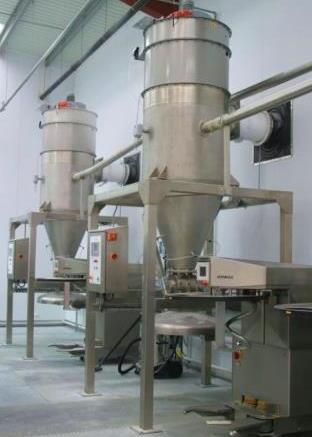
This company’s statutory Report and Accounts for the year ending 31 July 2022 was delivered using electronic communications in accordance with the Registrar’s rules under Section 1072 of the Companies Act 2006.
The principal activities of the company are the manufacture, distribution and sale of petfood throughout the UK, the Republic of Ireland and the rest of the world. The company also manufactures and distributes food for working dogs, including assistance dogs. The company states that its core value is responsible pet ownership.
The pet foods by the company were developed by its founder when practising as a veterinary surgeon and the connection with the veterinary sector remains important to the company.
In the year ending 31 July 2022, the company reported turnover of £22.72 million and Gross Profit of £7.83 million. After accounting for administrative expenses and some minor operating income items, the company reported an operating loss of £225,814. After taking into account a provision for a loan balance of £6,090,484 for the year under review, the company recorded a pre-tax loss of £6,663,559.
Burns Pet Nutrition Holdings Limited is regarded by the Director as being the company’s ultimate parent company. As of 31 July 2022, 100 per cent of the issued share capital was transferred from J. Burns to Burns Pet Nutrition Holdings Limited. J. Burns remains the ultimate controlling party by virtue of his 100 per cent shareholding in the parent company.
Feed Compounder September/OctOber 2023 page 21
01829 741119 admin@croston-engineering co uk Supporting manufacturers since 1976 with solutions in b bulk handling, storage, and pneumatic and mechanical conveying, we have a wealth of experience for you to rely upon. croston-engineering.co.uk Design and Implementation New system solutions Modifications to systems Software improvements Minor ingredient additions Water dosing solutions Ongoing Support Critical Spares and Parts Emergency repairs DSEAR Reports Site surveys Fault finding Servicing and Maintainance Equipment Servicing Silo and pipeline cleaning Infestation works Calibration and certification Continuity and Earth testing
Green Pages
Feed Trade Topics from the Island of Ireland
IRISH TILLAGE FARMERS FACING HUGE LOSSES
Irish Farmers’ Association (IFA) National Grain Chairman Kieran McEvoy is indicating that many tillage farmers in Ireland are facing into a serious loss-making situation.
Spring barley and winter wheat enterprises are incurring significant losses per acre, particularly on rented land.
Analysis completed by IFA shows that a 2.6t/ac spring feed barley crop grown on rented land is losing approximately €125/acre, even after all direct payments.
High land rents – inflated by new nitrates rules – and declining CAP payments are hammering tillage farmers this year.
“The combination of declining CAP payments; very high input costs; moderate to poor yields from a difficult growing season; high land rental costs; and atrocious weather in July and early August are all coming home to roost now,” Kieran McEvoy outlined.
“While the weather has improved over the past 10 days with better ground conditions, many farmers still have winter barley straw unbaled and a significant portion of spring barley crops yet to harvest,” he continued.
Many of the later sown malting barley crops are now facing very high rejection levels.
“We are urgently seeking a meeting with Boortmalt on this issue as something has to be done to alleviate the losses farmers are facing due to the high rejection levels,” he said.
“Tillage farmers are facing huge financial losses this year. It’s now clear that we will need further Government support if this sector is to still stand still, let alone increase its land area in the coming decade. Otherwise, we will see a massive contraction in our tillage area in the coming months and years,” Kieran McEvoy concluded.
BANKS SUPPORT IS CRUCIAL: UFU
The Ulster Farmers’ Union (UFU) says banks must do more to help farmers get through the financial storm affecting all enterprises, triggered by a damaging mix of rising input costs and falling returns, with no signs of any early improvement.
UFU president David Brown commented: “This is as serious a financial situation as many farmers can remember. The industry has always had a good and a positive relationship with the banks and farmers have been valued and profitable customers for generations.
“That is why the banks need to do more to respond to this crisis, particularly as the night’s drawing in confirms more costly times are on the way for farm businesses.”
The UFU says farmers facing financial difficulties often feel alone, but that this is certainly not the case now. But it stresses this is why farming families need the reassurance that banks will work with them to get through this crisis.
David Brown again:
“We are receiving an increasing number of calls from members, and it is depressingly clear there are problems across the industry on farms of all sizes and enterprises. The current market prices are unsustainable and once again, the primary producer is taking the brunt of the price squeeze. Global dairy markets remain difficult, due to ample global supplies of dairy products and weaker demand, particularly from China. Market assessments for a better final quarter to 2023 now look wide of the mark by a long way.”.
Beef and sheep prices have been and remain poor, and input costs are rising relentlessly. The UFU says that against that background all banks need to do more now to engage with their farming customers in a discussion around what products are available to help ease cash flow problems.
The Union president concluded: “The UFU will be engaging with banks and other credit providers to ensure farmers are properly supported over the coming months. This is an approach that will head off potentially even more difficult months ahead for farmers and the banks - a clear case of it making sense to talk.”
POOR HARVEST WEATHER: EVERY CLOUD HAS A SILVER LINING
Every tillage farmer in Ireland has – quite rightly – been complaining about the poor harvest 2023weather up to this point.
But for seed companies and agronomists involved in variety trials’ work, challenging weather at harvest time brings with it a ‘silver lining’ of sorts.
Goldcrop’s John Dunne takes up the story.
“We all accept that securing a decent weather window at harvest time is never a given in this country.
“So knowing which new varieties can perform well when the rain falls and the wind blows is, actually, a positive from a varietal trials’ perspective.”
He added: “Knowing how a new variety will perform during ideal harvest weather conditions is useful, up to a point. However, wheat crops, for example are prone to shedding grains during blustery conditions as they approach full maturity.
“So, the storm-like conditions that affected Ireland the week
page 22 September/OctOber 2023 Feed Compounder
before last provided a perfect opportunity to gauge how the new generation of wheat varieties will cope with these sorts of weather conditions.”
Meanwhile, the rate of genetic progress being achieved by plant breeders continues apace.
“This is a very real and positive news story for Irish tillage farmers,” said Dunne. “A case in point is the decision that has been taken by many European plant breeding operations to put improved resistance against septoria tritici as a key priority, where their wheat development programmes are concerned. This is the most important disease threat that confronts Irish wheat growers on an annual basis.”
Looking ahead to the 2023/24 growing season, Dunne expects to see a significant increase in the area of winter crops planted out.
“Poor weather played havoc with growers’ plans to plant out winter crops last autumn,” he added.
“But if they get the opportunity at all, they will be keen to commit to crops of barley, oats and wheat over the coming weeks.”
Last year saw 20,000ha of winter oilseed rape grown in Ireland. John Dunne is hopeful that this level of commitment to the crop can be repeated again.
“But the first challenge will be that of getting straw baled in fields that have been ear marked for rape,” he said.
“At a commercial level, demand for rape seed is already strong. We have seen tremendous strides made in terms of new oilseed rape varieties can deliver for Irish growers. And this process is set to continue.”
HEAR OILSEED RAPE FORWARD SELLING FOR HARVEST 2024
Tirlán is offering Irish oilseed rape growers a unique forward-selling opportunity for the 2024 harvest, which could enable a grower to cover the crop’s production cost and secure a reasonable margin, even ahead of sowing the crop!
In 2020, Tirlán pioneered the growing of High Erucic Acid Rapeseed (HEAR) in Ireland.

HEAR is a valuable and renewable raw material for the manufacture of a wide array of industrial products.
In the 2020, 2021 and 2022 harvests’, the HEAR crop produced average yields which were comparable with conventional oilseed rape varieties.
However, in 2023, the crop appears to have suffered
disproportionately from the extremely high rainfall experienced in July, and some HEAR crops yielded significantly lower than expected.
In order to encourage growers to continue growing the HEAR crop or embrace it for the first time, Tirlán has secured an attractive two-pronged forward offer for Harvest 2024 from our UK-based customer as follows:
• A fixed price of €575/t for up to 1 tonne per acre of a grower’s production.
• The opportunity to sell the balance of a grower’s production at the November 2024 Matif Rapeseed price, plus a €20/t premium at any time up until Tirlán’s final green OSR prices for Harvest 2024 are announced in September/October 2024.
Teagasc calculated the cost of production for the 2023 oilseed rape crop at €764 per acre. With recent reductions in fertiliser prices, we now estimate that this cost for the 2024 crop is €592 per acre.
Forward prices for conventional oilseed rape at present are circa €410 per tonne (@ 9% moisture, green). Therefore the above offer presents the grower with the following opportunities:
• Effectively cover the cost of production by forward selling one tonne per acre at €575/t.
• Receive a premium of € 165/t for the first tonne of HEAR compared to conventional oilseed rape.
• At a current November 2024 Matif Rapeseed future price of €465/t, the grower could sell a proportion of their production above 1 tonne per acre at €75/t (€465 + €20 premium) above the current price on offer for conventional oilseed rape.
The fixed price offer available from Tirlán for the 2024 harvest, effectively guarantees a minimum of a break-even situation, and presents a risk-free opportunity to make a significant margin from oilseed rape in 2024.
HARVEST UPDATE FROM NORTHERN IRELAND
Co Down Agronomist Richard Owens is confirming that the winter barley harvest in Northern Ireland is complete with many growers now pushing ahead with winter wheat crops.
“Barley yields were disappointing for the most part with crops ranging from 2½t to 3½t/ac,” he added.
“Brackling was a real issue in winter barley this year with ears dropping to the ground.
“Moisture contents came in at 16% to 25%. In many cases, growers have had to factor-in a fairly hefty drying cost, in order to
Feed Compounder September/OctOber 2023 page 23 Alltech.com/ireland AlltechNaturally @Alltech Sarney | Summerhill Road | Dunboyne | Co. Meath
Choose the proven leader for all of your feed additive needs
get grain down to 15% moisture.”
Most barley straw produced in Northern Ireland has been rounded up. But quality is poor.
Some farmers have taken the decision to chop up barley straw and plough it back in. This will be at their own cost, as there is no straw incorporation measure available in Northern Ireland.
Richard Owens again: “Some growers are also lining the bottom of their silos with chopped straw. This will catch a lot of the effluent coming off the very wet grass going into pits at the present time.”
Turning to wheat, Owens said that crops are yielding well: 3t to 4½t/ac. But here again moisture levels are very high: 18% to 22%.
“Drying charges are adding significantly to growers’ costs across the board this year,” he commented.
Meanwhile, winter beans are turning out to be one of the success stories in Northern Ireland for 2023.
“Crops are looking tremendously well at the present time,” Owens confirmed. “The protein aid scheme, offering £300/ha for beans, has really encouraged farmers to push on with the crop. Beans require no chemical nitrogen while also providing a tremendous entry point for first wheats within an arable rotation.”
According to Owens, the first of this year’s spring barley crops in Northern Ireland will be desiccated within the next 10 days to a fortnight.
“The heavy rains of recent weeks actually brought on a lot of later sown crops, which were looking very poor up to that point,” he said. “Some crops actually went down some weeks ago. This was a direct result of the heavy rain and string winds. But it’s not the end of the word, as the crops in question were actively growing at the time.”
Meanwhile the area of crop silages grown in Northern Ireland continues to expand.
Richard Owens said: “Winter rye is proving popular with dairy and beef farmers. Crops are extremely high yielding with silages performing well from an animal performance perspective.
“Livestock farmers, for the most part, do not have rain drying facilities available to them. So the prospects of putting in rye during September and harvesting it as a crop silage the following July is attractive.
“Another arable silage alternative that has taken off this year is the combi-crop option of peas, spring barley and spring oats. Because of the peas, the crop does not require bagged nitrogen. The peas also represent a very valuable protein source at feed our, particularly for young stock.”
Looking ahead, Richard Owens believes that dedicated arable farmers in Northern Ireland will want to push ahead with a significant acreage of winter crops over the coming weeks.
He concluded: “But those dairy and beef farmers who grow smaller acreages of cereals have found the harvest of 2023 difficult one to cope with. And the jury is out on whether they will again with a cropping option for 2023/24.”
2023 Feed Compounder
In my opinion … Richard Halleron IMPROVED PLANT GENETICS ARE MAKING A REAL AND POSITIVE DIFFERENCE FOR TILLAGE FARMERS
Improved plant genetics will play a key role in determining the future sustainability of Ireland’s tillage sector.
I know that a lot of tillage farmers are complaining about the weather at the present time. And rightly so!
But, in all honesty, things could have been a lot worse.
Take oilseed rape as a case in point. Improvements in varietal performance have brought about massive improvements in crop output potential.
We saw this last year with growers achieving yields in the region of 2t/ac, pretty much across the board.
This figure has dropped to around 1.6t in 2023. But given conditions that prevailed for most the 2022/23 growing year, this reduction should not come as that great a shock for farmers.
However, one other tremendous step forward, where oilseed rape is concerned, has been the development of pod hatter resistant varieties.
As a consequence, crops have managed to retain the vast bulk of their yield potential, desite the altering of the heavy rains that fell for all of July.
Genomic improvement is also impacting across the cereal sector. The advent of Barley Yellow Dwarf Virus (BYDV) resistant and tolerant varieties are now widely available to Irish growers.
And no doubt, additional genomic-driven improvements in cereal variety performance will be coming through at an exponential rate over the coming years.
But perhaps the greatest success story of the 2023 crop growing year has yet to fully unfold.
I am told that crops of forage maize are in tremendous shape at the present time.
Factors coming into play here include the use of new, compostable films and, more importantly, the breeding of new maize varieties –specifically suited to our more northern climes.
Plant breeding companies, including the likes of Pioneeer, have specifically committed to developing varieties of forage maize that suite the growing conditions that are found in Northern Europe and Scandinavia.
Moreover crop output levels would be fully maintained. This means that crops of maize would still be delivering up to 18t/c of fresh forage with dry matters and starch levels both coming in at circa 30%.
And Ireland is benefitting as a consequence of these developments
As a consequence, we could well see crops of forage maize planted in late April and harvested in late September becoming the norm this country.
Gone would be the days of trailing heavy equipment around water logged fields in the depths of autumn. Instead, tillage farmers could work on the basis of forage maize becoming an integral part of their normal crop rotations, thereby allowing fields to be fully utilised on a year-round basis.
page 24 September/OctOber


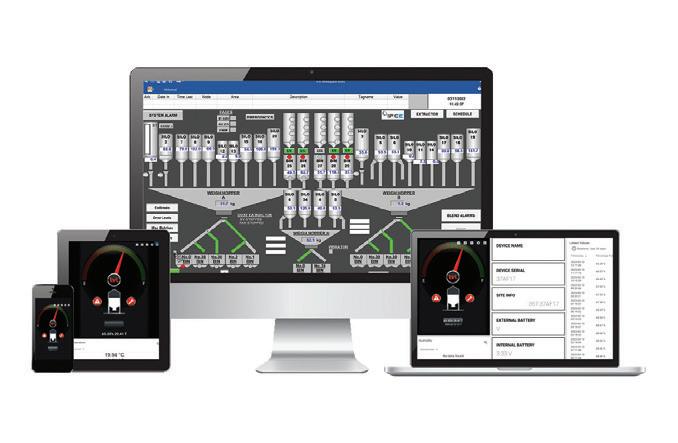



Feed Compounder September/OctOber 2023 page 25 “We use SiloSpi on all our bins. It’s an excellent, reliable system” Mark Kiernan, Chairman, Kiernan Milling T:+ 353 89 2426825 E: info@lvlogics.com www.lvlogics.com • “Real-time” data regarding levels in silos can be viewed by all in the business, anytime, anywhere! • Avoid costly downtime caused by run outs due to errors in reconciled methods of stock control • Improve production scheduling in your mill • Enhance health & safety by eliminating need to climb silos to inspect levels • Data can be directly integrated into ERP & CRM systems via API • Low level alerts can be set at agreed thresholds for added peace of mind Transforming the stock inventory process for Animal Feed Mills www.bestmix.com • Reduce costs and prevent risks • Optimize your entire product chain • Guarantee higher-quality products BESTMIX® Feed Formulation, Quality Control, Ration Calculation and ERP solution Scan to learn more: BESTMIX® Software: The best solution in challenging times
Optimising Energy Usage in the Pelleting Process - Time for Change
With Con Lynch, CEO of CFE Group and Louis White, Managing Director of GLW Feeds Limited.
“At CFE Group, we firmly believe that optimising energy usage isn’t just a goal; it’s a responsibility we all share to safeguard our planet for future generations.”
Con Lynch, CEO of CFE Group.
“At GLW Feeds we are focussed on sustainability throughout all areas of our business, from raw material procurement to delivery of finished feed. To ensure that our production process is both sustainable and efficient
The continuation of high energy prices and consumer pressure on livestock farming to reduce its impact on global climate change will require livestock feed manufacturers to review their current processes and to seek sustainable solutions for a reduction in energy inputs while maintaining high quality and nutritional diets for livestock farming.
For the past fifty years or so, livestock feed manufacturers have utilised several high energy input techniques to produce compound feed pellets. These techniques primarily required extensive pre-meal stock conditioning/cooking prior to the meal’s delivery to the pelleting press to form desired durable compound pellets.
Double Pelleting Technique
In the late 1970s/early 80s, the industry implemented a new pelleting technique that is commonly called the double pelleting system. This new process involved the placement of one pelleting press directly above another, allowing conditioned meal to pass through one pelleting die and then a second pelleting die to produce a finished pellet of greater density and much improved product durability and hardness. Over time, by the early 00s, both machines were matched in size.
The upside of the new double pelleting process is consistency of throughput and quality and greater machine uptime.
The implementation of the process also eliminated utilisation of long term ripners/kettles for pre-pelleting meal conditioning across several feed mills.
Expander / Compactor Technique
Moving forward to the 90s and early 00s, Feed Mills used expander technology, mainly in pig production, to provide an improvement
it has been crucial to reduce our Kwh/t of output, whilst ensuring that we maintain the high standards of quality and throughput of our feeds.”
“Through a programme of investment including the complete renewal of our conditioning processes and pelleting presses with CFE Group, together with the renewal of our steam addition systems, we are already starting to see benefits.” Louis White, Managing Director of GLW Feeds Limited.
in pre-pelleting meal conditioning required to achieve the desired pelleting durability and increased throughputs.
This technology improved pre-pelleting meal conditioning significantly, by employing a much higher level of frictional shearing of the meal stock and subsequently improving the gelatinisation of the meal stock prior to entry into the die.
Expander technology has a motor requirement of 250kW to 315kW for the second high energy drive.
Reduced Energy Techniques
Consumer and legislative pressures on livestock farming will continue to grow and livestock feed producers need to research and invest in innovative technologies in order to reduce their impact on the planet and to meet their responsibility for sustainable production of livestock feeds.
GLW Feeds Limited, together with CFE Group, have been working in close collaboration for the past two years to find new energy reduced techniques for the production of high-quality pelleted diets at their Shepshed Feed Mill.
GLW Feeds Mill has, over several years, used a combination of double pelleting and expander technology on their four primary pelleting lines. Each of the four press lines utilised pellet presses with dual belt drives, with an expander being used on their two primary ruminant press lines.
Phase One
GLW Feeds Limited had identified a requirement for the replacement of their ageing belt drive pelleting presses, to improve both throughput and quality and reduce energy consumption per tonne.
Following consultation with the CFE Group, replacement of the ageing presses with new or fully reconditioned CPM 7932/9 (250kW) presses and lineator and RSM systems, was agreed.
page 26 September/OctOber 2023 Feed Compounder
Installation of the first two CPM 7932/9 Presses is now complete on GLW Feeds press lines 1 & 3, and they are performing above expectation on throughput and quality.
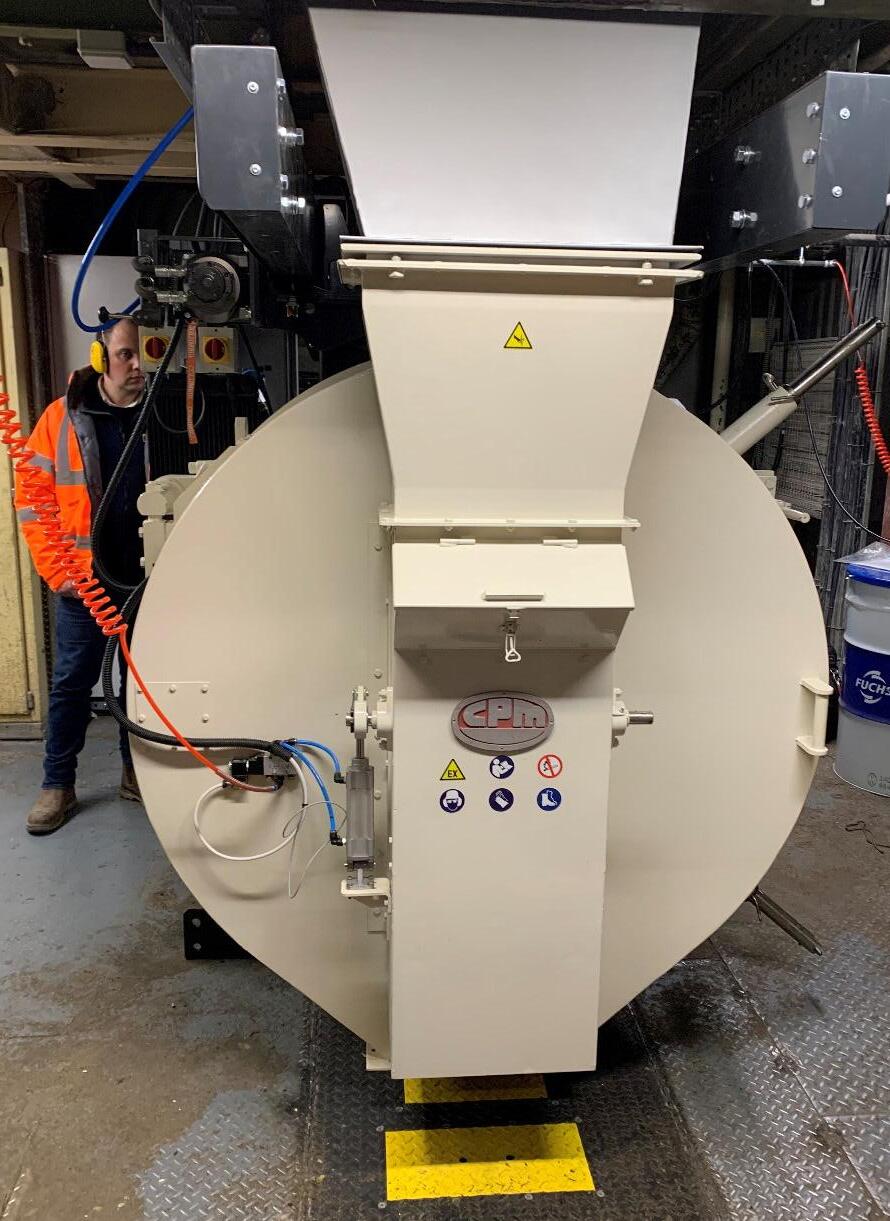
Machine uptime has been increased significantly because of the direct drive motors. In replacing the old belt drives with the direct gear drive CPM 7932/ Presses, GLW will reduce the energy losses traditionally seen with belt drive transmissions and realise a 4% energy input reduction.
Phase Two
Further collaboration between CFE Group and GLW Feeds explored the potential for the removal of the two Expanders from their Lines 1 & 3 and the replacement of their current meal conditioners with the much higher efficiency range of conditioners developed by CPM.
CPM have, over recent years, developed a range of meal conditioners that offer a much-improved level of conditioning and longer pre-pelleting retention times.
to the high fill rate (60%+), enables a much higher utilisation of steam, subsequently improving gelatinisation of starches.
To ensure that high quality dry steam is available at the new CPM LLX (T) Conditioners, GLW Feeds also decided to install a new IVS steam control set, complete with a steam meter for monitoring steam quality and utilisation, on each line.
The new conditioners are also fitted with VSDs to ensure the optimum fill levels are achieved.
The removal of the expander and old conditioners and installation of the new conditioners and steam sets on Line 3 was completed at GLW Feeds several weeks ago. Removal of the expander and conditioners from Press Line 1 is proposed for later in 2023.
Conclusions
GLW Feed’s removal of the expander from Press Line 3 has seen no reduction in either pellet quality, production throughputs or nutritional values.
LLX (T) Conditioner above LT24/10 Conditioner – GLW Feeds
After several trials, GLW Feeds decided to replace their conditioners on Lines 1 & 3 and to remove the expanders from both lines; replacing the equipment with a CPM LLX (T) Conditioner (15kW), for inclusion of the steam & molasses and a CPM LT 24/10 Conditioner (15kW) to provide additional meal retention time before progression to the pellet press, (both pictured above). The T Shape Paddles on the conditioners provide for a much greater level of amalgamation of the steam and molasses inclusion. This improved mixing capability, due
The removal of the expander from Line 3 has reduced the installed power availability by circa 315kW and realised a potential energy saving. This is outlined in the table on the following page which also shows a reduction of circa 10kW hours per tonne is achievable by the removal of an expander process. This is an energy cost per tonne reduction of circa £3.00, based on the current industry energy price per kW hour.
The much-improved meal conditioning will also facilitate an average increase in production throughputs.
It should be noted that to maintain the desired pellet quality, it was necessary to increase the die specification. This increase in die thickness does not restrict the performance or energy input required owing to the much-improved meal conditioning and the enhanced press controls afforded by the lineator and RMS systems installed on the pellet press.
This conditioner system also eliminates the high cost associated with the maintenance of expanders.
GLW Feeds has already placed an order for two additional CPM 7932/9 Presses and two additional LLX (T) Conditioners for installation on their remaining two press lines at the Shepshed Mill.

As livestock feed producers’ efforts to meet sustainability targets continue, there is no doubt that advancements in meal conditioning technology will play a significant part.

Feed Compounder September/OctOber 2023 page 27
Conditioners at GLW Feeds Line 3
Louis White M.D. GLW Feeds reviewing the new CPM 7932/9 Press
CFE Group Expansion
Further growth at Compound Feed Engineering, trading as the CFE Group, over the last five years – both organic and through acquisition – has led to the company taking on additional premises in the UK.
CFE Group specialises in the refurbishment of pelleting and other feed manufacturing machinery, and the supply of spares and consumables. CFE Group is also the UK and Ireland agent for global pelleting equipment manufacturer CPM. The Group has its headquarters in Ireland, but all engineering operations are performed at its UK facilities.
In 2021, CFE purchased the machine engineering company Sevale Engineering. Located near Gloucester, Sevale has increased CFE’s UK footprint, and the company now concentrates on servicing smaller milling businesses in the south-west region. More recently, in March this year, CFE acquired Turner Grain, a Dublin-based process engineering specialist with over 40 years’ service to the compound feed and biomass industries.
CFE managing director Con Lynch says the business is seeing more interest in energy-efficient feed milling equipment through its CPM agency. As the number of machines installed increases, so does the demand for its after services. The company is also seeing rising demand for feed machinery refurbishment from European countries
such as Italy and Germany, while the waste pelleting sector is also growing steadily.
The company has had its UK base at Haydock on Merseyside since it was established over 20 years ago. Strong growth has seen CFE’s expansion in 2022 to include a second premises at Haydock.
As a result, operations are now split. Refurbishment of feed mill equipment takes place at the original building at Haydock Lane Industrial Park, now called the UK Refurbish Plant. The company, which has invested significantly in high- pressure die and roll cleaning equipment over the past decade, continues to introduce and implement updated and automated processes at Haydock Lane since it commenced production in 2002.
The second new premises at Arrox Park at Haydock is the CFE Group’s Service Plant. This facility is dedicated to servicing used CPM equipment, such as pellet mills, roller mills and hammer mills, as well as other associated machinery. It also serves as CFE Group’s storage and distribution centre for its extensive stock of CPM spare parts.
“The CFE Group is conscious of the need to reduce energy consumption in feed production,” says Mr Lynch. “We are focusing our efforts on increasing energy efficiency and optimising installed power at the Pellet Station.”
page 28 September/OctOber
Machine Ref Motor Size kW Full Load Amps Recorded Amps Utilised kW % kW Utilisation Conditioner 1 15 23.1 15 9.21 61.37 Conditioner 2 12 18.5 14.5 8.90 74.16 Expander 315 481.5 320 196.39 62.35 CPM 7932/9 250 386 255 156.50 62.60 LLX (T) Conditioner 15 23.1 21 12.89 85.92 LT Conditioner 15 23.1 21.5 13.20 87.97 CPM 7932/9 250 386 360 220.94 88.38 Reference From Motor Plate Change to Full Load Amps on Motor Plate or use inserted Add Recorded Amps on Screen Auto Fill Auto Fill Machine Ref Power Factor Voltage TPH kWh's kWh's per tonne Cost Per kWh/ pence Cost Per Tonne Conditioner 1 0.9 415 12.1 9.21 0.76 0.30 £0.23 Conditioner 2 0.9 415 12.1 8.90 0.74 0.30 £0.22 Expander 0.9 415 12.1 196.39 16.23 0.30 £4.87 CPM 0.9 415 12.1 156.50 12.93 0.30 £3.88 Total 30.66 Total £9.20 LLX (T) Conditioner 0.9 415 12.1 12.89 1.07 0.30 £0.32 LT Conditioner 0.9 415 12.1 13.20 1.09 0.30 £0.33 CPM 7932/9 0.9 415 12.1 220.94 18.26 0.30 £5.48 Total 20.42 Total £6.12 Reference Add Power Factor on Motor Plate or use 0.9 Add Voltage on Motor Plate or use 415 Estimated TPH Auto Fill Auto Fill Add Site Average kWh price inclusive of all tariff charges Auto Fill GLW Feeds Line 3 GLW Feeds - Line 3 - Energy Reduction Calculations Press Energy Consumption / Cost Calculator GLW Feeds Line 3 Table 1.
2023 Feed Compounder





Feed Compounder September/OctOber 2023 page 29 THE UK flavour manufacturer supporting British & Irish agriculture Unlock the possibilities To find out more about our unique Tastetite and other feed enhancement technologies visit our website at www.inroadsintl.com email info@inroadsintl.co.uk or call us on +44 (0)1939 236 555. 10461_Inroads_Feed Compounder Ad_Half Landscape_124x178.qxp_Layout 1 21/12/2021 14:33 Page 1 Tel: +44 (0)1159813700 Email: sales@dsl-systems.com Web: dsl-systems.com Member of the Valsoft group Tel: +44 (0)1260 277025 Email: sales@datastorsystems.com Web: datastorsystems.com • Software for life • Optimise processes • Reduce labour • User friendly • 24/7 support • Performance monitoring • Flexible and configurable • Stock control and traceability Advanced control, planning and information software for feed and grain plants Winner of the New Product Showcase IPPE 2023 Best of the Best in Animal Feed www.imperium4.com
FEEDING PEOPLE WHILE PRESERVING THE PLANET
With Dr. Mark Lyons, President and CEO, Alltech, Vaughn Holder, Ruminant Research Director, Alltech & Nikki Putnam Badding, Director of Human Nutrition Initiatives, Alltech

Agriculture is at the heart of many important conversations in 2023. And whether the issue at hand is environmental concerns, the production of enough nutritious food for the global population or one of many other contentious topics, agricultural producers are often seen as anti-heroes — when, in reality, the agriculture industry has the greatest potential to make a positive impact on the world.
Proof of this positive impact was on display during the opening keynote addresses at Alltech ONE Dublin, the second stop on the Alltech ONE World Tour. Dr. Mark Lyons, president and CEO of Alltech, opened the conference with an assertion that the widespread image of agriculture as a villain makes it more important than ever to tell the story of how animal and food production benefits our planet.
“Bad news is out there, and it does get the eyeballs,” he said. “That’s why I think it’s critical for every business to be dedicating resources to communicating. And to me, that’s the headline: ‘We need our animals. We capture more carbon with them than we would without them.’”
“This is about ideas,” he continued. “It’s about inspiration — and, I think, taking some risks, because we all know what the challenges are. And we need to think about them in a different way.”
Cattle: The secret weapon to sequestering carbon
Climate change is widespread and will only continue to intensify, placing a great strain on the world’s resources. Agricultural production is often cited as a significant factor in climate change — but in reality, as Holder outlined in his address at Alltech ONE Dublin, agriculture is one of the only industries with the ability to not only reduce its own greenhouse gas (GHG) emissions but to capture and sequester emissions released by other industries.
“We exist at the interface between the world’s biggest carboncapture and machinery industry, and that’s agriculture,” he said.
Alltech has been studying the agriculture industry’s ability to sequester carbon through a research alliance based on the 10,000acre Buck Island Ranch in Lake Placid, Florida. During their research at Buck Island, the Alltech team has seen first-hand that cattle can help sequester carbon through grazing — which counters the popular argument that eliminating cattle production will also reduce emissions.
“We have more than enough capacity to put this carbon away,” Holder said. “So, this is what we’re focusing on as a research group, is trying to understand this entire carbon cycle so that we can design interventions and identify levers that can allow us to use this cycle to ameliorate not only the methane side of carbon cycle but the big elephant in the room, which is CO2.”
As Holder referenced, much of the general conversation about agricultural — and, specifically, livestock — production focuses on the issue of methane, but the data has borne out that carbon dioxide is a much more dangerous foe.
Lyons was joined onstage by Dr. Vaughn Holder, ruminant research director at Alltech, and Nikki Putnam Badding, director of human nutrition initiatives at Alltech and managing director of Acutia, who both illustrated how agriculture plays a vital role in both protecting the environment and ensuring the health of all people.
“We have two of the most important jobs in the world: We have to nourish our population and we have to preserve our planet for future generations,” Lyons said. “The challenge to all of us is to come up with the solutions that are going to help us.”
“Carbon dioxide is the problem,” Holder said. “And if we don’t figure out a way to suck carbon dioxide out of the environment, no matter what we do to methane, it’s not going to make a difference.”
“I think methane is important; don’t get me wrong,” he added. “But we have to look at it in a little bit of a different framing. Fossil fuels are a one-way highway.”
To explain this concept further, Holder argued that the methane produced by cows is fundamentally different from carbon dioxide, which accumulates in the atmosphere. “It stays where it was; it goes nowhere,” he said. Methane, on the other hand, can be mitigated and cycled out much more quickly.
page 30 September/OctOber 2023 Feed Compounder
L to R: Dr. Mark Lyons, President and CEO , Alltech; Nikki Putnam, Director Human Nutrition Initiatives, Alltech; Vaughn Holder, Research Group Director, Alltech, at Pearse Lyons Distilliery in Dublin, Ireland as part of the Alltech ONE World Tour.
“Methane has some pretty cool characteristics that allows it to be somewhat of an opportunity for us, rather than a threat to the industry,” he said.
To start with, contrary to popular belief, methane isn’t just produced by cows; it’s produced by “things that ferment,” Holder explained, including the feeds eaten by cattle herds. “And whether that’s in a cow’s rumen or whether that’s in the field, you’re still going to be getting methane out of that.”
So, what would happen to these feeds and their byproducts if cattle production was eliminated? The consequences would be dire, Holder warned.
“Eighty-six percent of global livestock feed currently goes through livestock,” he said. “And that does two things for us: It allows us to actually get some of that food back to our food systems, but it also prevents that feed from fermenting out in the field and causing their own source of greenhouse gases. And if you put it into compost, which is what a lot of people would have you do, five times the amount of greenhouse gases will come off of those byproducts.”
This is the kind of fact that Holder wishes made headlines, as it is somewhat counterintuitive to what the average person might believe.
“When we are making recommendations on changing our food systems to save the environment, we’ve got to be thinking about these types of things,” he said. “The systemic effects of what we are doing are probably much more important than the direct interventions that we are trying to make in the first place.”
Holder has seen first-hand the positive impact of agriculture on the planet — and he hopes the rest of the world can see it, too, so that ag producers can get back to their original mission.
“We have a massive role play in climate change, and I don’t think there’s another industry that has a similar position,” Holder said. “But we can’t lose sight of what our primary purpose is, and that’s feeding people, sustaining the world. That’s the most important component, in my opinion, of sustainability. We have to keep food production primary when we are thinking about changing these systems.”
Producing nutritious food for all
In her opening remarks, Putnam Badding directly echoed Holder’s comments about the broader definition of sustainability — but also took them a step further by expanding on the notion of what it really means to maintain a healthy populace.
“Sustainability doesn’t begin and end with environmental impact,” she argued. “We must look after the long-term health of the planet and the people who share it. But providing enough food is not enough. We must change the dialogue from providing enough food to providing enough nutrition.”
One in ten people in the world are undernourished, and one in four are considered malnourished — equaling over 2 billion people worldwide. As Putnam Badding explained, malnutrition comes in many forms, including “undernutrition,” or a lack of calories, protein and micronutrients. As a result, the ag industry must start focusing on more than simply producing enough food for the world; we must also ensure that we are providing the most nutrient-dense food possible. And, as
Putnam Badding explained, the journey to producing truly nutritious food begins right under our feet.
“Nutrition, for humans, starts in the soil,” she said. “More nutrientdense soil produces higher yields of more nutrient-dense crops. The more nutrient-dense the soil is — through use of regenerative agricultural practices or micronutrient-enriched fertilizers — we can actually produce more nutrient-dense and greater yields of crops.”
Putnam Badding was quick to assure the attendees at Alltech ONE Dublin that she was not downplaying the role of animals in nourishing the planet, as animals provide humans with nutrition that we would not be able to access otherwise.
“Animals are the original up-cyclers,” she said. “They take that biomass that Dr. Holder mentioned is unsuitable for human consumption — we can’t eat that; we can’t pull nutrients from it — and they create packages of highly bioavailable protein and micronutrient-dense pieces of delicious food for us to consume. And often, they’re using land that is not suitable for intensive food production.”
Although animal-derived products and plant-based foods are sometimes pitted against each other, Putnam Badding sees both as critical in the effort to nourish the world.
“This is not a ‘plants versus animals’ discussion. The end goal is nutrition for all, and to truly achieve that, we will rely on both plants and animals,” she said. “Animals provide us with essential nutrients that plants do not, and vice versa. Nutrition security requires all food sources. As we work together to nourish 10 billion people and beyond, we must remember that soil, plants, and animal, environmental and human health are all deeply interrelated.”
Considering the vital role of animal and crop production in helping the global population thrive, Putnam Badding posited that it’s time to give agriculture its due — and for the rest of the world to see it in a new light.
“Our purpose is more than farming. It’s more than food production. It’s more than environmental sustainability,” she explained. “It’s sustaining healthy people and a healthy planet for generations to come. By placing nutritional quality at the heart of agricultural practices, we can truly achieve zero hunger and good health and well-being for all.”
As Putnam Badding, Holder and Lyons all made clear, agriculture does not deserve the bad rap it sometimes receives.
“We see this industry as having the greatest potential to positively shape the future of our planet,” Lyons said.
But it won’t be easy, as all three speakers acknowledged. There are many hurdles ahead — but then again, there always have been for farmers and the agriculture industry. We will be able to cross them together if we see them as a chance to change the world for the better.
“We’ve got to make sure we embrace the opportunities that are in front of us. Because it is a huge responsibility, but it also is a tremendous, tremendous opportunity,” Lyons said. “This is a time that calls on us to do much more. But isn’t that an exciting thing to be a part of?
“Agriculture can really transform things in ways that other industries cannot,” he continued. “Ag truly is at this interface of nourishing the present and preserving the future. And that’s tremendously inspiring.”
Feed Compounder September/OctOber 2023 page 31
In Memory of Alf Croston A Feed Milling Gentleman

 By Andrew Mounsey
By Andrew Mounsey
Alf Croston died on Friday 21st of July 2023, aged 97, seven months after surviving a fall resulting in a broken right hip early in December last year when working in his office. He recovered very well from the hip operation but developed complications which left him bedbound, being unable to tolerate sitting up, but with never a word of complaint.
Alf founded Croston Engineering Ltd, at Tarvin near Chester in 1976. The company specialises in the design and build of bulk handling and storage facilities for human food, animal feed and associated industries.
Alf was a really good and loyal friend and supporter of Feed Compounder, right from when it was first produced at the beginning of the 1980s. He was always kind in his dealings, asking after older members of the family he had known from the early days of magazine, while welcoming the latest generation in the same friendly manner.
Alf was particularly proud of the feed mill which his company helped to create for West of England Farmers at Melksham. While offering state-of-the-art functionality and efficiency, it was at the same time a truly elegant construction. Not for nothing did it become affectionately known by locals as ‘Melksham Cathedral’!
He was also proud to be receive the inaugural (and so far, only) Feed Compounder Millie Award in recognition of services to the feed industry. We learned after his death that Alf had kept this on display in his office ever since receiving it in 2010.
Alf was a very good communicator and able to express how feed mill engineering and practice had evolved over the many years in which he was involved. His last article for Feed Compounder, published in 2017 and based on a paper he presented at the Society of Feed Technologists 50 year anniversary event, was entitled ‘Memories of a Feed Milling Man’.
In fact, Alf was a Feed Milling Gentleman; he will be greatly missed. The following tribute, written by Alf’s sons, shows that his was indeed a life well lived.
ALFRED EDMUND CROSTON
13th October 1925 - 21st July 2023
By Nevil and Roger Croston
Alf drove himself to work as normal and was in his office at Tarvin Mill on the day he fell and fractured his hip on the 7th of December 2023. In hospital he said, very quietly, “what a mess!” followed by “when can I go home?” Over the next few months he made slow progress but it was an event which tragically took away his mobility and independence.
Alf outlived nearly all of his contemporaries, yet over two hundred attended his funeral at St. James’s, Christleton, Chester, on the 4th of August.
He was born on the 13th of October 1925 in Liverpool. His father Charles was chief engineer at the Crossfields and Callow feed mill on
the docks. His mother Ruby was a dedicated housewife. Alf passed a scholarship to the Liverpool Collegiate School and on the outbreak of war on the 3rd of September 1939, the whole school was evacuated, in his case to Bangor, north Wales and his brother Charles to Preston.
Initially he was in a large house overlooking the Menai Straits with a family with two servants but then the servants were called up to the military and Alf said he was “offloaded” with another boy to a smaller council property to a family with three children and an Italian lodger who was later interned. The evacuees attended school for half the day and the local children went to the same school for the other half.
page 32 September/OctOber 2023 Feed Compounder
Alf in 2016 in costume as The Miller of the Dee
Alf’s Millie, which he proudly kept on display in his office
He could not understand why the son of the family and the Italian lodger would go out in warm weather wearing heavy coats, until the time he was invited to accompany them, following which he became a proficient poacher using terriers and a ferret on a local country estate. After 6 months of not much happening, a period known as the “Phoney War”, he returned to Liverpool and lived through the Blitz.
An interrupted education meant that he was one subject short of being able to join the 6th form, so because he did not want to resit a year, he left school and got a job as a trainee fruit importer which he found boring, so he joined an insurance company. Soon after, in 1943, his father, who had suffered years in the trenches in The Great War, saw an advertisement in the local paper for army engineering cadetships and encouraged him to apply, thinking it would keep him out of the front line. Alf passed the selection by climbing ropes and proving he had good table manners. He took up the cadetship at Wigan Mining and Technical College where one Margaret Spencer was on the secretarial staff. They later married in 1950.
He was called up in September 1945 and chose REME (Royal Electrical and Mechanical Engineers). The basic training was in Winchester and on the journey down, he and his fellow conscripts were laughing and joking in front of two elderly ladies. When they told them they were joining the army the ladies replied, “well you won’t be laughing much longer.” Those men remained lifelong friends and they held reunions until fairly recently; he was the last known survivor of that group.
Alf served in Germany and then Austria as part of the Allied Army of Occupation. He was on the first post-war through-train to Austria in 1946 from a Dutch port, which he was rostered to meet and accompany. The connecting ferry with several hundred troops from England was delayed by thick sea ice in that harsh winter and the train departed on schedule without them. En-route the train stopped for the soldiers to disembark for meals and Alf recalled at the first halt in Germany, “you should have seen the faces of the Top Brass when only the three of us stepped off! We telegraphed ahead to try to make cancellations.”
Another of his many such stories was that two of them purloined a commandeered senior German officer’s staff-car and took it for a drive. On being stopped by the military police the excuse they used was that they had just serviced it - which they actually had - and were taking it for a test drive; fortunately, the story worked. He had a great affection for both countries and he and his wife visited many times until ten years ago. He had particular affection for a posting to Klagenfurt in Austria and revisited the town several times.
In 1948, he was demobbed and joined W. S Barron and Sons in Gloucester on £2 10s 0d per week with accommodation found. The company designed and manufactured milling equipment and Alf became their representative for the North of England based in Chester. When they were taken over, he transferred for a couple of years to work for Simon Engineering Ltd. in Manchester but found the regime too bureaucratic. He was headhunted by Miller’s Engineering Ltd. in Wrexham and so the family returned to Chester.
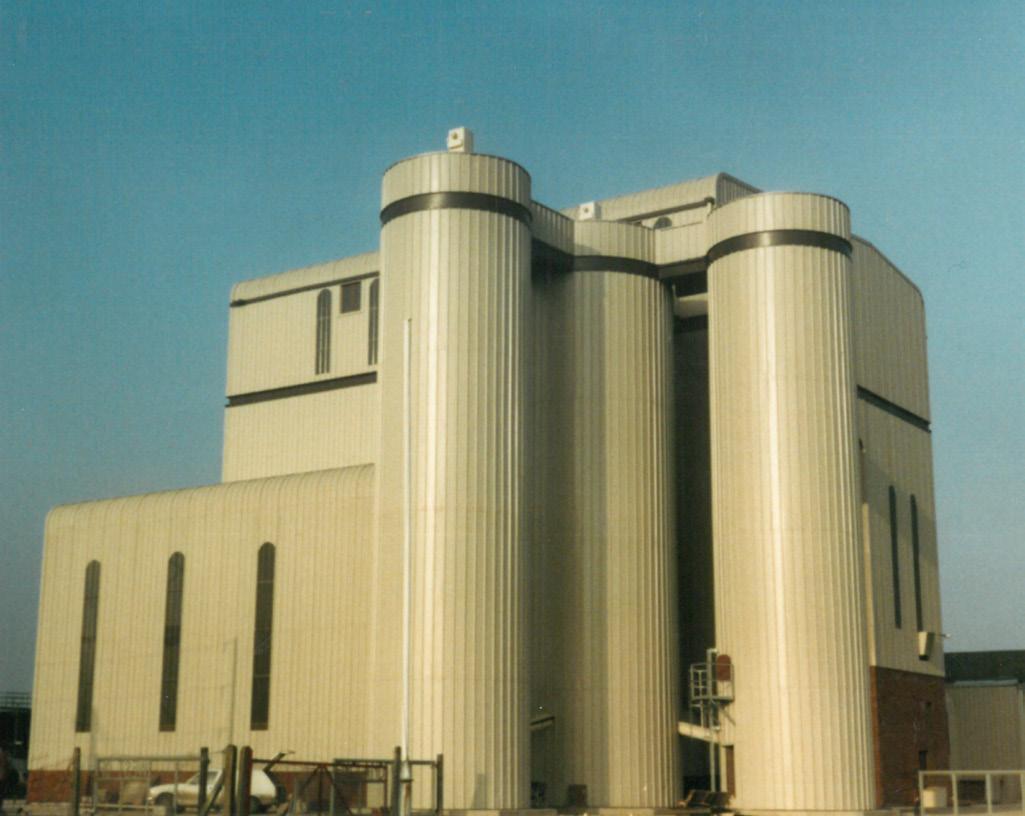
In 1976, without telling his wife, who thought he was late leaving for work, he announced that he was no longer employed and was
starting up his own business from the front room. So began Croston Engineering Ltd. which specialises in the design and building of dry goods bulk storage and handling systems, mainly in the food industry.
From small beginnings he built up a large network working with family businesses and often worked on the basis of a handshake and that “one’s word is one’s bond.” On rare occasions in more recent years, this tested his faith in humanity, and he deprecated the modern tendency of detailed formality instead of applying common sense solutions to problems. He was a chartered engineer and a member of the Institute of Mechanical Engineers. He had a particular interest and expertise in dust explosions and was regarded as an expert in this field.
At home he was very happily married to Margaret and was immensely proud when she was awarded the British Empire Medal a few years ago for her charity work and work in the local community over many decades. They were a mutual support pair for over 65 years. Their sons never once heard them argue, never a cross word and never heard Alf swear, even mildly.
Alf was closely involved in Christleton village and Chester life. He was part of the parish church’s community since the family moved there in 1964 where he was a sidesman, churchwarden, choir member, server and a member of the PCC.
He was a great rackets sportsman and played tennis until he was 90 and played badminton to a high standard. He was highly sociable, belonging to many local organisations such as Round Table and then 41 club, The Chester City club, The Cheshire Pitt club and Chester Masonic. He was generous to a fault and never forgot people.
Alf’s wish was to ensure that the employees of Croston Engineering were secure and that relationships with customers and suppliers should continue unchanged into the future. At the time of his accident plans were well advanced to form an Employee Ownership Trust and this was completed in February this year enabling the company to plan for its next phase of life with a team of great people who are carrying that legacy into the future.
Feed Compounder September/OctOber 2023 page 33
The elegant lines of the Croston Milling designed West of England Farmers feed miil at Melksham - affectionately known by locals as Melksham Cathedral
Futureproofing our returns from Essential Oil feed additives
By Iain Campbell, UK Poultry Technical Manager, Techna UK
For a feed compounder, the goal is simple, offer poultry farmers a performance improvement feeding option which maximises nutrient utilisation and profit.
Faced with uncertain markets, raw material availability, price volatility and narrow profit margins, it is now, perhaps more than ever, that the potential financial gains of feed efficiency and nutrient utilisation are attained. Avian Influenza and AGP regulations have led to a substantial improvement in poultry farming practices. Investment made to optimise biosecurity and animal husbandry practices, changes to standards relating to welfare and sustainability, all bring financial challenges. Given higher feed costs for the foreseeable it is vital to maximise every ounce of performance from poultry feed.
One of the key drivers for feed formulation is always to maximise the nutritional potential of poultry feed whilst conducting effective optimisation to ensure microbiota eubiosis. We are all aware of the importance of Gastrointestinal tract (GIT) health on productivity and performance. With efficient GIT health comes the payback of performance improvement as the key pathways can work effectively between the immune system, intestinal integrity and microbiota management which improves return on investment.
After more than two decades of research and many peer reviewed scientific studies, we know that Essential oils (EO) can be added to the diet of commercial animals to improve their productivity through enhancing feed properties, promoting animals’ production performance and improving the quality of products derived from these animals. Many studies have reported that supplementation of poultry diets with essential oils has enhanced weight gain, improved carcass quality, and reduced mortality rates (Williams and Losa, 2001). The use of specific EO blends can be effective in reducing the colonisation and proliferation of Clostridium perfringens and controlling coccidia infections. Consequently, it may also help reduce necrotic enteritis. (Guo et al., 2004; Mitsch et al., 2004; Oviedo-Rondón et al., 2005, 2006a, 2010).
In light of supporting science our understanding over the past few years has begun to change from ‘sceptical’ to ‘confidence’ regarding the use of EO feed additives. We have seen significant growth in EO use as prophylactic GIT health management and performance enhancement option.
So, armed with a greater understanding of how these major components of plants help us to naturally maintain this microbiota balance and GIT health how do we move forward? How do we show, capture and maximise the benefits? And most importantly how do we make a commercially viable standardised product?
Firstly let’s go back a few steps. Plants have a large variety of EO
which contain secondary compounds that protect them from microbial and insect attack. Known as Phenolic aromatic compounds such as Carvacrol, Thymol and Eugenol. They are known to have antibacterial, Antioxidant and anti-inflammatory properties. We now know that the mechanism of antibacterial activity of herbal constituents is linked to their hydrophobicity, which disrupts the permeability of cell membranes by a partitioning action between the lipids of the cell membrane and mitochondria rendering them permeable with the consequence of loss of cellular components, and even cell death (Figure 1).
Figure 1: Modulation of the intestinal flora. Aviance regulates gut microflora by creating a synergistic effect between the individual compounds. Modulation measured by time-kill method is shown in the graph.

Even armed with this kind of research the key for Techna is that we understand that EO can vary in composition and level of active substances due to many reasons. We know that you will find varying results in growth performance in poultry with some EO sources and dosage levels. This is due in part to the natural variations, differences in composition and activities of EO concentration. We see this even in the same plant species. For example, the main active substances that have antimicrobial functions in Oregano EO are Carvacrol and Thymol, whose content may differ as largely as 5% to 85%.
Techna’s product standardisation protocols are a key factor when developing a robust essential oil feed additive. Our additive products are all manufactured, and quality controlled at our own manufacturing facility in Malville, France. After many years of development work involving stringent and repetitive trials at our R&D poultry unit ‘Euronutrition’ near Le Mans in France, we continually test our raw materials in our modern laboratory facility which allows us to set manufacturing guidelines to ensure consistency of EO
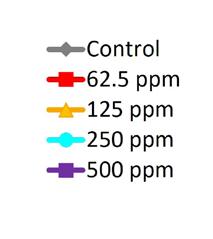
page 34 September/OctOber 2023 Feed Compounder
concentration in finished product. Close working partnerships are essential with suppliers and growers to establish the chemical composition.
Armed with the confidence of a standardised product we looked to develop the full potential of EO by targeting the specific areas of the gut by microencapsulation and also to investigate the financial benefits that improved nutrient digestibility brings to energy utilisation.
We also know that Aviance improves nutrient absorption by increasing the villi height (Figure 3). and improving the ratio of villi length and depth of crypts. This is a key benefit of Aviance as the potential for an increase in the absorption of nutrients in the intestine contributes to greater feed digestibility.

In summary, the key to unlocking the maximum potential of using EO is:

• Continuous scientific R&D to constantly finesse the blend of particular Phenolic aromatic compounds.
• Standardisation of the product with defined results,


By carrying out extensive research at our R&D poultry facility on Aviance to measure the digestibility benefits due to the enhanced feed utilisation, nutrient bioavailability, along with improved digestive enzyme secretion and the motility of the digestive tract, we were able to quantify and measure the benefit to the animal from an energy utilisation perspective. We are now able to make precise judgements across a range of raw materials on the effect that Aviance has in the energy utilisation within the diet and we can adjust energy matrix values to represent a financial saving within the formulation (Figure 2). We know Energy in poultry diets is expensive and as such if we can accurately predict the energy saving from a set list of raw materials we can be more accurate in our formulation work on a mill by mill basis. This kind of work is not theoretical but proven in trials and in the field.

In order to ensure we can attain the formulated energy saving we needed to ensure a robust product with consistent results. This is a key consideration with the use of EO, whilst it is hard to find the negative effects of plant extracts on poultry performance, poor understanding of the manufacturing processes involved can affect results. Our Aviance microencapsulation system has been developed and tested using specific biomarkers to ensure the delivery of more phenolic compounds to the specific GIT segments. Microencapsulation is also beneficial to ensure:
• Storage stability - Protection from environmental conditions (temperature, pressure, humidity, etc.)
• Masking of the strong odour of certain products (e.g. garlic extract)
• Improved powder flow
• Control of the release of active ingredients over time (instant, extended or targeted release)
• Protection of the product with targeted release points.
• Confidence around the incorporation of the product within the formulation with precise improvement values within the energy matrix. Ultimately this is where the grower will look to see his ROI.

Feed Compounder September/OctOber 2023 page 35
INTAKE and PERFORMANCE stimulating Stimulation of feed intake Modulation of intestinal flora Increase of the absorption surface Iain Campbell UK Poultry Technical Manager iain_campbell@gb.groupe-techna.com Mobile (+44) 07938 424009 www.feedia-techna.com |
Figure 2: AVIANCE improves metabolic energy coefficient in Feed digestibility trials
Figure 3: Impact of AVIANCE on villi length (Duodenum)
Fibre Focus Paves the Way to Extracting More Feed Value from Home Grown Forages
By Dr Philip Ingram, Ruminant Technology Application Nutritionist, Cargill
There’s a lot more feed value in forages that can be used by dairy cows. This is the key finding in Cargill’s fibre digestion study which will encourage farmers and their advisers to ‘lift the lid’ on fibre digestion. Using this improved data can promote improved formulations, better feed efficiency and economic sustainability in our herds.
Forage quality varies widely from year to year and area to area. It’s always dangerous to make generalisations. And this year is no exception.
After a decent first cut of silage for many, later cuts were subjected to difficult growing conditions and harvest was hit and miss. Some were caught by wet weather, while others were delayed, and grass became over-mature.
We have a mixed bag to deal with. And this winter the economics are different with average milk prices being lower. Protecting margins will be vital this winter. More value from forage, particularly the fibre portion, is the big ‘untapped’ resource.
Variable milk from forage
While milk yield per cow has increased during the past two decades, data shows that the proportion of this milk produced from home-grown forage has dropped by 6%.
bought-in feed prices, and it does little to improve feed efficiency or the unit’s carbon footprint.
There are big variations between herds. The top quartile of herds ranked on milk from forage are producing two-and-a-half times as much milk from forage as the bottom quartile. So there is potential to improve.
Improving fibre digestibility is where the big wins can be made and there’s scope to achieve this, providing the nutritional background is right, such as using the right diet and ensuring good feed management. We can work with producers to formulate cost-effective diets that get more feed value from forages, particularly more energy for milk production from the fibre portion.
The starting point in any rationing process is the forage analysis data. But also look at how eagerly the cows are eating the forages – we want to get a handle on forage intakes - and the results in the tank. We can’t get all the answers from the analysis. They are the deciders when it comes to quality and digestibility. If the forage is indigestible, intakes will be poor and performance limited. Take notice of the cow, and trust what she tells you.
Fibre study
Fibre digestion is a big driver of milk from forage, and therefore in feed efficiency and profitability. Yet a fibre use study carried out by Cargill UK in 2022/23 confirmed that its usage is far more variable than that of other nutrients, with between 20% and 50% being used and the rest being excreted in dung. There is a lot of scope for improvement on most farms.
In the two decades from 2002 to 2022, milk yield per cow increased by 16% to the current 8,042 litres, according to Kingshay data. But milk from forage only increased by 3.7%, from 2,702 litres to 2,801 litres compared with an increase in concentrate use per litre of 14%. Concentrate use per cow escalated by 23% to 2,372kg.

It appears that most of the increase in yields has been driven by more concentrate use. This isn’t an economic route with today’s
Cargill used the polispec NIR device to measure nutrient profiles of TMR diets from 25 groups of cows and used accurate calibrations to evaluate fibre digestion. These calibrations combine data from a large-scale database of TMR results and specialist knowledge of forages. They account for types of silages found in the UK and Ireland. Using the same technology, Cargill has developed calibrations for analysing fibre in dung.
By analysing representative samples of TMR and manure we can access the farm’s fibre utilisation. These calibrations are proving to be very accurate in providing key information on the types and proportion of fibre being used in the diet. We can calculate how much is being digested and the total manure output.
In all cases, we also did a muck sieve; a visual method where
page 36 September/OctOber 2023 Feed Compounder
we have a lot of experience and a good measure against the new technique we were trying out. Results were comparable. Poor results on one device are poor on the other and vice versa. The advantage of the new fibre focus process is that it puts a figure on the result and provides an accurate reflection of what the cows are harnessing from fibre.
protein production from improved digestion could reduce the reliance on bought in protein.
Improving fibre digestibility relies on breaking down bonds with the undigestible fibre lignin. Lignin forms links to other nutritious fibres and locks them up, thereby ‘trapping’ the feed value.
Rumen buffers are an important part of the formulation toolkit and specialised rumen buffers can make a significant step towards improving fibre use, as fibre digestion microbes are the most sensitive to low pH.
Equaliser Fibre+ is designed to do this, with its two-pronged approach. It includes the Diamond V yeast fermentation ingredient which drives the fibre digestion microbes to release energy from cell walls in the dietary fibre. It can improve digestion by 10% and in practical farm trials it has been shown to increase energy from forage and improve milk yield by 1.34kg/cow/day.
The buffer portion is proven to hold rumen pH at the correct level for a prolonged period so that these fibre digesting microbes can work more efficiently.
And these results surprised farmers and nutritionists as they revealed a surprisingly low fibre digestibility in even the best dairy diets. This supported work with the NIR device and digestion analysis comparisons by the company in dairy herds in Italy and the USA. They all identify the missed feed potential in forages.
Here in the UK and Ireland we found big differences in fibre digestibility between herds, and between groups of cows in the same herd, even though they ate the same diet. Those with lower intakesheifers vs cows - can also have better results as feed passes through the animal more slowly and spends more time in the rumen which gives the microbes longer to digest the fibre.
Also, settled groups, typically those in mid-lactation, made better use of fibre than fresh calvers.
Results have been a bit of a wakeup call and encouraged producers to investigate how improvements can be made to improve fibre digestibility, such as by reviewing diet formulation and management protocols.


Fibre makeup changes quickly throughout the growing season, subject to conditions, and it will vary year by year. Evaluating its usage by the cow and using this detailed data to formulate more accurate rations is a practice that nutritionists will want to follow when formulating new diets and fine-tuning them through the housing period.
A lot more from fibre
Good quality, digestible forage is the essential starting point – an improvement of 4% digestibility in forage quality is quoted to add a litre of milk to yield.
I think this sells it short. More digestible forage encourages intakes that could mean even higher milk yields. And better microbial
And we can see visible proof of its effectiveness in manure consistency. Dung from diets including the specialised buffer is less fibrous, proving more fibre has been broken down and energy has been released that can be used in milk production.
Cow comfort and feed management will also contribute to improved fibre digestion. Good and easy access to trough space so all cows can take small regular meals encourages good digestion. The diet should be fresh and consistent, to avoid sorting and any resulting waste.
This study encourages the move towards better use of forages and maximising fibre digestion, and away from the traditional focus on high protein and energy concentrates.
More precise formulations are possible for many dairy herds, by using accurate forage quality analysis and by monitoring fibre digestibility and cow behaviour. This ‘insider information’ enables nutritionists to select complementary feed ingredients and the most suitable rumen buffer so that the best can be made of homegrown feeds, even from the more challenging silages.
Feed Compounder September/OctOber 2023 page 37
ForFarmers 2023 First-Half Results
ForFarmers has released their first half results for the six months ended June 30th. Commenting on the 2023 first-half results ForFarmers CEO Pieter Wolleswinkel said: “The sharp decline in the result in the first six months of 2023 underlines the importance of the revised strategy, which is decisively being implemented during this transitional year. Price competition increased amid volatile market conditions, putting further pressure on our volumes and thus also on our gross profit. The answer to this challenge lies in implementing the strategy, in which local responsibility with commercial flexibility and a differentiated approach is key. The reorganisation that this requires is being implemented this year. The outcome is a given: fewer management positions and short lines to the customer. Feed quality is paramount in our offering to customers. We use our knowledge of nutrition and are enforcing cost saving programmes to offer competitive selling prices in our local markets. This approach must lead to improved volume and thus gross profit development. We are convinced that in our markets we can contribute to a strong agricultural chain in which sustainability
and returns go hand in hand. We are making progress in ESG; we are increasingly working with farmers and chain partners to further reduce our carbon footprint by, for example, using more residual flows and by providing specific advice. Geographically, choices have been made. We expect to finalise the announced sale of the activities in Belgium by the end of the third quarter. An associated impairment charge has already been included in these results. The choices we have made in the Germany/Poland cluster are encouraging, as evidenced by the results, as is our choice for a differentiated approach to the ruminant sector in the United Kingdom. This underpins our confidence that the second half-year will be better than the first half-year, barring unforeseen circumstances. With our strategy and committed employees, we can make a constructive contribution to a sound, sustainable future for our sector and our stakeholders. The recently announced acquisition of Piast in Poland, which expands our position in this growth market, is an example to this end.”
The full results are documented in the table below.
incidental losses such as impairment of Belgian activities and restructuring costs (factory closures,
page 38 September/OctOber 2023 Feed Compounder
In millions of euro (unless
otherwise) 2023 2022 Total
in %
Total volume (incl. co-products & others; x 1.000 tonnes) 4,310 4,526 -4.8% Relatively smaller decline in co-products & other than in compound feed volumes Of which compound feed (x 1.000 tonnes) 2,995 3,187 -6.0% Decline in swine sector (price competition); decline in broilers (welfare concepts in NL and avian flu in UK, but growth in PL); increase in ruminant
(success
Revenue 1,606.5 1,597.3 0.6% Due to the use of differentiation Gross profit 234.8 257.3 -8.7% Due to price competition resulting in lower volumes, price volatility in raw materials and fertilizer (mainly in NL/BE) Operating expenses (241.3) (238.3) 1.3% Wage indexation higher than effect decline FTEs, lower production costs (drop in volume and lower energy prices), release from the provision for bad debts Underlying operating expenses (226.7) (233.4) -2.9% Excl.
reorganisation) EBITDA 20.4 42.3 -51.8% Including €6.1 million in incidental losses Underlying EBITDA 26.5 43.1 -38.5% Decline in gross profit greater than reduction in underlying business expenses EBIT (6.0) 19.1 -131.4% Including €14.6 million in incidental losses, of which €10.5 million for transition year Underlying EBIT 8.6 24.1 -64.3% Profit / (Loss) attributable to shareholders of the Company (14.4) 11.1 -229.7% Including €18.8 million in incidental losses Underlying profit 4.4 17.1 -74.3% Net cash from operating activities 20.9 (8.8) 337.5% Mainly due to falling raw material prices and a lower receivables position Underlying EBITDA / Gross profit 11.3% 16.8% -32.7% ROACE on underlying EBIT 4.8% 8.5% ROACE on underlying EBITDA 12.2% 16.2% Underlying earnings per share (x €1) 0.05 0.19 -73.7% Consolidated key figures - For the six months ended 30 June
indicated
change
Note
sector
in UK)
ForFarmers also released a cluster specific report on developments in the United Kingdom for the first half of 2023. The key points were as follows:
• The dairy herd remained virtually stable, as did milk production; this supports ForFarmers’ growth ambitions in this segment.
• In the first half of 2023 the pig population was roughly 10% smaller compared to a year earlier; this was mainly due to a decline in the number of sows.

• The free pig market is getting progressively smaller as a growing number of pig farmers join integrations.
• In early 2023 ForFarmers UK and poultry feed manufacturer 2Agriculture decided to abandon the planned merger of their businesses announced in 2022; as a result ForFarmers does not have access to the large section of the poultry market that is already integrated;
• In order to improve returns ForFarmers UK is cutting jobs and has made more focused choices with regard to the UK portfolio.
Further details on the results in the United Kingdom were also included in the report and listed in the table below.
• Sharp increase in sales to dairy farmers thanks to a successful specialised and differentiated approach.

• The decline in the swine sector was slightly greater than the decline in the overall market due to the loss of customers to integrations.
• Poultry volumes declined due to the effects of avian influenza and price competition, and some farmers increasingly opting for home-mixing.

• Sales of co-products increased in line with the Going Circular policy.
Gross profit

• Slight decline as a result of volatile markets and competition.
Underlying operating expenses

• Stable operating expenses thanks to a focus on efficiency, lower energy costs, a reduction in the number of FTEs and despite higher staffing expenses as a result of wage indexation.
Underlying EBITDA

• Lower due to a decline in gross profit.
A full report of ForFarmers’ first-half results can be downloaded from their website.
Feed Compounder September/OctOber 2023 page 39
in millions of euro 2023 2022 ∆% Total volumes (compound feed, co-products and others) (x 1.000 tonnes) 1,159 1,177 -1.5% Revenue 394.3 378.1 4.3% Gross profit 61.7 63.8 -3.3% Other operating income 0.1 0.1 0.0% Operating expenses -66.3 -65.3 1.5% Underlying operating expenses -63.4 -63.4 0.0% EBIT -4.5 -1.5 -200.0% Underlying EBIT -1.6 0.5 -420.0% Add back: depreciation, amortisation and impairment 7.4 8.7 -14.9% Add back: underlying depreciation, amortisation and impairment 6.1 7.2 -15.3% EBITDA 2.9 7.2 -59.7% Underlying EBITDA 4.5 7.7 -41.6% Underlying EBITDA / Gross profit 7.3% 12.1% -39.6% ROACE on underlying EBIT 0.2% 0.6% -67.6% ROACE on underlying EBITDA 11.0% 11.7% -5.4% Volume
Engineering your feed solutions www.orffa.com - Follow us on EXCENTIAL SELENIUM
The new generation of organic selenium
4000
Sam Phelps Technical Commercial Manager +44 7761 758 284 phelps@orffa.com
“Excential Selenium 4000 is the first and only dust free organic selenium source in the market guaranteeing workers safety!”
All selenium is in the most effectiveorganicform (=L-Selenomethionine)
Roseanna Barclay Technical Commercial Manager +44 7947 171 823 barclay@orffa.com
United Kingdom Figures - For the six months ended 30 June
Precision Feeding of Poultry
By Ralph Bishop, Poultry Nutrition and Innovation Manager, Premier Nutrition
About the Author
Ralph Bishop - Poultry Nutrition & Innovation Manager

Ralph joined the Premier poultry team in 2020, having gained significant experience working as a commercial nutritionist in the compound feed sector. His commercial and technical experience is used to support a range of poultry businesses, with particular consideration for practical and cost-effective performance driven solutions. As well as this, Ralph enjoys evaluating the influence of nutrition, management and additives on gut health and the development of new products.
Email: ralph.bishop@premiernutrition.co.uk
Precision nutrition and feeding of poultry plays a key role in optimising bird performance, welfare indicators, and system economics. Precision nutrition requires accurate and consistent measurement of birds’ feed intake as well as the nutrient values of raw materials included in formulations. It’s important to remember that birds require and eat grams of nutrients and not percentages on a feed ticket or formulation when chasing greater precision.
Nutrient intake (Grams per bird per day) = Feed intake (Grams) x Nutrient (%)
This nutrient intake must then be matched as precisely as possible to the birds’ requirements. Any excess or deficiency of any nutrient is wasteful. Either providing nutrient that is not required and is therefore excreted or deficiency that leads to a missed opportunity to maximise productivity is equally inefficient and imprecise. Nutritional requirement guidance is often available from the various genetics companies, and this is often a great place to start building a precision feeding programme.
As an example excess protein, from a poorly balanced ration or a ration fed at the wrong stage of production, that remains undigested or unabsorbed in the bird’s gut is available to microbes, which can lead to microbial imbalance and associated gut health issues. Secondly, the bird pays metabolically with energy to remove the excess protein from its body. Poor gut health can impact bird welfare through poorer litter quality and environment, these factors can then lead to feather pecking in layers or pododermatitis in broilers and turkeys. On
an environmental level, this excess nitrogen is then excreted and financially the excess nutrient has been paid for and then the poor gut health has reduced productivity and therefore economic return. This is a practical example that demonstrates well applied precision nutrition is truly sustainable by all three sustainability pillars: environmental, social, and economic.
Poultry offers different challenges to other livestock when it comes to precision. A dairy cow, for instance, can have its tag read on arrival to a robotic parlour and be fed according to stage and level of lactation, or a group of cows fed to stage or lactation in social groups. With modern poultry operations we are dealing with thousands of birds, feeding these birds individually or in small groups is practically impossible so we must find other ways to be precise.
The poultry industry is very fortunate to have enormous amounts of data at farm, producer group, breed, or industry level that allows for fantastic comparison and benchmarking. This continuous ability to review, learn and implement change has driven enormous progress. However, we regularly encounter situations where businesses are flooded with data, and we must work through the volume to identify and monitor the most important key performance indicators that really drive performance.
I use two simple and practical questions to address precision nutrition in the field.
Question 1: Have we got the right diet?
Through production, the requirements of poultry change significantly, to closely match these changes we implement a range of rations in a phase feeding approach. For instance, a pullet immediately post transfer to the laying farm with low levels of feed intake, increasing in body weight, going through sexual maturity and not yet producing eggs has a very different set of nutritional requirements compared to a 50-week laying bird with stable feed intake, egg mass output and bodyweight.
Nutritionists and feed companies should offer a feed guide to accompany their rations. This can support producers to move through a range of rations to match the ration to the bird’s requirement and optimise their production. It is important to remember the guide, is only a guide, a starting point to be used for discussion and decisions.
page 40 September/OctOber 2023 Feed Compounder
“...precision nutrition is truly sustainable by all three sustainability pillars: environmental, social, and economic...”
Other factors including body weight, bird health and seasonality all need considering when planning a ration change.
Choosing the right diet should also include its physical form. Incorrect or poor physical form can limit feed intake, which can be a crucial driver of over-nutrient intake and performance.
Question 2: Have we got the diet right?
Notice the crucial but subtle difference between the two questions. Getting the diet right refers to the individual ration and its formulation. Have all strategies at the nutritionist’s disposal been implemented to maximise the quality of the ration? Such strategies would include, but are not limited to, consideration for nutrient dose response, application of single amino acids and feed enzymes.
Modern genetic lines will often respond strongly to increased nutrient intake. For instance, conventional broilers will respond strongly to balanced protein, the higher the balanced protein the faster they will grow. However, the dose response always diminishes, and the role of the nutritionist is to chase optimal performance for the least cost per kg of meat. The optimal answer continuously changes with market forces as both system inputs and outputs fluctuate in price relative to each other.
Single amino acids offer great opportunity for precision nutrition, historically lysine, methionine and threonine have been widely used to balance the amino acid and protein supply in formulations. More recently additional amino acids including valine, isoleucine and arginine have become more cost effective, supported by higher soya prices. These allow nutritionists to further balance the amino acid supply in formulations and reduce crude protein which can support gut health and welfare without impacting bird performance. All whilst reducing our dependence on soya as a protein source, increasing nitrogen retention and reducing nitrogen emissions, which can all support poultry production to meet its sustainability targets. Rations with lower crude protein reduce water intake and litter moisture, which improves the shed environment, litter quality and in turn reduces footpad dermatitis.
Feed enzymes, particularly phytase and carbohydrase, are routinely utilised in modern formulations and the technology continues to evolve which can allow greater precision formulation. Following the invasion of the Ukraine, phosphate prices increased considerably from ~£500/t to more than £1500/t this added further economic incentive to using higher levels of phytase which was already being adopted by the industry. Environmentally these higher levels of phytase, have led to greater phosphorus utilisation with reduced emissions and environmental impact. Environmental impact is particularly
topical in the UK where water quality in rivers such as the Wye and Usk, is closely monitored with agricultural emissions very much under the spotlight. Nutritionally, phytase breaks down phytate releasing phosphorus, however, there are wider benefits to overall ration digestibility which support performance and the inclusion of less digestible ingredients in formulations. Carbohydrase enzymes, often referred to as NSP enzymes, tend to be highly economical and target the fibre fraction of cereal grains and release additional energy from the ration. In terms of precision, new generation multi-activity carbohydrase enzymes allow for greater ration flexibility, supporting the use of alternative cereals such as barley, oats and rye at higher levels whilst also reducing our dependence on vegetable oils as an energy source.
To summarise, precision feeding of poultry carries some fundamental challenges, but a significant amount of opportunity to support in providing the world with high quality, sustainable nutrition backed up by exceptional levels of data. Ensuring usage of the right diet on farm and the nutritionist and feed mill getting the individual diet right, offers the opportunity to achieve very high levels of performance with modern genetics, whilst minimising environmental impact and maximising financial performance.
Society of Feed Technologists News
SFT/PVS joint pig conference 2023
Booking is opening soon for the SFT/PVS pig conference. The conference is being held at the Forest of Arden hotel near Coventry on the 8th and 9th November 2023. An exciting agenda has been planned with further details on how to book onto the conference coming very soon.
Please be aware that you need to be a member of the SFT to attend the conference.
Benefits of membership include
• Access to at least three conferences a year, where invited internationally and nationally renowned speakers discuss recent developments in genetics, research, EU livestock, marketing and export opportunities, disease and immunology, lifetime performance, economics, feed mill management etc.
• Regular contact with experts in these fields including: nutritionists, geneticists, pharmacologists, feed technologists, veterinarians, mill managers, laboratory anaylsts, etc.
• Develop friendships and network with people doing similar work and facing with similar issues.
• Free access to conference proceedings. To register visit: www.sft.uk.com/register
Feed Compounder September/OctOber 2023 page 41
This article is based on the text of a paper that was delivered at the Society of Feed Technologists Next Gen Conference
“...Nutritionists and feed companies should offer a feed guide to accompany their rations. This can support producers to move through a range of rations to match the ration to the bird’s requirement and optimise their production...”
Optimum performance under oxidative stress with Hydroxy-SelenoMethionine (OH- SeMet)
By Florence Rudeaux, Regional Category Manager, Adisseo
With global warming, extreme weather events are becoming frequent and commonplace. High ambient temperatures are a common hazard, compromising animal welfare and productivity through heat stress, in addition to other stresses experienced during the rearing period, resulting in considerable economic losses for livestock production worldwide. Heat stress in animals is generally classified into two categories: acute and chronic. Acute heat stress lasts from a few hours to a few days, while chronic heat stress lasts from a few days to a few weeks. Chronic heat stress causes severe organ and tissue damage, as well as disruption of energy balance and metabolism, leading to a decline in the quality of livestock products.
In addition to heat stress, performing animals have an increased oxidative metabolism and excessive production of free radical metabolites at cellular level. These metabolites are extremely reactive and, when they accumulate, they damage biologically important molecules such as DNA, proteins, carbohydrates, and lipids in the cells. The accumulation of these metabolites leads to what is known as an imbalance in redox status, also known as oxidative stress. Oxidative stress will induce a wide range of problems at the cellular level, which in turn will have a direct impact on health, in terms of compromised immunity, inflammation, impaired gut health, etc. and overall animal performance.
Extra pressure of redox balance and its impact on the immune system
Redox balance refers to the ability of the body to maintain a dynamic equilibrium between the production of free radical molecules and the antioxidant system’s activities that mitigate them. Contrary to the general thinking, free radicals are not all bad, they are essential signaling molecules that activate response pathways in and between cells throughout the body, such as the immune system. It is true that the overproduction of free radicals, without the body’s ability to maintain a balance between synthesis and inactivation of the radicals, will often exacerbate negative physiological responses, thereby compromising cellular health, function, immunity, and animal performance.
The redox balance is extra pressured by an increasing number of challenges that modern livestock farming must cope with, such as heat stress, high stocking density, reduced use of antibiotics, etc.
Challenges such as these require extra attention to management and nutritional solutions to keep diseases under control and animals in a high health status.
Several antioxidants are essential to keep the redox balance functioning such as: vitamins, selenium (Se), carotenoids, flavonoids, etc. Among these, Se is a critical part of the body’s antioxidant defence, as it is incorporated into selenoproteins that directly and indirectly support the various antioxidant systems throughout the body, thereby counteracting the effects of oxidative stress.
Selenium: the source and form matter
Selenium is an essential trace mineral for animal nutrition, largely because of its key role in antioxidant defence, immunity and inflammatory modulation processes. Since most feed ingredients throughout the world are Se-deficient, Selenium dietary supplementation is a standard commercial practice. Selenium is included in livestock premixes in either inorganic forms (mainly sodium selenite; SS), which are known to have a very low bio-efficacy, or organic forms, such as inactivated selenized-yeasts (SY) or in pure chemically synthesised forms (SeMet, hydroxy-selenomethionine: OH-SeMet), which are known to have a higher bio-efficacy. It is well known that the SeMet content of SY varies to a great extent from supplier to supplier, as well as from production batch to batch (Fagan et al. 2015). This variability leads to large variations in the content of SeMet, the main driver of Se bio-efficacy in livestock animals (De Marco et al. 2021).
Furthermore, the Selenium mass balance of all identified species so far shows that SY rarely exceeds 90%, which suggests the presence of other Selenium chemical forms.
To address this question, Vacchina et al. 2021, have recently developed an accurate method to quantify Se0 in SY, helping to further elucidate the complete composition of SY. The authors found that the proportion of Se0 present in 7 SY on average represented 10-15% of the total Se and could even represent as much as 40%.
Following this discovery, the Se composition of 13 fresh commercial SY samples from different batches was investigated (Hachemi et al., 2023). The analysis quantified different Se organic and inorganic species, including Se0.
Results showed that the proportion of Se0 varied between 3.6% and 51.8% (Table 1).
page 42 September/OctOber 2023 Feed Compounder
Table 1: The elemental Se (Se0) content of various fresh commercial Se-yeast (SY) products
Se reserve as an insurance and assurance
Inorganic Se is adequate to support normal cellular functions under non-stressful conditions; however, during stress, two key things take place: 1. The requirement for selenoproteins increases and 2. The animals’ feed intake decreases/ ceases. To satisfy the body’s need for Se as selenoprotein synthesis is ramped up, it is essential that the body’s reserves of SeMet are built up safely and to a meaningful level. The buildup of SeMet, as mentioned before, allows the body to meet its own Se requirement for selenoprotein synthesis. Without SeMet reserves, selenoprotein synthesis is significantly restricted, which means the antioxidative machinery that fights oxidative stress is unable to work efficiently.
This body’s SeMet reserve can be equated to an insurance/ assurance policy that can be mobilized and used ‘on demand’ by the animal as needed.
Considering the sum of the inorganic Se species (Se-IV, Se-VI and Se0), the proportion of the organic Se in all the products was far below the specification of 97%, (Figure 1).

Several commercial and controlled broiler, pigs, and dairy cows studies, under challenge, have confirmed that when pure organic Se in the form of OH-SeMet is fed, selenoprotein synthesis, redox and immune status, and performance are maximised when compared to inorganic or SY Selenium sources.
Large data set confirms efficacy
Poultry
When you consider the complex fermentation mixture used in the SY production process, and the fact that sodium selenite (the source of Se in SY production) can be reduced to Se0 by various reducing agents, the precipitation of Se in the form of Se0 is a reaction that is very likely to occur. Therefore, the Se0 concentration can now be measured by using the newly advanced analytical techniques, and declared by SY manufacturers in order to improve transparency regarding the Se forms contained in such products. Furthermore, pure organic Se sources, including SeMet, Zn-SeMet and OH-SeMet, have been shown to have no detectable Se0. In fact, these pure forms only deliver Se as SeMet, which is an important step in building Se reserves in the body, ultimately serving as an assurance/ insurance policy that can be readily mobilised by the animals in moments of stress. In turn, this can help alleviate the impact of commercially relevant stress conditions, improve the adaptability of livestock animals, and help maintain their health, which contributes to their productivity and reproductive performance.
A recent study published by Sun et al. (2021) delved into the efficacy of OH-SeMet in broilers under challenging conditions (high stocking density and heat stress) in China. In the experiment, Se was supplemented at 0.3 ppm either from OH-SeMet, SS or SY. After 6 weeks on the experimental treatments, OH-SeMet enhanced the Se concentration in the pectoral muscle by 139% compared to SS and 78% compared to SY. The broilers fed the two organic forms of Se, and in particular, those fed OH-SeMet, showed a better intestinal morphology as indicated by an increased villus height/crypt depth ratio in the duodenum, jejunum and ileum (Figure 2). Furthermore, organic sources, especially OH-SeMet, strengthened the gut barrier (Figure 2), thanks to an increase in key tight junction (TJ) proteins and lower intestinal paracellular permeability in the gut, as reflected by a lower LPS presence in the serum (Figure 2).
Better maintenance of the immune response and gut integrity reflected the significant improvement in feed conversion (-3 pts for OH-SeMet compared to SS). The OH-SeMet was not only better for maintaining an optimal FCR but also resulted in a numerically higher body weight gain (+57g and +59g compared to SS and SY respectively; Table 2).
Feed Compounder September/OctOber 2023 page 43
Commercial Seyeast samples (Se0) content (mg/ kg) (Se0) content as % of total Se SY-A 206 8.70% SY-B 116 5.50% SY-C 156 7.70% SY-D 73 3.60% SY-E 247 13.00% SY-F 664 51.80% SY-G 641 29.90% SY-H 196 8.60% SY-I 255 9.10% SY-J 345 11.40% SY-K 177 8.40% SY-L 377 18.10% SY-M 139 6.70%
Figure 1: The organic and inorganic Se content compared to the total Se (%) of various fresh commercial Se-yeast (SY) products.
SS SY OH-SeMet BWG (g/bird) 1537 1535 1594 Feed intake (g/bird) 2665 2633 2724 FCR (g/g) 1.74 a 1.72 ab 1.71 b 97%
Table 2 – Performance results of broilers fed different Se sources (d1-42).
The efficacy of OH-SeMet has also been confirmed in commercial field trials. For instance, a recent field trial in the US, which focused on broiler growth took place under antibiotic-free (ABF) grow out conditions. The setup for the 0 to 47 day study allowed for a collection of data throughout the houses, and pens that were set up within the commercial houses. The birds received either a diet supplemented with 0.075ppm(1/4)
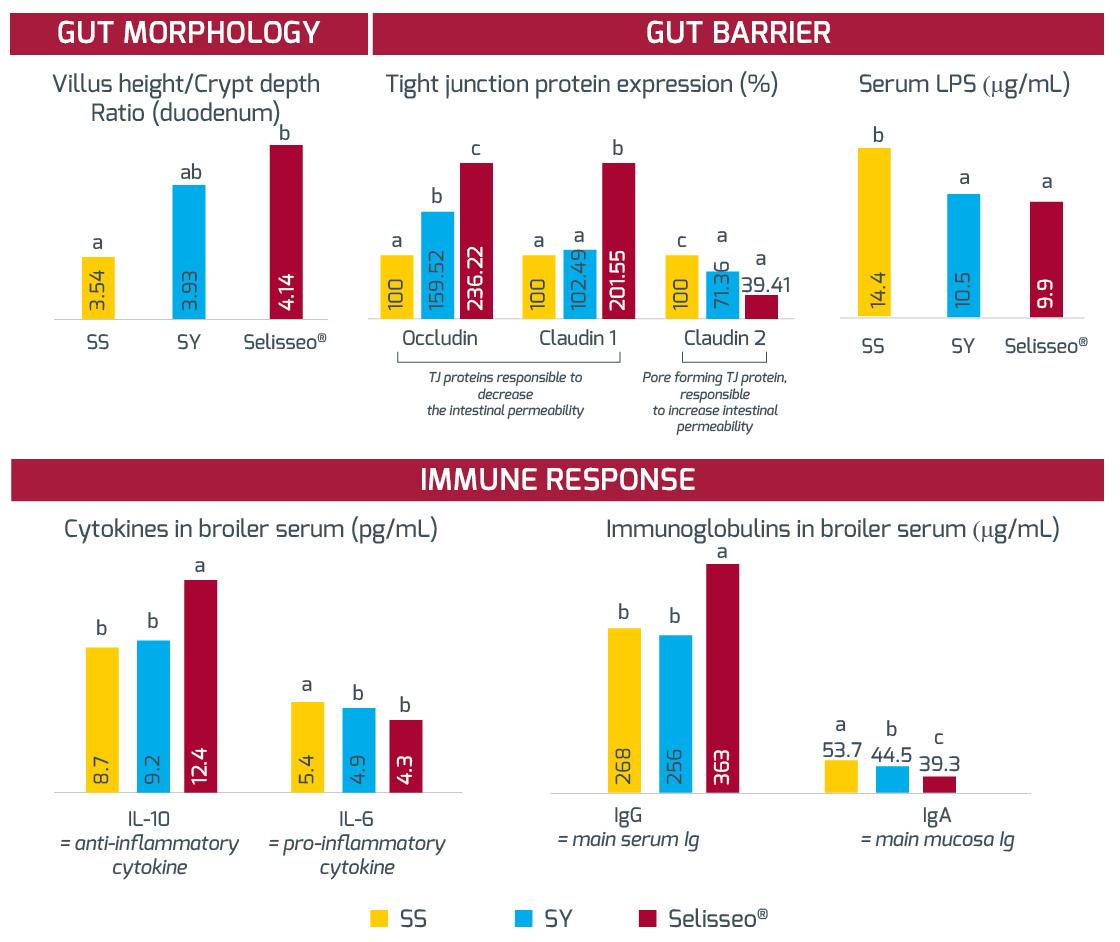
SS + 0.23 ppm (3/4) SY or 0.075ppm (1/4) SS + 0.23 ppm(3/4) OH-SeMet. The results between the house and pens agreed very well with each other, demonstrating that growth performance is improved when birds consume OH-SeMet-supplemented feeds. Birds fed the OH-SeMet had a numerical improvement in final body weight (+70g) and an adjusted 2 to 4 point improvement in FCR across the pen and house setup (Figure 3).
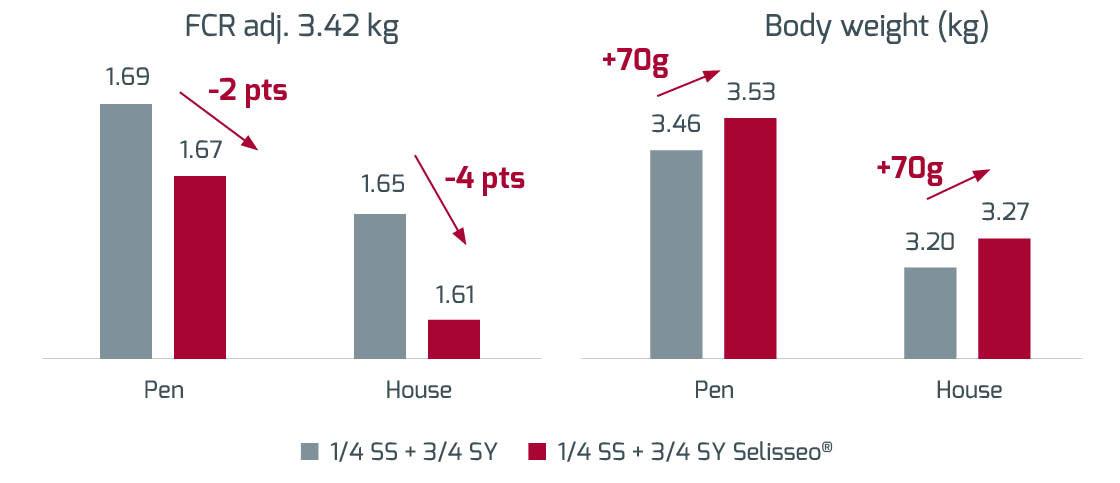
page 44 September/OctOber 2023 Feed Compounder
Figure 2 - Effects of different sources of Selenium on gut morphology, gut integrity, and immune response
Figure 3 – House and pen data regarding body weight and mortality corrected FCR to 3.42kg
Piglet
Weaning is a known stressful event for piglets. They face dietary, social and environmental changes. These conditions can increase oxidative stress and influence health, disease and ultimately mortality. A trial conducted by Sichuan Agricultural University (China) has shown how OH-SeMet can improve the antioxidant capacity of piglets. Weaned piglets were fed a negative control diet (no Se supplementation), a positive control diet (supplemented with 0.3mg/kg of selenium from Sodium Selenite (SS)) or an experimental diet supplemented with 0.2mg/kg of selenium as OHSeMet, for 28 days. Serum samples were taken to determine the total antioxidant capacity (TAC). Analysis showed that OH-SeMet significantly improved the TAC in the serum and numerically in the liver (Figure 4).
These effects were coupled with an increase in piglet performance, demonstrated by a numerical improvement in feed to gain ratio (Figure 5).
A reduction in the occurrence of diarrhea was also observed in this study (Figure 5). OH-SeMet treatment significantly reduced the diarrhea rate compared to negative and positive controls. This is thought to be due in part, to the improved immune status of piglets fed OH-SeMet. By enhancing Se reserves, more will be available to
provide antioxidant protection, during stressful episodes, including weaning and sanitary stress.
Dairy cow
Supplementation with OH-SeMet increases the Selenium status of cattle and provides optimal antioxidant protection. Greater effects are seen in dairy cattle fed OH-SeMet, compared to both SY and SS. The effects of OH-SeMet supports the performance of dairy cows and calves, particularly during times of stress.



During heat stress (32–36°C, 40% humidity, period 9 days), the milk yield of cows significantly reduced compared to thermoneutral conditions (TN) (21.2 kg/day vs. 31.1 kg/day) (Table 3). These results allowed us to validate the efficacy of the HS model.
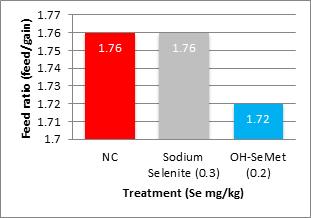
Feed Compounder September/OctOber 2023 page 45
TN HS P-value DMI, kg/d 17.2 11.2 <0.01 Milk yield, kg/d 31.1 21.2 0.02
Table 3: Effect of heat stress on Dry Matter Intake (DMI) and milk yield vs thermoneutral conditions
Figure 5: Feed efficiency of weaned piglets and Incidence of diarrhea in weaned piglets (trial carried out at Sichuan Agric. Univ.)
Total Antioxidant Capacity (µg) Feed ratio (feed/gain) Treatment (Se mg/kg) Treatment (Se mg/kg) Diarrhea (%)
Figure 4: Total Antioxidant Capacity in the serum of 49 day-old piglets (trial carried out at Sichuan Agric. Univ.)
It has been shown to maintain a higher milk yield, despite a similar drop in dry matter intake as cows fed sodium selenite (Figure 6). This improvement in milk yield was positively correlated with a greater total antioxidant capacity, as well as a lower level of circulating plasma nitric oxide and hydrogen peroxide (Sun et al. 2019).
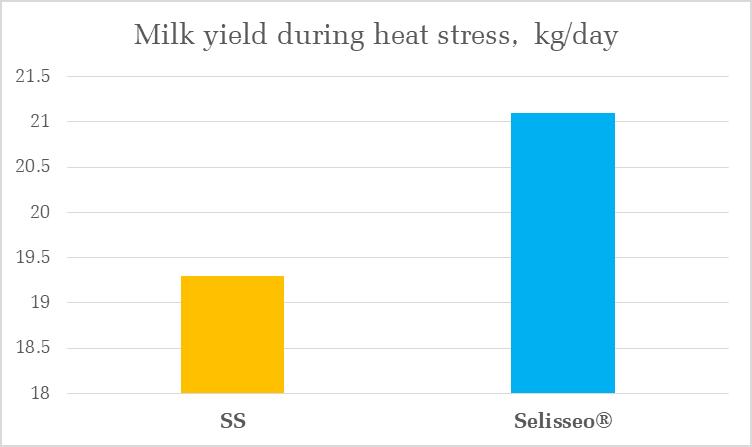

Conclusion
Livestock health, growth, and productivity are largely dependent on the balance between the incredibly high rate of its metabolism, the stressors it encounters, and its ability to neutralise the highly reactive and destructive metabolites that are generated through those processes.
Supplementation of organic Se, in the form of OH-SeMet (Selisseo®, Adisseo), allows the livestock to build a significant level of Se in its tissues. When the tissue Se reserve status is high under challenging conditions, with oxidative stress, the livestock is more equipped to get back to a normal redox balance by stabilising normal cellular processes throughout the animal. This will result in normal metabolism, more efficient immune responses, higher gut integrity, and ultimately better performance. The efficacy and strong results of OH-SeMet confirm that the source and form of Se matters for highpotential animal production.
Adisseo is building a new powder methionine plant in China
Adisseo has announced that it is building a new powder methionine plant with an annual production capacity of 150Ktons in Fujian Province in China. The total investment amount is expected to be around Renminbi (RMB) 4.9 billion. The plant is expected to operate in 2027.
Dr. Zhigang Hao, Chairman and CEO of Adisseo, said: “By demonstrating unparalleled cost and size leadership in the liquid methionine, Adisseo is willing to also complement its leadership in powder methionine to become one of the global frontrunners in 2030. This project will strengthen our leading position in the methionine industry as well as optimise our methionine product portfolios and global production capacity layout, thereby creating value for our customers. Sustainability and digitalization are key success factors of the project. Adisseo is fully committed to implementing FORUS (SinoChem HSE strategy: For Runner Strategy), to fully leverage digital capabilities to design a smart plant, to apply green technologies and source lowcarbon raw materials etc., aiming to build a greener, smarter, and more competitive plant.”
Adisseo can produce liquid and solid methionine simultaneously. The Adisseo Nanjing plant is one of the world’s largest, most technologically advanced, and competitive liquid methionine production platforms. In China and other emerging markets, the demand for powder methionine is still strong. The global demand for various types of methionine is expected to continue especially in China and other Asia Pacific countries (APAC). With this investment, Adisseo is aiming
to become one of the global frontrunners in the powder methionine market in the future.
The 150Ktons/year powder methionine project will be located at Quanhui Petrochemical Industrial Zone, Quanzhou City, Fujian Province, China, with an estimated investment amount of around RMB 4.9 billion. Thanks to the adjoining to SinoChem, Adisseo’s sister company, the project is expected to benefit from strong synergies in supply chain, receiving operational support and cost advantages by optimising capital investments and operating costs as well as enhanced whole value-chain sustainability. Driven by a growing population and declining arable land per capital, as well as the growing awareness of environmental sustainability, the global methionine market continues to grow with unchanged fundamentals, especially in China and other APAC countries where cost competitiveness, economy of scale, and a multi-asset approach are essential for success. The project will further contribute to the “One-China” Strategy and will allow to strengthen Adisseo’s global leading position in the methionine industry while allowing to optimize its methionine product structure and global production capacity layout. The project will allow Adisseo to further strengthen cost advantage and improve overall performance profitability through innovative technology synergy and production scale effect, empowering the company to further reinforce its competitiveness in the methionine industry. Additionally, methionine is an important contributor to the improvement of feed conversion.
page 46 September/OctOber 2023 Feed Compounder
P=0.08
Figure 6. Effect of OH-SeMet on Dry Matter Intake (DMI) and milk yield during heat stress (Sun et al, 2019)
NEW ADDITIVE IMPROVES FEED AND NITROGEN USE
To help drive production from home grown forages, a new supplement combining the proven benefits of molasses and regulated release proteins with added methionine in the form of MetaSmart from Adisseo will help improve nitrogen and feed efficiencies this winter and help to reduce protein use and feed costs.
“Molasses is well known for improving fibre digestion and rumen function which will be important this winter, while sugars will provide a valuable source of rumen fermentable carbohydrates without the risk of SARA,” comments Georgina Chapman from ED&F Man. “Our research proven Regulated Release protein supplies the rumen with a synchronised release of protein and energy.”
She explains that around 85% of UK dairy diets are short of the amino acid methionine, particularly when lower protein diets are fed and that supplementation can have a positive effect on milk yield milk quality, health and fertility, while also increasing nitrogen use efficiency and overall feed efficiency.
ReguSmart 27 from ED&F Man brings the total unique combination and benefits of molasses and methionine in a single easy to feed supplement. It is a high dry matter liquid feed with 53% sugars, 27% crude protein with the optimal inclusion of digestible methionine with 2.5% of MetaSmart. It is formulated to be fed at 1.4kg/day.
It uniquely brings together the ability to optimise rumen microbial protein production using regulated release protein technology while balancing the amino acid supply
reaching the cow to optimise nitrogen efficiency and performance.
“Preliminary results from the University of Reading show that adding 1.4kg of ReguSmart 27 can reduce dietary crude protein by 500g/day, equivalent to 1kg of soya without impacting production. Nitrogen Use Efficiency increased by 6% showing cows were making better use of the protein in the diet, milk urea was reduced significantly, and feed costs were reduced by 10p/cow/day.
“ReguSmart 27 is a practical and easy way to deliver the methionine needed to help cows perform to their potential this winter,” Ms Chapman concludes. For more information call 0151 944 3915.
ROBUST GUT FOR BETTER CALF PERFORMANCE
The Britannia range of energized calf milk replacers from TBA has been enhanced with the addition of a uniquely formulated additive pack to help develop and maintain a robust gut, allowing calves to optimise the use of nutrients fed.
“The milk fed calf has low gastrointestinal barrier function and immunity before weaning, making them highly susceptible to infection by intestinal pathogens,” comments Trevor Birchall.
“Calves are born and raised in a wide diversity of environments and housing conditions, all of which affect the risk of enteric disease. Ensuring all calves have robust gut development is crucial for feed utilization and immune response. Many factors including stress, inadequate feed rates and infection can compromise the gut.
“Once compromised the rate of absorption of nutrients is reduced affecting
calf growth and development. It also leaves the calf much more susceptible to challenge from the infectious pathogens that are found in all calf houses.
“There will never be a substitute for exemplary hygiene management in calf buildings, taking all steps to try and reduce the risk and extent of infections. But by making the gut more robust through daily feeding of proven additives we can help ensure calves grow and develop to their full potential.
“The Britannia range was developed and is formulated to support increased levels of milk feeding to promote high growth rates and better development of the calf. It now contains the Patriot Gold additive pack which contains a unique blend of proven natural additives that combine to help maintain the robust gut calves need.
“One of the additives helps to strengthen the gut barrier by using several biological mechanisms to help reduce inflammation, making it harder for pathogenic bacteria to cross the gut wall and cause infection. The other, a yeast derivative, actively binds to pathogenic bacteria making it impossible for them to cross the gut wall.
“The sooner the resilience of the gut wall is increased, the better the calf can perform. Our revised Britannia range means calves are getting the help they need from birth.
“With a robust gut and the highest quality nutrient sources, calves will exploit the early growth and be well on the way to becoming excellent heifers when they enter the herd,” Mr Birchall predicts. For more information call TBA on 01300-345711.
Feed Compounder September/OctOber 2023 page 47
CFE GROUP SEMINAR TO SPOTLIGHT PELLETING MACHINE INNOVATIONS
CFE Group is set to host a seminar to spotlight pelleting machinery innovations. The seminar is scheduled to be held in late April 2024 (exact date to be confirmed) in Haydock, UK. The event will be an engaging collaborative discussion, centred around pelleting machine advancements.
The seminar’s focal point will be an in-depth exploration of pelleting machine technologies. Experts and engineers from the CFE Group and CPM will shed light on the pelleting machine design, efficiency optimisation, and sustainable manufacturing practices.
The event also offers a platform for coffee chat sessions, creating an informal place for industry peers, professionals, and enthusiasts to exchange ideas, share experiences, and build valuable networks. This interactive aspect of the seminar encourages the cross-pollination of ideas, fostering a collaborative environment that extends beyond the confines of the factory floor.
An exclusive highlight of the seminar is an immersive guided tour of CFE Group factory where participants will be able to witness pelleting machines and dies. The tour presents an opportunity to gain insights into the meticulous craftsmanship and quality standards upheld by the CFE Group.
Further details will follow closer to the seminar date.
AB AGRI ACQUIRES NATIONAL MILK RECORDS PLC (“NMR”)
AB Agri has completed the acquisition of NMR, the leading agri-tech supplier of management information and testing services to the UK dairy supply chain.
NMR provides management information and testing services to the UK dairy supply chain, developing technology used to inform farming efficiency and animal welfare, and quantify food provenance.
Milk samples are regularly collected from virtually every dairy farm in Great Britain, positioning NMR as a highly respected and present voice across the dairy sector.
NMR’s success has been driven by strong collaborative relationships with key industry players, including dairy farmers, vets, milk processors, third party suppliers, and major retailers. NMR continues to develop and invest in new products and services, notably genomics and GenoCells.
Commenting on the acquisition, AB Agri CEO José Nobre said: “I am delighted that AB Agri has acquired NMR. NMR is a high-quality business which is extremely complementary and additive to our dairy strategy and offering to the dairy industry.
“We have supported dairy farmers for more than 30 years with nutrition and specialty feed products, and more recently with data and technology platforms which deliver insights that create continuous improvement in agricultural supply chains.”
Commenting on the acquisition, NMR Finance Director, Mark Frankcom said: “We are delighted to now be part of AB Agri. AB Agri’s status within the UK agricultural sector and expertise in the dairy industry will provide a significant benefit to NMR’s customers.
“As the UK dairy supply chain continues its drive to carbon neutrality, NMR’s work with GenoCells and milk data, and our pivotal role in payment testing, will contribute important information to aid in this transition.
“The backing of AB Agri will accelerate and de-risk NMR’s ability to deliver its strategic objectives, streamlining industry processes by creating a holistic business that can provide end-to-end data and analysis to ensure the long-term sustainability, efficiency and profitability of UK dairy.”
ALLTECH MYCOTOXIN TEAM AWARDED TOXINS 2022 BEST PAPER AWARD
One of Alltech’s mycotoxin research papers has been recognised by Toxins, a prestigious international research journal, as one of three winners of their 2022 Best Paper Awards. The paper, “Co-Occurrence of 35 Mycotoxins: A Seven-Year Survey of Corn Grain and Corn Silage in the United States,” was written by Alltech Mycotoxin Management team members Dr. Alexandra Weaver, global technical support; Nick Adams, global director; and Dr. Alex Yiannikouris, research group director; along with an independent researcher Dr. Daniel Weaver.
“Research and innovation are at the core of our business at Alltech, and we are proud of this recognition of the innovative work being conducted by our global mycotoxin management team,” said Dr. Mark Lyons, president and CEO of Alltech. “Mycotoxins are ever-present on the farm, and they pose a real threat to the productivity of even the best-run livestock production operations. Mycotoxin management should be on every feed producer and farmer’s radar.”
Alltech’s winning paper describes
how mycotoxins contaminate corn grain and silage in the United States with frequent co-occurrence of fusaric acid with deoxynivalenol, fusaric acid with 15-acetyldeoxynivalenol, and fusaric acid with fumonisin B1, highlighting the importance of assessing multiple mycotoxins, including emerging mycotoxins and mycotoxin metabolites, when developing risk management programs.
Mycotoxins contaminate crops worldwide and play a deleterious role in animal health and performance. Multiple mycotoxins can co-occur, which may increase the negative impact on the animal. To assess the multiple mycotoxin profile of corn, Alltech conducted a sevenyear survey of new crop corn grain and silage in the United States. A total of 711 grain and 1117 silage samples were collected between 2013 and 2019 and analysed for the simultaneous presence of 35 mycotoxins using ultraperformance liquid chromatography–tandem mass spectrometry at the Alltech 37+ Analytical Laboratory.
The study showed that multiple mycotoxins were often present in both corn grain and corn silage in the U.S. In fact, 90.2% of grain and 96.5% of silage samples contained at least two types of mycotoxins. Fusaric acid was the most frequently detected mycotoxin in 78.1 and 93.8% of grains and silages, respectively, followed by deoxynivalenol in 75.7 and 88.2% of samples. The greatest cooccurrence was between fusaric acid and deoxynivalenol in 59.1% of grains and 82.7% of silages, followed by fusaric acid and fumonisin B1, deoxynivalenol with 15-acetyl-deoxynivalenol, and fusaric acid with 15-acetyl-deoxynivalenol.
The research also discovered that some of the more frequent mycotoxins they found were ones that may not be routinely analyzed by many programs, such as fusaric acid and deoxynivalenol, underscoring the importance of testing for multiple mycotoxins when developing management programs.
Mycotoxin challenges have risen in recent years along with the incidence of extreme weather conditions, such as droughts, floods and heat waves. In the U.S., 100% of samples contained two or more mycotoxins, according to the 2022 Alltech Harvest Analysis. In Europe, 79% contained two or more mycotoxins.
“Being selected for this award shows the interest in and importance of testing for multiple mycotoxins,” said Dr. Alexandra Weaver. “When we better understand the full mycotoxin profile of a feedstuff or ration, more informed decisions on mycotoxin management can be made.”
The winning paper was published by Toxins in July 2021, and can be accessed online. For more information about the Alltech Mycotoxin Management program, visit knowmycotoxins.com.
page 48 September/OctOber 2023 Feed Compounder
SFT EDGAR PYE RESEARCH SCHOLARSHIP 2023
The 2023 Edgar Pye research scholarship application is currently open. The prize fund for this year is £2,000 and the closing date for submission is the 31st October 2023. For more information and to apply please email secretary@sft.uk.com.
MOLE VALLEY FARMERS TAKES ON DEDICATED ORGANIC MILL
Mole Valley Farmers has strengthened its commitment to the organic ruminant sector by taking on the lease of ABN’s feed mill at Uffculme, Devon.
The mill will operate as a dedicated organic facility, enabling the farmer-owned business to better service its organic customers, whilst driving greater efficiencies and cost savings across its supply chain.
The agreement will come into effect from Friday 1st September, with all of the existing, highly experienced workforce at Uffculme joining the Mole Valley Farmers business.
Mole Valley Farmers’ CEO, Jack Cordery said the new site would benefit shareholders, members and farming customers alike. “The number of organic feed manufacturers in the south west has reduced in recent years, but as a business we remain firmly committed to the organic sector,” he explained.

bag warehousing, which will streamline the supply chain for customers and the retail stores. In addition, it will be possible for a greater range of conventional raw materials to be held at Huntworth, helping to reduce formulation costs and improve quality.
Mr Cordery added: “Our commitment remains to all of our existing feed mills. The additional mill will ensure we are well placed for the years ahead, helping us to deliver our core purpose of supporting our farmer shareholders to improve productivity, profitability and sustainability.”
MOLE VALLEY FARMERS LAUNCH NEW TRIO OF ORGANIC DAIRY COMPOUNDS
Mole Valley Farmers has launched three new organic dairy compounds as part of their growing commitment to the organic sector. Having announced their investment in a dedicated organic mill at Uffculme in Devon, the new compounds are just part of an overall drive to help organic farmers improve their productivity, sustainability and profitability in what is a challenging marketplace.
Mole Valley Farmers Nutritionist and Organic Champion, James Paxton said: “The trio have been specifically formulated to meet organic farmer requirements for the autumn and beyond, taking into consideration the need to maximise milk from forage and sustainability.
“They join our extensive range of organic feeds, which have been carefully formulated to meet the needs of a variety of production systems and stock types.”
The products are:
TRIALS CONFIRM EFFICACY OF A METHANE-REDUCING FEED SUPPLEMENT FOR RUMINANTS IN ACHIEVING REDUCTIONS IN METHANE EMISSIONS BY DAIRY COWS
Two on-farm trails conducted by the Università Cattolica del Sacro Cuore, the first of their kind in Italy, tested the efficacy of Bovaer® in ruminants consuming Italian dairy cow diets, that are rich in corn silage. At the recommended minimum dose, Bovaer® reduced enteric methane emissions by 44 to 50 percent while maintaining milk production and composition, milk fatty acids profile, animal health and welfare, and feed efficiency. These positive results, which follow more than 60 successful trials in 17 other countries, demonstrate once again that Bovaer® is highly effective in reducing methane emissions in dairy cows.
“Bringing Uffculme into our portfolio will enable us to move organic production out of our Huntworth Mill in Somerset, into a dedicated facility. This will drive significant efficiencies through Huntworth, promoting better use of energy and tighter cost control, whilst removing the complexities of running a single mill that produces both conventional and organic rations.”
The new Uffculme site is 25 miles south of Huntworth, located off Junction 27 on the M5. Having a dedicated organic mill will enable the production of a wider range of finished organic products, expertly formulated by Mole Valley Farmers’ technical team.
The new site will also allow the production of organic monogastric rations. This will put greater competition into the marketplace and the potential for further expansion into this sector in the future.
Moving organic production out of Huntworth will facilitate greater manufacturing capacity for conventional bulk feed and Mole Valley Farmers’ bagged products at this site It will also allow the business to in-source
• Organic AC Gen 19, which has been specifically developed for autumn block calving herds to support production in early lactation. The quality compound includes high levels of Digestible Undegradable Protein (DUP), to encourage good yields at a low feed rate. A careful balance of starch and fibre helps to maintain rumen stability and encourage forage intakes, whilst different sources of starch also encourage the production of microbial and milk protein.
• Organic ProBal 27 - an ideal protein balancer for those farmers feeding higher levels of homegrown cereals this season or faced with low protein grass silages. Protein sources include beans, rape and soya.
• Organic GBF 16, which joins the Mole Valley Farmers Great British Feeds range, where all of the major feed ingredients are grown in the UK. This good all rounder includes UKgrown beans, lucerne and oats and will appeal to those farmers looking to reduce the environmental impact of their rations.
All of Mole Valley Farmers’ organic feeds are certified by Organic Farmers & Growers (OF&G).
During the trial at CERZOO, the dairy farm of Università Cattolica, cows were either fed an Italian, corn silage based, diet with a quarter teaspoon of Bovaer® or assigned to a control group. The GreenFeed system was used to analyze the cows’ breath for methane, carbon dioxide, and hydrogen emissions, enabling the methane reduction achieved with Bovaer® to be measured accurately. The trial also monitored other relevant parameters, such as milk production, milk composition, feed intake, and animal health. The trial consisted of two phases: the first started in summer and the second in winter, with cows receiving a quarter teaspoon of Bovaer® in both their summer and winter diets. UNICATT is currently preparing to publish the results in a peerreviewed journal.
Erminio Trevisi, Full Professor at Università Cattolica, commented that: “3-NOP or Bovaer® has been extensively tested by our scientific colleagues around the world and promises to deliver a significant reduction in methane emissions from dairy cows. We are very pleased that the trial at CERZOO, Università Cattolica’s dairy farm, has achieved significant methane reductions with an Italian diet and dairy cow system, while maintaining milk quality. Our modern facilities enable us to accurately measure feed intake and, exhaled gases from the cow, as well as the more common parameters of milk production, composition, and animal health.”
Feed Compounder September/OctOber 2023 page 49
Jack Cordery, Mole Valley Farmers CEO
UFAC-UK UNVEILS NEW MAJOR MILL UPGRADES

UFAC-UK has completed a major upgrade to its UK manufacturing facility, enhancing production efficiencies and helping to reduce its carbon footprint, through the use of intelligent control systems.
Headquartered in Newmarket, with production co-ordinated from the dedicated UK mill site in Woolfox, Rutland since 1979, the latest stage of UFAC-UK’s mill development programme has seen a significant investment in a new, bespoke manufacturing management software system and advanced liquid holding facilities, to further increase capacity.
Supporting a dynamic operating environment, the improvements not only align with UFAC-UK’s own “commitment to responsible production”, but also supports the sustainability commitments of its customers and stakeholders.
Completing an 18-month programme of innovation and development across the facility, the latest updates will help meet the growing demand for UFAC-UK’s energy, protein and Omega 3 nutritional solutions, as well as providing increased capacity for bespoke formulations and new product development.
“The new IT system has had a significant improvement on the flexibility and efficiency of operation, regulating when machines are required to be in operation and therefore reducing overall operation time when lines are not required for specific runs,” he adds.
Robert Jones, UFAC-UK managing director, comments, “As a company we are constantly looking at opportunities to drive sustainability, productivity and efficiencies both within our own operation, but also on behalf of our partners and customers.”
“With the upgrades to our UK production facility, we are perfectly positioned to meet growing UK and international demand, but also further invest in the research and product development that has been the cornerstone of the business success,” continues Mr Jones.
“All of this is achieved while we are also improving efficiencies, sustainability and environmental credentials,” he concludes.
SFT POULTRY CONFERENCE 2024 - SAVE THE DATE
The SFT poultry conference is due to be held on the 18th January 2024 at the Windmill hotel in Coventry. Further details will be sent out in the coming weeks.
DAIRY FARM BUSINESSES UNDER THREAT, ACCORDING TO NFU SURVEY
Britain’s dairy farmers are being forced to think seriously about their future due to concerns over insufficient returns, volatile markets and the scale of on-farm investment, a new NFU survey shows. The survey of nearly 600 dairy farmers’ intentions reveals 9% of producers believe they are likely to stop producing milk by 2025 - up from 7% last year. A further 23% said they were “unsure” if their business would continue producing milk beyond 2025.
87% of dairy farmers who responded said they are concerned about the impact of government regulation, with feed prices (84%), energy prices (83%) and cash flow and profitability (80%) other key factors that would curtail milk supplies.
NFU dairy board chair Michael Oakes said: “It’s clear that significant inflationary pressures combined with below cost of production prices are continuing to put the resilience of British dairy farming businesses under threat. We are now facing a crisis of confidence among Britain’s dairy farmers.
“The results of this survey show that, now more than ever, we need resilient and collaborative dairy supply chains. It’s vital we reverse this trend of boom or bust and invest in our supply chains. New industrywide regulation on contracts, expected to be introduced later this year, must support fairer, more transparent and accountable supply chains. But regulation isn’t a silver bullet.
“With increasing global demand for British dairy, we know that the long-term future is bright for our sector. To ensure we maximise this potential, it’s imperative that government continues to work with us to ensure we have the right environmental, regulatory and trade framework in place to support the production of high quality, nutritious and sustainable food.”
FORFARMERS INTRODUCE MYFORFARMERS: THE ONLINE SHOP FOR LIVESTOCK FEED ORDERS
ForFarmers has unveiled a new online ordering platform to make livestock feed purchasing simpler and more flexible.
In what ForFarmers believe to be an industry first, the MyForFarmers platform enables farmers to place compound and dry blend orders any time day or night from their smart phone, tablet or computer. Customers can use MyForFarmers to access help with orders via a direct messaging service. It also provides updates on delivery status and gives online visibility of all order and transactional documents giving farming businesses full control of their purchasing decisions.
Order amendments and an option to pay invoices online for those customers who currently pay by credit card or cheque, will be available by late summer.
MyForFarmers is accessible at www. forfarmers.co.uk/myforfarmers where customers can also find a simple user’s guide and video tutorials giving step-by-step instructions on how to access and use the platform.
“The main focus of all our upgrades has been based around sustainability and efficiency, covering everything from the installation of the new storage tanks and IT system, right down to our new recycled polymer bags and reduced timber pallets on our packaging and distribution channels,” explains Richard Jones, UFACUK commercial manager, who has been over-seeing the upgrades.
Meanwhile, 91% of dairy farmers said the main factor to them increasing milk production would be the scale of investment needed for things such as suitable slurry storage to ensure their farms are compliant - this supports the NFU call for Defra’s Surry Infrastructure Grant to be extended to cover more areas and to lower the minimum spend threshold needed to access the funding.
Hayley Graham, supply chain development lead at ForFarmers said: “With online ordering being the norm across other industries our farmer customers told us they want the same flexibility for their livestock feed purchases.
“MyForFarmers provides that as well as 24:7 access to information, helping farms to streamline their admin and focus on other areas of their businesses.”
page 50 September/OctOber 2023 Feed Compounder
POTENTIAL BREAKTHROUGH PRODUCT FOR BRITISH RUMINANT LIVESTOCK FARMERS
Wynnstay is pleased to announce its involvement as a consortium partner in a research project into the use of daffodils to reduce cattle methane emissions. The Dancing with Daffodils project aims to transform the efficiency and sustainability of ruminant livestock farming and is supported by the Department of Farming, Environment and Rural Affairs and Innovate UK, the UK’s national innovation agency.
The project is developing a novel feed additive, using a specific alkaloid extracted from daffodils, which has been shown in the laboratory to achieve exceptional results in methane reduction and protein utilisation in ruminants.
Preliminary data estimates that direct methane emissions from ruminants can be significantly reduced and that feed protein utilisation may be improved by up to 50%. This could potentially increase the productivity of the ruminant sectors and drive multiple environmental benefits.
The consortium is also spearheading the cultivation of daffodils to support the rollout of this new feed additive and developing a precision on-farm gas analyser to monitor in real-time individual ruminant emissions of methane, hydrogen, carbon dioxide and ammonia.
Gareth Davies, Chief Executive of Wynnstay Group plc, commented: “We are delighted to be a consortium partner in the Dancing with Daffodils project, which has the support of Innovate UK and DEFRA. This exciting project has the potential to deliver a breakthrough product for livestock farmers, which will significantly reduce methane emissions and enhance protein utilisation in ruminant animals.
“There are significant environmental benefits and we very much look forward to helping to progress this project to completion and providing the route-to-market for the technology.”
COUNTER SEASONAL GRASS DECLINE WITH FAT SUPPLEMENTATION
As grass quality and availability decline, appropriate supplementation for dairy herds will be required to safeguard against milk production decreases.

While the higher fibre content of late season grass can be beneficial to milk fat production, a decrease in dry matter and energy availability will reduce performance from grazing, with milk yield suffering as a consequence, says Dr Richard Kirkland, nutritionist for Volac Wilmar Feed Ingredients.
To help fill energy gaps in late season
grazing, additional supplementation will be needed and rumen-protected fat supplements should be a key component in buffer rations to maximise milk yield and quality. Delivering 2.5-times the energy of cereals and more megajoules per bite, fat supplements have a high energy density and support rumen function.
fat supplement like Megalac which has a balanced ratio of C16:0 and C18:1 fatty acids, producers can support milk yield throughout lactation while protecting fertility.
In research findings from the Tasmanian Institute of Agriculture’s Dairy Research Centre, cows on a low-input grazing system produced 2.1kg additional milk at peak lactation, and continued to respond with 1.5kg milk at 200-days in milk following supplementation with 250g/ day of Megalac rumen-protected fat, while maintaining high levels of fertility.
“For a cow to perform to her potential, rumen function must be made a priority. High-starch energy supplements like cereals will lead to the accumulation of acid in the rumen as a result of fermentation, compromising rumen pH and putting the animal at risk of acidosis, and low milk fat. While caustic or other alkali treatments will help, large quantities of cereals can be expected to have a negative impact on butterfats. Digestible fibre sources like citrus pulp and soya hulls will give support to milk fat,” says Dr Kirkland Performance benefits from choosing the right fatty acids
When it comes to selecting a fat supplement for buffer feeding, rumen protection and fatty acid profile need to be made a priority.
Unprotected fats cause an ‘oil slick’ effect in the rumen, physically coating fibre and reducing digestibility. However, rumen-protected fats provide a dense energy source without these risks to rumen function.
It is also important to consider which type of fat supplement is most appropriate for an individual farm as the different fatty acid components will have a major bearing on the expected response.
Products with high levels of palmitic acid (C16:0) will improve milk fat production, but care should be taken if offered to cows in earlier stages of lactation as additional output can be at the expense of loss of body condition. The calcium salt products are a blend of palmitic and oleic (C18:1) fatty acids which will be less stimulatory to milk fat, but the C18:1 component aids fat digestibility (increased energy supply), fertility and promotes improved body condition.
“Cow condition, stage of lactation and requirements from the milk contract are key factors to consider when investing in a fat supplement to provide maximum benefit for each farm,” says Dr Kirkland.
When feeding a rumen-protected
“Throughout the end of the grazing season, buffer feeding with rumenprotected fat supplements will help support energy demands without compromising rumen function. When selected based on fatty acid profile, producers also have the opportunity to benefit desired milk production targets based on their individual contracts and business objectives,” concludes Dr Kirkland.
FEFAC PUBLISHES 3RD FEED SUSTAINABILITY PROGRESS REPORT
FEFAC is pleased to announce the publication of its 3rd Feed Sustainability Charter Progress Report. The publication is a special edition, dedicated to facilitating the implementation of the ambitions of the FEFAC Feed Sustainability Charter, originally released in September 2020. FEFAC takes advantage of putting additional attention on its earlier publication in June 2023 on Sustainable Animal Feeding Techniques, which was presented at the 30th FEFAC Congress in Ystad, Sweden. FEFAC tries to draw the attention of all food chain partners to the existing feed industry solutions that are available to help our partners in the livestock value chain tackle the sustainability and food security challenges that we are collectively facing.
FEFAC President Pedro Cordero: “Three years after the original release of the FEFAC Feed Sustainability Charter, FEFAC seeks to further boost the progress in implementing its key ambitions, showcasing the innovative solutions the sector has to offer to assist the livestock sector with its transition towards more sustainable production systems. Many FEFAC members have in the meantime launched their individual sustainability agendas, roadmaps and action plans, with very dynamic value chain engagements at a national level.”
Feed Compounder September/OctOber 2023 page 51
OCEAN HARVEST TECHNOLOGY GROUP PLC INTERIM RESULTS FOR SIX MONTHS ENDED 30
JUNE 2023
Ocean Harvest Technology Group Plc announces its unaudited results for the six month period ended 30 June 2023 (“the Period”).
The full Interim Report for the period ended 30 June 2023 will be published on the company’s website at www. oceanharvesttechnology.com and the company have laid out the key highlights below.
Financial Highlights
• OHT successfully completed its initial public offering raising gross proceeds of £6,000,000
• Funds raised allows the company to focus on its strategic growth objectives
• 66% growth in product revenue to €1.6 million (H1 2022: €0.95 million)
• 150% increase in gross margin to €0.56 million (H1 2022: €0.23 million)
• Substantial increase in gross margin to 36% (H1 2022: 24%)
• Margin improvements driven by an increase in average selling prices, eliminating selling concessions post Covid-19 pandemic and an improvement in processing yield
• Well funded with no external debt and a period end cash balance of €4.8 million (31 December 2022: €1.2 million)
Operational Highlights
• Strong momentum with new customer wins, having onboarded over 10 new customers in the first six months. This includes a top five swine producer in the US and one of the UK’s largest feed pre-mixers
• Expanded seaweed supply chain in new regions such as east Africa and the Philippines, giving access to materially larger volumes of biomass. OHT has also secured a strategic relationship with a producer of brown seaweed which provides price and volume certainty of supply and is progressing similar arrangements with other seaweed suppliers
• Further improvement in operating efficiencies due to investment in an additional grinding line in Vietnam,
increasing yield significantly
• Completed Life Cycle Analysis of OceanFeedTM which demonstrates that it has a materially lower CO2 equivalent footprint in its manufacture than other common ingredients in animal feed.
• OceanFeedTM can be netnegative as one tonne used as an additive can reduce CO2 equivalent emissions from the feed chain by over 10 tonnes
• Completed further R&D trials which demonstrated the strong efficacy of OceanFeedTM in a number of applications
• The company was awarded a patent which protects the claim made by the company that use of a seaweed blend as a feed supplement improves the quantity and/or quality of eggs produced by egg laying birds
Conclusion and Outlook
• The Group has strong momentum and continues to onboard new customers from its growing pipeline of customer trials.
• The improvements achieved in gross margin year to date are expected to continue due to the revised selling price levels and the company’s developments in seaweed sourcing and processing.
• The outlook for OHT’s supply of seaweed remains strong and supportive of continued growth in the company’s product sales.
• Whilst the Group continues to see revenue growth in line with expectations in Asia and the Americas, it is experiencing some delays in onboarding new customers in Europe. This is resulting from the direct impact of feed ingredient prices affecting customer profitability as well as customers in this region having more entrenched usage of other additives. This shortfall in Europe had been expected to be compensated for in the second half by volume from a recently onboarded new customer in another region which is now opting for lower initial volumes before moving to full use in future.
• In addition, the strengthening of the Euro in 2023 will impact the value of their reported revenue which is primarily sourced in US dollars
• As a result, they now expect to report total revenue for the year in excess of €3.4 million
• The Board continues to see supportive conditions for the growth of OHT’s products, with the market
looking for more sustainable feed ingredients which improve animal production metrics and can replace existing additives such as antibiotics, other synthetic additives and feed ingredients from land based plants. The number of potential customers trialing OceanFeedTM has increased significantly since the start of the year and the potential sales value from those customers has more than doubled to over €10 million. The Board has strong visibility over FY24 revenues that support its forecast revenue growth rates.
Mark Williams, CEO of Ocean Harvest Technology Group, commented:”At our maiden set of interim results I am pleased to say that OHT has begun to deliver on its objectives set out at its IPO in April. We are continuing to strengthen our global sales team and build out our supply chain. We will also continue to invest in R&D to innovate and enhance our existing customer offering in the markets the Group operates in. We will continue to manage some of the short term onboarding delays and we look forward to delivering on our long term growth strategy for our new and existing shareholders.”
DSM-FIRMENICH BEEFS UP ITS FIGHT AGAINST METHANE EMISSIONS, SAVING 50,000 TONNES OF CO2E
dsm-firmenich’s innovative feed supplement Bovaer® has reached a significant milestone in the reduction of enteric methane emissions from cows. To date, the additive has enabled farmers to save 50,000 tonnes of CO2e and counting.
Bovaer® contributes to a significant and immediate reduction of the environmental footprint of beef and dairy products.
The additive suppresses enzymes that trigger methane production in the cow’s rumen, with just a quarter teaspoon of Bovaer® per cow a day reducing methane emissions by 30% from dairy cows and 45% from beef cattle.
Feed additives offer the greatest potential for sector-wide methane reductions and could be feasibly implemented across the dairy and beef chain. Currently, dsmfirmenich is working with partners across the globe to introduce Bovaer to multiple markets and value chains through on-farm trials and pilots.
Following several successful largescale pilots for Bovaer® in May 2023, the Bel Group, a French cheese producer will now deploy Bovaer to all 10,000 cows supplying milk in Slovakia, cutting methane emissions by ¼ for each farm and representing an overall yearly 400-tonne menthane reduction.
page 52 September/OctOber 2023 Feed Compounder
Why levels of mycotoxins may be increasing so much in Europe
By Sander Janssen, DVM, Manager Mycotoxin Risk Management EMEA at dsm-firmenich
The majority of mycotoxins accumulate in the field. Levels of mycotoxins in crops are increasing across Europe, particularly aflatoxin and Fusarium toxins. This increase can be attributed to climate change and the evolving impact it is having on our ecosystems, along with the global commodity trade. Hotter, drier growing conditions and weather extremes favour the growth of toxin-producing fungi and place stress on plants, thereby amplifying mycotoxin contamination.
The rising demand for eggs, meat and milk in recent decades has driven higher EU imports of grains and cereals from developing countries with more tropical climates where mycotoxin occurrence is higher—thus raising the prevalence of mycotoxins in EU data. The presence of mycotoxins in crops presents risks to animal and human health, lowers farm profitability and makes our food system less sustainable and more insecure.
We can pinpoint both natural and artificial factors as influential in contributing to increased mycotoxin levels across Europe, particularly meteorological conditions and irrigation practices.
dsm-firmenich has developed a Mycotoxin Prediction Service. It focuses on the potential for mycotoxin development in wheat and corn. Individual field risk varies within regions, countries even up to districts and are strongly influenced by weather conditions. Additional
factors such as soil management, sowing time and each crop’s genetic resistance also contribute to the (farm) risk level. It combines parameters* affecting disease pressure into sophisticated algorithms, and is real-time updated and improved with data from the dsm-firmenich Global Mycotoxin Survey – the most comprehensive data set on worldwide mycotoxin occurrence. The knowledge on the occurrence of mycotoxins evolves continuously, leading to continuous fine tuning of these prediction services. The Mycotoxin Prediction Service allows crop users and crop producers to make sound decisions in terms of purchasing, quality control and crop management. The concerning projection for the future suggests that proactive measures are imperative to manage and mitigate increasing mycotoxin-associated risks in European crops. The Mycotoxin Prediction Service and Global Survey Data from dsm-firmenich ensure that producers can track changes in the occurrence of mycotoxins in feed materials as a complement to a regular testing and risk mitigation regimen.
* Biochemistry of mycotoxin production, Fungi type, Lifecylce stage, Crop type, Planting date, Information from the dsm-firmenich global mycotoxin occurrence dataset, Sophisticated mathematical algorithms, Hourly global weather data
dsm-firmenich World Mycotoxin Survey January to June 2023
Mycotoxins are naturally produced by fungi that can contaminate feed raw materials in the field and in storage and are detrimental to the health of animals. Adverse effects of mycotoxin contamination include impaired reproduction, digestive disorders, carcinogenicity, and reduced performance.
dsm-firmenich’s World Mycotoxin Survey is described by the company as the longest-running and most comprehensive data set on mycotoxin occurrences and contamination. They state that the survey accurately identifies mycotoxin risks based on time period, animal species and location.
About the Survey
Each year since 2004, dsm-firmenich has analysed a large number of feed samples from all around the world to understand and monitor contamination levels of the different mycotoxins in a variety of feed ingredients. This information is shared in the annual dsm-firmenich World Mycotoxin Survey.
The results
Until June 2023, The World Mycotoxin Survey collected 10,199 samples from 78 countries around the world. The results concluded
that the Fusarium mycotoxins fumonisins, deoxynivalenol and zearalenone are most frequently found, with the highest region of mycotoxins found in North America, South Asia and China and Taiwan.
The survey includes further details on:
• Prevalence levels for each mycotoxin in each region
• Global and local risk levels for each mycotoxin
• Risk levels posed to each species
• Comparison of prevalence levels from January-June 2022
• More information about Spectrum 380
“Mycotoxins are an ever-present threat to animal health, performance and sustainability. The latest results reveal a continuously evolving set of challenges, highlighting the importance of diligent monitoring and state-of-the art mitigation strategies to the feed and animal protein industry’s profitability,” stated Ursula Hofstetter, Head of Mycotoxin Risk Management at dsmfirmenich.
To download the dsm-firmenich World Mycotoxin Survey from January to June 2023 please visit their website.
Feed Compounder September/OctOber 2023 page 53
Feed Production Machinery, Pelleting & Extruding
CFE GROUP
CFE have acquired Sevale Engineering in Gloucester and Turner Grain in Dublin in the past two years. Both companies provide valuable engineers and supply chain solutions for our Group. CFE have been partnering key customers in the past number of years in facilitating the optimisation of energy efficient quality throughout. Our value creation strategy at CFE Group is focusing on our core business, where we serve our current market positions in the compound feed industry. In maintenance, we refurbish pellet mills, flakers and grinders at our Haydock facility and our team of eight engineers, across the UK and Ireland, concentrates on contract maintenance for customer equipment. We are maintenance and service specialists, competent, highly experienced, and fully up to date with the technology and operating systems of the different brands of manufacturing equipment supplied to the feed and bio-mass markets.
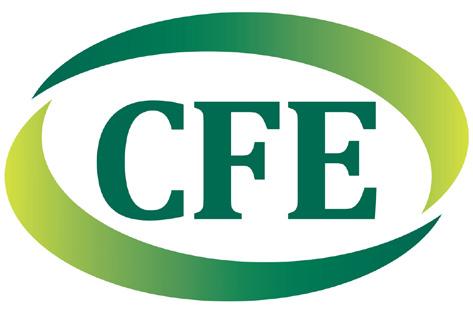
We are also growing our market share by increasing the footprint of CPM in the compound feed business. In the past year we have sold two new CPM Roskamp Grinders, 12 CPM Conditioners, 10 CPM Pellet Machines (7932/ & 7936/12) and supported all the CPM equipment in UK & Ireland We have a strong pipeline for the next two years, where we plan to continue this growth. CPM’s Double Pelleting system is by far the preferred production practice for ruminant feed. While expanders and high friction conditioners can give customers the edge for specific formulations, the Ruminant feed business has clearly opted for double pelleting ahead of all other processing systems, it gives consistent quality, maximum throughput and an energy efficient pellet. It’s important to match horsepower as closely as possible on the top and primary presses and the working width of dies must be in the range of 20%, i.e. the primary press being no more than 20% more open than the pre-pellet machine. Direct drive motors on a Double Pelleting stand reduce the installed motors from 4 to 2 and direct drives give more energy efficiency and torque required to keep the press running across a range of formulations.


CFE’s Cost per Tonne (CPT) is an inclusive service for maintenance, pelleting consumable supply and engineering support, that offers feed compounders an insurance policy, guaranteed supply chain and working partnership. The CPT is a 3-year contract that cost matches against tonnes produced and invoices issued monthly; eliminating the peaks and troughs that can impact feed milling. The customer advises CFE of its tonnage on the final day of each month and the invoice is based on the actual tonnage figure. We are proud to continue working alongside our
compound feed partners as we all strive to grow and support our most important indigenous industry.
www.cfegroup.com
CONDEX (UK) LTD
La Meccanica Pellet Mills since 1986
La Meccanica pellet mills come with a 5 year, no major service guarantee. This means that as long as the machines are maintained and greased in accordance with the manufacturer’s guidelines, there will be no major servicing costs for the first five years; no seals, no bearings and most importantly no down-time.
With the large diameter, two roller design providing the optimum angle of nip and the main rotor having a high inertia, the La Meccanica pellet mills are one of the most efficient machines on the market, outperforming larger machines as a result of the design and main motor being utilised to its full potential.
No gearbox so no oil leaks around the pellet mill or more significantly into the feed; a major consideration now that UFAS directive states that food safe lubricants need to be used.
Condex also supply an extensive range of mixing, grinding, conditioning and ancillary equipment, including being an official agent for Geelen Counterflow coolers. Ensuring our clients are able to meet the high demands of the industry with equipment designed and manufactured to the same high standards as our pellet mills.
Our in-house design and installation services enable us to tailor equipment and process lines bespoke to a client’s requirements. This gives our clients the confidence of knowing all aspects of the process are taken into consideration, whether this is upgrading a single machine or a complete production line. With a single point of contact the end user can be reassured there are no surprises, no hidden costs and no delays as a result of miscommunication between contractors.
page 54 September/OctOber 2023 Feed Compounder
Customer satisfaction is our number one priority; we achieve this with UK based stock and service engineers, around-the-clock aftersales support and a die and roll refurbishment service second to none. Peace of mind at competitive prices.
Condex (UK) Ltd, White Cross, Lancaster, Lancashire, LA1 4XQ
Tel: 01524 61601, Fax: 01524 381515, Email: info@condex.co.uk, Web: www.condex.co.uk / www.pelletmills.com
DSL / DATASTOR SYSTEMS

Imperium4Feed is the new mill control system offered by DSL Systems and Datastor Systems combining their wealth of knowledge and experience to provide leading-edge process control, planning (MES) and information software for mills of all sizes.


increased throughput by 15%”
For further information or to arrange a demonstration, please contact:
Matthew Swallow
T: + 44 (0)1159 813700
E: matthewswallow@dsl-systems.com
Web: dsl-systems.com

Bill Wright – T: +44 (0) 1260 277025, E: billwright@datastorsystems.com Web datastorsystems.com
FUCHS LUBRICANTS (UK) PLC

food grade lubricants
In the animal feed industry, the use of food-safe machine lubricants can mean the difference between a good name and no name at all. The production of animal feed puts the strictest requirements on the lubricants used in the manufacturing process.
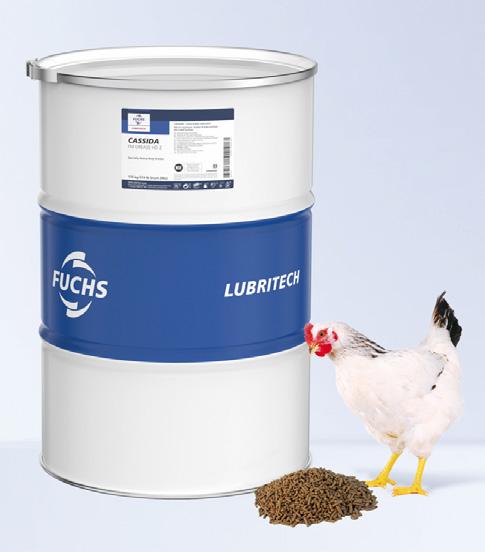
Consumer protection is absolutely essential. Incidental oil contamination at any point in the process needs to be avoided by animal feed manufacturers, who process millions of kilograms of animal feed for global markets every year. In addition, ensuring that the production process runs smoothly and is highly effective (meaning longer component lifetimes and extended maintenance intervals) is our number one priority.
Imperium4Feed’s pellet press and extruder control modules are designed to optimise quality, improve throughput and eliminate blockages. Imperium4Feed has a number of features to optimise pellet press control including automatic start-ups, flying bin-swaps, cooler fan speed optimisation, cold start-ups, anti-blockage detection, layered change overs and automatic flushing
All configurations of pellet mills, extruders and expanders are catered for, including: -
• Single pellet mill, Double side by side, Double in line, 3 pellet mills per line
• Up to 8 pre-pellet press bins per production line
• Hot start conditioner, long term conditioner, expander, HFC and BOA
• Kettle or Ripener
• Extruder
• Cooler control
• Fats spray at the die
• Downstream Fats Coater (PPLA)
• In-line pellet tester
“Changing control of our pellet presses to Imperium4Feed has
Our customers benefit from the excellent quality of the CASSIDA portfolio, which has been confirmed by numerous OEM approvals given by well-known manufacturers of production and manufacturing equipment.
Today, major animal feed manufacturers are taking the risk out of their processes by using CASSIDA food grade lubricants as the safe alternative for all lubrication points in their production plants.
Our support package
As well as providing you with high-performance food grade lubricants, FUCHS is able to offer expert technical advice and support. FUCHS can assist with oil condition monitoring, failure analysis and diagnosis, Lubrication Critical Control Point (LCCP) surveys, and much more.
Performance and safety
The CASSIDA range is NSF H1 registered, as well as being the first food grade lubricant range to receive ISO 21469 certification. Certified for Halal and Kosher production, the CASSIDA range provides a total solution for the animal feed industry.

Julian Potts, FUCHS UK
Email: Julian.Potts@Fuchs.com
Web: www.Fuchs.com/uk
Feed Compounder September/OctOber 2023 page 55
Protein Products
ALLTECH
Reducing waste and increasing agri-food sustainability with OPTIGEN®
Ongoing protein supply and pricing pressures coupled with scaling environmental demands, makes for a complex situation for all U.K. dairy and beef enterprises both now and looking to the future.
A vital component in overcoming this challenge, is supplying modern productive ruminants with optimal levels of ammonia for the rumen to function effectively. Excess ammonia leads to excreted nitrogen waste, whilst a deficit impacts fibre digestion.
Optigen® provides a slow-release consistent source of non-protein nitrogen (NPN) to the rumen bacteria over time, leading to an increase in microbial protein, an improvement in fibre digestion and a reduction in nitrogen excretion.

A recent meta-analysis on Optigen evaluated the results of 17 dairy studies carried out in 6 countries, and 17 beef studies carried out in 9 countries. The research found Optigen to be a viable substitute or supplementation for plant protein sources in ruminant rations.
The proven benefits of Optigen in dairy cows
• Reduces soybean meal use by 21%
• Improves feed efficiency by 3%
• Improves nitrogen use efficiency by 4%
• Increases production profitability of a 1,000-dairy herd by £13,035
• Lowers the carbon footprint of a 1,000-dairy herd by 647 tonnes of CO2e
The proven benefits of Optigen in beef cows
• Improves both feed efficiency and liveweight gain by 8%
• Reduces time to slaughter by 9 days
• Increases production profitability of a 1,000-beef herd by £14,146
• Lowers the carbon footprint of a 1,000-beef herd by 111 tonnes of CO2e
For more information, please contact:
Tel: +44 (0) 1780 764512
Email: ukreception@alltech.com
Web: www.Alltech.com/uk/
AZELIS
Azelis offers a range of plant-based protein products.
Highly concentrated and digestible potato, pea, wheat and corn proteins can be used as alternatives to or partly replace traditional proteins.
TUBERMINE® GP potato protein provides protein enrichment and is known for its richness in essential amino acids available in higher amounts than in traditional proteins. The outstanding digestibility is particularly well suited to the young, newly-weaned animal’s high protein requirements and is well recognised as an excellent source of protein for piglet feed.
LYSAMINE® GPS concentrated protein extracted from peas, is a valued nutritional ingredient in many applications. Its excellent digestibility along with its naturally low antitrypsin activity makes it a protein of choice in the nutrition of young animals, particularly piglets.
VITEN® Vital wheat gluten natural protein extracted from wheat, is a water-insoluble complex protein.
Recognized especially for its high glutamic acid content, the plantbased protein shows exceptional digestibility and can be used in the formulation of high-performance feeds by limiting the risk of non-digested protein in the large intestine.
It is a useful alternative protein source which is appreciated in milk substitutes and piglet feed for its excellent digestibility, colour and palatability.
GLUTALYS ® corn gluten meal is a highly digestible protein concentrate rich in sulphur amino acids (methionine cystine). A polyvalent protein source, it offers advantages in formulas for ruminants because of the low natural degradability of the protein fraction in the rumen and its high post ruminal digestibility.
For further information please contact Leia Trotman at Azelis on: +44 (0)7792116659 or via email: leia.trotman@azelis.co.uk
BENEO
Sustainable alternative ingredients in animal feed
With increased scrutiny on ingredient sustainability in animal feed, BENEO, one of the leading manufacturers of functional ingredients, has recently launched a range of faba bean hulls and starch rich flour that

page 56 September/OctOber 2023 Feed Compounder Feed Ingredients …
can be used as a vegetal protein or fibre source for animal feed.
Faba beans are a very promising crop, due to their ability to fix nitrogen from the air for themselves and subsequent crops, reducing both fertilizer input and greenhouse gas emissions (GHG) at farm level. Additionally, being a local source of vegetal protein, their use avoids imports of raw materials from outside Europe. BENEO’s faba ingredients are produced in Germany and it strives to source the beans at Farm Sustainability Assessment (FSA) Gold level from German farmers. Also, the production process has been chosen for its low energy consumption in comparison to alternative processes, overall contributing to BENEO’s carbon neutrality and sustainability targets. With a faba bean range that includes hulls, starch-rich flour and protein concentrate, BENEO offers feed compounders a non-GMO and sustainable source of fibre, energy and protein. These quality ingredients allow for the development of feed formulas with sustainable alternative sources.
Web: www.beneo.com
BIOCHEM
RumiPro® Urea – a high quality slow-release urea for optimising protein supply in ruminants. R elease the full power of your cows by the use of RumiPro ® urea and produce more milk solids. RumiPro ® Urea has a high-quality non-palm-based fat coating for a constant release of nitrogen in the rumen. It offers additional options to optimise the protein supply of the rumen microbes helping to maintain an efficient rumen fermentation. RumiPro® Urea increases microbial protein yield and supports cellulolytic bacteria to improve fiber digestibility. The high nutrient density is crucial to create a well-balanced diet for high producing dairy cows and opens additional possibilities in case of suboptimal forage quality.
TechnoYeast® - Kluyveromyces fragilis for function and flavour
TechnoYeast ® is a hydrolyzed yeast based on the strain Kluyveromyces fragilis, a specific strain of yeast suitable for feeding all species. TechnoYeast® is produced by a gentle process in which all nutrients are released and made more available for high digestibility, meeting the needs of young animals. TechnoYeast® contains both components of the yeast cell wall – mannan oligosaccharides (MOS) and β -glucans – along with the constituents of the yeast extract: highly digestible proteins, essential and functional amino acids such as the umami-tasting glutamic acid, nucleic acids as a source of nucleotides, and minerals. The combination of increased palatability, with the addition of nucleic acids, gives both improvements in feed intake and improved gut functionality, resulting in animals which consume more and can make better use of nutrients. TechnoYeast® has applications for all animal species where increased feed intake is beneficial.
For more information visit: www.biochem.net
BORREGAARD
Borregaard is a leader in bypass protein technology, supplying markets worldwide for more than 30 years. Our products SoyPass, RaPass and Amipro feature high levels of undegradable, yet highly digestible protein that are perfect for today’s ration balancing programs.
Soybean meal and rapeseed meal are known to be high value protein sources for animal feeds. During digestion, however, some of the vegetable protein is broken down in the rumen of the cow, far too early in the digestive system for the high yielding cow to fully use it.
Bypass products overcome this problem by protecting the protein while in the rumen, but allowing it to be fully digested within the small intestine. Consequently, better utilization of the essential amino acids occurs resulting in improved milk production.
SoyPass, RaPass and Amipro are manufactured and sold by our approved licensees. All of our bypass proteins are produced according to our strict quality requirements, and are among the most consistent bypass proteins on the market.
Borregaard UK Ltd

Clayton Road, Warrington
Cheshire, WA3 6QQ United Kingdom.
Tel: +44 (0)1925 285400
Email: Glenn.Dearsley@borregaard.com
Web: www.borregaardfeed.com
CHERWELL VALLEY SILOS LIMITED
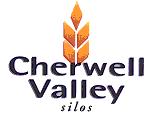
Cherwell Valley Silos Ltd have a long well established reputation for providing specialised cooked protein and oilseed products to the animal feed industry.
Products available are CV-Soy - full fat soya (Profat typically 54%), and PURA LM (Profat 42%) - a mixture of domestic pulses and whole rapeseed recently upgraded with a lower moisture content for better handling characteristics and improved nutrient density. In addition we offer a Linseed based blend Linbean (Profat 38%) which is a highly digestible alternative to Linseed expellers.
The main soya product is conventional ‘Any origin’ Full Fat Soya (CV-Soy A/O) – supplied with SSS certification if required. We continue to specialise in the production of NON GM Full Fat Soya produced from UK grown Soyabeans when available (CV-Soy Non-GM ) or otherwise manufactured from certified Non GM EU origin soya beans.
All manufactured products are accredited under FEMAS and BETA NOPS schemes.
We can also supply raw whole soyabeans in bulk bags or bulk.
Centrally located in Oxfordshire and with our own transport operation, Cherwell Valley Silos are ideally situated to satisfy all customers nationwide. All products are available in bags and bulk ex
Feed Compounder September/OctOber 2023 page 57
stock and all full fat soyas are available in high quality pellet form for improved handling and storage characteristics.
Valley Trading our grain trading operation is managed by Russell Lake - and continues to specialise in local grain, rapeseed and pulses for both consumption in house and third party trades and offers a high quality local independent service to the arable farming community and feed compounding industry.
Simon Robbins, Sales Manager,
Cherwell Valley Silos,Twyford, Banbury, Oxon, OX17 3AA
Tel: 01295 816201, Fax: 01295 812531
Email: simonr@cvs-ltd.com
Web: www.cherwellvalleysilos.co.uk
Russell Lake – Valley Trading.
Tel: 01295 816221
Email: russell@cvs-ltd.com
KEMIN
Kemin’s amino acid program for better raw material allocation in ruminant formulation
is an opportunity for ruminants to produce more efficiently through increased protein utilisation and reduced nitrogen excretion, having one of the biggest impacts on farm profitability and sustainability. The cow has specific requirements for individual amino acids and both Methionine and Lysine, which are the first essential limiting amino acids. An inadequate supply affects animal health and productivity. Amino acid nutrition also provides flexibility in formulation when selecting or substituting different feed materials due to either price or availability.
Table 1 describes the ingredients and nutrient profile for three diets, Control diet, Scenario 1, without soybean meal and Scenario 2, with soybean meal, but with 65% lesser amount than the Control diet. All meet the protein requirements for 35kg of milk at 4% and 3.5% milk fat and protein respectively. But Scenarios 1 and 2 also meet amino acid requirements by using KESSENT® Me and LysiGEM™ (rumen-protected Methionine and Lysine, Kemin Industries), saving 84g of metabolisable protein.
The formulation with Kemin´s rumen-protected amino acids improved the nitrogen efficiency, by 2.1% from 28.8% (Control), to 30.9% (Scenarios 1 and 2), with a better allocation of available raw materials at less cost.
References are available upon request.
Contact
Email: robert.hamilton@kemin.com
Rising feed prices, their high volatility and low availability are the most limiting challenges presently facing dairy farm viability. However, there
Web: www.kemin.com
Table 1. Ingredients (kg DM/head/day) and nutrient profile (CNCPS v6.55) of three formulation scenarios. 1ME, Metabolisable Energy; MP=Metabolisable Protein; CP=Crude Protein; MP balance = % requirements

page 58
September/OctOber 2023 Feed Compounder
Ingredients Control Scenario 1 Scenario 2 Premix 0.205 0.205 0.205 Soybean meal 46 % CP 1.530 0 0.540 Rapeseed meal 2.670 3.649 2.937 Triticale grain 1.760 1.760 2.024 Corn grain ground 2.640 2.816 2.640 Wheat straw 0.517 0.517 0.517 Grass silage 16% CP 8.180 8.180 8.180 Corn silage 35% DM 4.900 4.900 4.900 Barley grain ground 1.760 2.112 2.112 KESSENT® Me 0 0.009 0.010 LysiGEM™ 0 0.022 0.018 Nutrient profile Control Scenario 1 Scenario 2 ME (Mcal)1 61.2 61.1 61.1 CP (%)1 17.2 15.9 16.0 MP (g)1 2,709 2,621 2,625 MP balance1 104 100 100 Met % MP 2.2 2.5 2.5 Lys % MP 6.5 6.8 6.8 Lys:Met 2.95 2.70 2.74
CARGILL TAPS INTO NOVEL INGREDIENTS FOR FEED
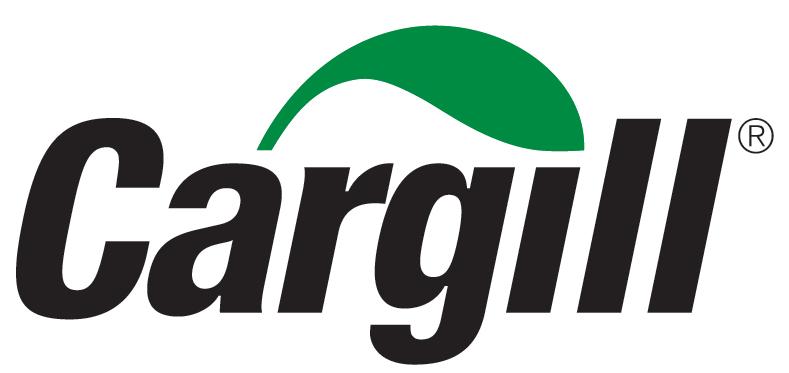
Proteins and fats can come from many sources, but perhaps one of the most novel is that found in insects.
The advantages to using insects (specifically black soldier fly larvae) are numerous. In addition to being a source of high-quality protein and fatty acids, insects are powerful ‘up-cyclers’, meaning that they can feed off large quantities of local agricultural by-products, can be bred in vertical farms with low environmental impact and are part of most animals’ natural diet. In addition, they are a sustainable and ‘circular’ ingredient with local, European origin.
Cargill is already using insect protein within its Aqua Nutrition business as it can be produced using a fraction of the land, water, and resources required with lower emissions than traditional production, thus helping fish producers meet their sustainability goals. The company is finding new ways to reuse by-products and develop fish nutrition that promotes and enhances the health of farmed fish. Beyond being a high-quality feed offering, Innovafeed’s insect meal can save up to 16,000 tons of CO2e (carbon dioxide equivalents) for every 10,000 tons of insect protein, depending on the composition of the feed.
While Cargill’s initial collaboration with Innovafeed has focused
on Aqua Nutrition, the expanded partnership includes more species, starting with the use of oil derived from insects in swine and poultry feed. Using insect oil in piglet diets represents a reduction in the carbon footprint of the oil component of the diet by up to 81% compared to vegetable oil sources. After three years of running trials and exploring the practical solutions to be able to use insect oil in piglet feed, Cargill is now at the stage where piglet feed with insect oil is being produced and sold to certain markets outside of the UK.
In addition to application in piglets, Cargill is pioneering trials to compare insect oil versus plant oils in broiler diets, and to date has found similar performance with no detrimental effects. The insect oil from black soldier fly larvae is relatively high in lauric acid. It is further exploring the expected benefits of lauric acid in insect oil on broiler gut health and welfare.
When the trials on broiler feed conclude, Cargill will look to work with customers to bring more products from insect-fed livestock to retailers’ shelves and to consumers who are increasingly recognising the use and benefit of insects in meat production, including as an alternative and sustainable source of protein and oil.
Email: communication@innovafeed.com

THE NEXT STEP IN THE SEARCH FOR SOYA REPLACEMENT IN PIG DIETS
As part of its long-term and continued strategy to reduce the carbon value of feed in pig diets, the latest ABN trials looking into soya alternatives are returning encouraging early performance results, while significantly reducing environmental footprints.
With soyabean meal being one of the main contributors to the carbon value of feed, including land use change, ABN has been working on an ongoing programme of trials looking at alternatives, in part driven by retailer requests.
“There has been some work across the industry considering the use of pulses as an alternative to soya in monogastric diets, but these latest trials are looking at the next step, considering whether a pre-processed pulse and rape blend can either replace or significantly reduce the use of soya in pig rations,” explains Dr Steve Jagger, ABN’s senior pig nutritionist.
Two separate trials are currently underway, across over 1,000 weaning pigs and a total of 4,000 finishing pigs. At the mid-way point, early signs are highly encouraging.
Finishing pig trial
The trials with finishing pigs, from 40kg to slaughter, have been looking at four levels of replacement, from full inclusion of soya all the way down to complete removal. It is being undertaken through three phased diets, at the growing, intermediate finishing and final finishing stages.
“During the three growth stages different pre-process pulse rape blends were utilised in the full replacement of soya,” explains Dr Jagger.
The first stage of the trial, with 2,000 finishing pigs, has now been completed and has shown good performance levels, with equal performance to the soya-based diet. The next stage is due to complete before the end of the year, and the results will be combined and analysed.
Weaning pig trial
The weaning pig trials, with pigs from 10-40kg, have looked at another pre-processed pulse rape blend.
“While soya cannot be completely removed from the weaning pig diet, we have been able to significantly reduce it and achieve a good performance,” adds Dr Jagger.
“While growth rate was maintained, intake was increased but the carbon reduction was significant,” he says.
Reduction in carbon value of feed
From the trials to date, there has been an approximate 40% reduction in the carbon value of feed, including land-use change, when comparing the full soya inclusion against the highest pre-processed pulse rape blend diet. These calculations are based on GFLI figures.
“These are significant reductions, and extremely encouraging. We are very enthused to see these trials through to their culmination, and will then combine and analyse the total results,” says Dr Jagger.
“Our driver is to try and develop products to help the industry reduce its carbon values. While at the preliminary stages, these latest trials look like a significant step forward in this space,” he concludes.
Feed Compounder September/OctOber 2023 page 59
Cargill UK Strengthens Poultry Technical Team
Cargill UK has extended its poultry team with the addition of three technical and formulation poultry specialists.
Luke Barnard has joined the team as UK technical application specialist, supporting the sales team by offering individual and tailored support to customers.
Since graduating in biological sciences, Luke has gained 12 years of experience in technical and product development roles in global animal nutrition companies, focusing on monogastrics.
Most recently he had a European role promoting new product development and technical services in gastrointestinal health of poultry.
Luke is a member of the Poultry Science Association, and he has had several peer-reviewed papers published.
Patrick Beyeler is a masters graduate in animal nutrition and spent a few years as a technical adviser on farms before joining Cargill South Africa, in 2016, where he took the role of technical lead with responsibility for larger poultry accounts.
He has worked closely on promoting and supporting Cargill through feed additives, formulations and technologies in the Sub Saharan African region.
Here in the UK, Patrick is the customer formulation nutritionist working closely with poultry clients and senior nutritionists on improved formulations and the nutrient profile of diets using the latest technologies available.
Cargill’s new technical sales specialist Chris Burton has more than 20 years’ experience in the UK poultry industry, starting his career on broiler units and taking on management responsibilities.

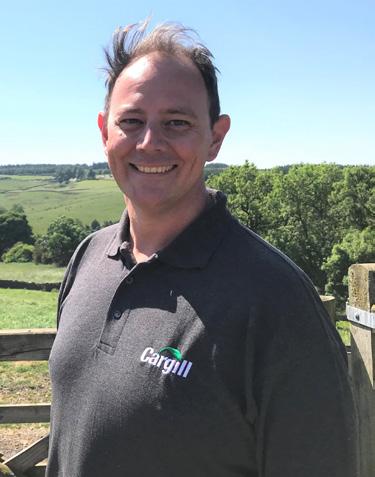

He then moved into the feed industry and managed a Moy Park feed mill with responsibility for the staff and ensuring consistent quality of the finished product. Most recently, after gaining a masters degree in poultry science from SRUC, he has managed sales of feed safety and health products for poultry in the UK and Ireland.
“I am delighted to have an experienced team of inspired and knowledgeable specialists available to UK poultry producers,” says
commercial manager for Cargill UK poultry David McBride. “We have the expertise to bring the company’s global research and developments to poultry producers here in the UK and the industry knowledge to support them on their own units and with their own individual targets and goals.”
Vicky Robinson Joins AIC as New Head of Sustainability
The Agricultural Industries Confederation (AIC) has appointed a Head of Sustainability to lead and develop its work in this core area for the UK’s agri-supply industry. Vicky Robinson is leading the trade association’s sustainability policy work as it scales up its influence in this critical area. She joined AIC in late June. A 2019 Nuffield Scholar, Vicky was previously Technical Director at Linking Environment And Farming (LEAF), which followed 22 years working for Natural England and its predecessors on agri-environment delivery, policy development and implementation.
Vicky said: “I’m pleased to be joining AIC in the new role of Head of Sustainability at such an exciting and dynamic time for the agri-supply industry. With the increasing emphasis on sustainability within our food system, the pivotal role that the agricultural supply chain provides in balancing the provision of nutritious food integrated with the needs of the environment, economic and social systems is key.
“Working across all of the sectors that AIC represents, my role will balance the needs of our Members in delivering AIC’s mission - working in support of modern sustainable commercial agriculture in the UK and supporting collaboration throughout the food chain.”
AIC’s Chief Executive Robert Sheasby said: “I am delighted to welcome Vicky Robinson as AIC’s Head of Sustainability at what is a critical time for UK agriculture and the environment. Her wealth of knowledge and experience in this area is of real value to the agrisupply industry.
“AIC developed its first Agri-Supply Roadmap for a Sustainable Food Chain in 2020 in response to these challenges so that Members can build a more resilient future. Her work will include updating our Roadmap, as well as supporting the recently-launched Sustainability Self-Assessment Framework, and helping Member businesses with the net zero transition. The sustainability brief has seen considerable Member and stakeholder interest, as well as national and international policy development in recent years.”

page 60 September/OctOber 2023 Feed Compounder
CFO Roeland Tjebbes Leaves ForFarmers

ForFarmers has announced that Roeland Tjebbes has decided to resign as CFO and member of the Executive Board as of 31 December 2023 in order to take on the position of CFO elsewhere.

Jan van Nieuwenhuizen, chairman of the supervisory board of ForFarmers, commented: “We regret and respect Roeland Tjebbes’ decision to continue his career outside of ForFarmers. Roeland has fully devoted himself to ForFarmers, both as regards his own portfolio and when we asked him last year to jointly take on the CEO tasks, for which we are duly grateful to him. On behalf of the other members of the supervisory board I wish him the best in his new position.”
The company states that the search process for a new CFO will be initiated immediately.
NOVUS Announces Change of Managing Director for Europe, Middle East and Africa and Global Strategic Accounts Business
Novus International has announced the upcoming retirement of Dr. Uwe Ranft from his role as managing director of Europe, the Middle East and Africa (EMEA) and global strategic accounts. Dr. Volker Seidl will succeed him, bringing 20 years of extensive experience to the role.
Dr. Seidl joined NOVUS as the director of global strategic accounts in 2021. At the time, his extensive experience in the chemical and animal nutrition industries included head of sales excellence and head of global key account management at BASF Animal Nutrition.


In his new role, Dr. Seidl will help guide NOVUS’ commercial strategy within EMEA. In addition to his accountability for the global strategic accounts business, he’ll manage the EMEA sales and technical teams, leverage resources, and align corporate functions to support business growth and deliver value to customers.
The transition period will begin immediately and continue through January 1, 2024, when Dr. Seidl’s appointment takes effect. On January 1, Dr. Ranft will switch to a senior advisory role and continue to support the transition and the business through his retirement date, March 31, 2024.
Feed Compounder September/OctOber 2023 page 61
SODIUM BICARBONATE SODIUM CARBONATE CALCINED MAGNESITE PHOSPHATES A NEW BULK SUPPLY CHAIN FACILITY NEWPORT FEEDS +44 (0)20 8332 2519 +44 (0)20 8940 6691 sales@newport-industries.com Contact us:
Product and Service Finder for the Animal Feed Industry Also available interactive and online at www.feedbuyersguide.com
Trouw Nutrition GB, Blenheim House, Blenheim Road, Ashbourne DE6 1HA
Tel: 01335 341100 Fax: 01335 341171
E-mail: customerservices.gb@nutreco.com
Web: www.trouwnutrition.co.uk
(See Acidifiers, Analytical Services, Animal Health Products, Antibacterials, Chelated Minerals, Enzymes, Feed Additives, Feed Supplements, Milk Replacers, Mould Inhibitors, Mycotoxin Binders, Salmonella Control, Silage Additives)
Promtek Ltd


Fisher Street, Brindley Ford, Stoke-on-Trent, Staffordshire ST8 7QJ
Tel: 01782 375600 Fax: 01782 375605
E-mail: info@promtek.com Web: www.promtek.com
(See Calibration and Weighing Services, Process Control Systems)






CLASSIFIED LISTINGS
ACIDIFIERS
Trouw Nutrition GB, Blenheim House, Blenheim Road, Ashbourne DE6 1HA
Tel: 01335 341100 Fax: 01335 341171
E-mail: customerservices.gb@nutreco.com
Web: www.trouwnutrition.co.uk
ALTERNATIVE PERFORMANCE ENHANCERS
Adisseo
Tel: +353 87 766 8848
E-mail: info.nauk@adisseo.com
Web: www.adisseo.com
ANIMAL HEALTH PRODUCTS
Kernfarm B.V.
De Corridor 14D
3621 ZB Breukelen, The Netherlands
Tel: +31 (0) 346 785 139
Email: info@kernfarm.com Web: www.kernfarm.com
Mervue Laboratories Ireland

Unit 9 Watergrasshill Business Park, Watergrasshill, Co. Cork, T56 HH98, Ireland
Tel: +353 21 21 4391080
E-mail: info@mervuelab.com
Web: www.mervuelab.com
Trouw Nutrition GB, Blenheim House, Blenheim Road, Ashbourne DE6 1HA
Tel: 01335 341100 Fax: 01335 341171
E-mail: customerservices.gb@nutreco.com
Web: www.trouwnutrition.co.uk
September/OctOber 2023 Feed Compounder
ANALYTICAL SERVICES
DM Scientific Ltd, Main Site, Dalton, Thirsk, North Yorkshire YO7 3JA
Tel: 01845 577757
Email: dmacmillan@dmscientific.co.uk
Web: www.dmscientific.co.uk
Trouw Nutrition GB, Blenheim House, Blenheim Road, Ashbourne DE6 1HA
Tel: 01335 341100 Fax: 01335 341171
E-mail: customerservices.gb@nutreco.com
Web: www.trouwnutrition.co.uk
ANTIBACTERIALS
Adesco Nutricines, 23 Strandside South, Abbeyside, Dungarvan, Co. Waterford X35 W778, Ireland
Jack: +353 87 2208816 Seán: +353 85 1667512
Email: info@adesco.ie Web: www.adesco.ie
Trouw Nutrition GB, Blenheim House, Blenheim Road, Ashbourne DE6 1HA





Tel: 01335 341100 Fax: 01335 341171
E-mail: customerservices.gb@nutreco.com

Web: www.trouwnutrition.co.uk
ANTIOXIDANTS
Adisseo
Tel: +353 87 766 8848
E-mail: info.nauk@adisseo.com


Web: www.adisseo.com
AUTOMATED
page 62
BAGGING & PALLETIZING EQUIPMENT
fischbein.com Tel. +44 208 344 6600 www.fischbein.com
salesuk@
BAGGING EQUIPMENT
Concetti S.p.A
S.S. 75 Centrale Umbra, km 4, 190 Ospedalicchio
06083 Bastia Umbra, PG - Italy
Tel: +39 075 801561 Fax: +39 075 8000894
E-mail: sales@concetti.com Web: www.concetti.com
BULK STORAGE AND HANDLING
Croston Engineering Ltd, Tarvin Mill, Barrow Lane, Tarvin, Chester CH3 8JF
Tel: 01829 741119 Fax: 01829 741169
E-mail: admin@croston-engineering.co.uk
Web: www.croston-engineering.co.uk
CALIBRATION AND WEIGHING SERVICES
Promtek Ltd

Fisher Street, Brindley Ford, Stoke-on-Trent, Staffordshire ST8 7QJ
Tel: 01782 375600 Fax: 01782 375605
E-mail: info@promtek.com Web: www.promtek.com
CHELATED MINERALS
Trouw Nutrition GB, Blenheim House, Blenheim Road, Ashbourne DE6 1HA
Tel: 01335 341100 Fax: 01335 341171
E-mail: customerservices.gb@nutreco.com
Web: www.trouwnutrition.co.uk
COMMODITY CLAIMS MANAGEMENT
RMC Commodity Claims Management

3 Clement Road, Fulwood, Preston PR2 9LG
Tel: 07841 198733
E-mail: enquiries@rawmaterialclaims.co.uk
Web: www.rawmaterialclaims.co.uk
ENZYMES
AB Vista
3 Woodstock Court, Blenheim Road, Marlborough Business Park, Marlborough, Wiltshire, SN8 4AN. United Kingdom
Tel: +44(0)1672 517650 Fax: +44(0)1672 517660
E-mail: info@abvista.com Web: www.abvista.com

Adisseo
Tel: +353 87 766 8848
E-mail: info.nauk@adisseo.com

Web: www.adisseo.com
Danisco Animal Nutrition & Health, IFF
PO Box 218
2300 AE Leiden, THE NETHERLANDS
Tel: +31 6 1539 6689
Web: www.animalnutrition.iff.com

Trouw Nutrition GB, Blenheim House, Blenheim Road, Ashbourne DE6 1HA
Tel: 01335 341100 Fax: 01335 341171
E-mail: customerservices.gb@nutreco.com
Web: www.trouwnutrition.co.uk
FEED ADDITIVES
Borregaard UK Ltd

Clayton Road, Risley Employment Area, Warrington, Cheshire WA3 6QQ
Tel: 01925 285423 Fax: 01925 285433
E-mail: glenn.dearsley@borregaard.com Web: www.lignotechfeed.com
Cargill Animal Nutrition
Provimi Ltd., Dalton Airfield Industrial Estate, Thirsk, North Yorkshire, YO7 3HE
Tel: 01845 578125
www.cargill.com/feed

Inform Nutrition Ireland Ltd

Whitescross, Cork, T23 KD50, Ireland
Tel: +353 21 4394770
E-mail: info@informnutrition.com
Web: www.informnutrition.com
Kemin UK Ltd.
Kemin UK Ltd

Castlethorpe Court,Castlethorpe,BRIGG
North Lincolnshire DN20 9LG,England
www.kemin.com
tel:+44.1652.65.10.10 fax:+44.1652.65.54.13
34 Botanic Road, Southport, Merseyside PR9 7NG Tel: +44 (0)1704 537702
Orffa
Minervum 7032
Pancosma SA
Vierlinghstraat 51 4251 LC Werkendam
4817 LZ Breda
The Netherlands
The Netherlands
T +31 183 44 77 66 E info@orffa.com
Find your Orffa specialist at www.orffa.com
Voie des Traz 6, 1218 Le Grand-Saconnex, Geneva, Switzerland
Tel : +41 22 929 84 84 Fax : +41 9259 84 95
E-mail: info@pancosma.ch Web: www.pancosma.com

Trouw Nutrition GB, Blenheim House, Blenheim Road, Ashbourne DE6 1HA



Tel: 01335 341100 Fax: 01335 341171
E-mail: customerservices.gb@nutreco.com
Web: www.trouwnutrition.co.uk
FEED MILL DESIGN AND CONSTRUCTION
Croston Engineering Ltd, Tarvin Mill, Barrow Lane, Tarvin, Chester CH3 8JF
Tel: 01829 741119 Fax: 01829 741169
E-mail: admin@croston-engineering.co.uk
Web: www.croston-engineering.co.uk
Turner Process Equipment Ltd


5 De Grey Square, De Grey Road, Colchester, Essex CO4 5YQ
Tel: 01206 752017 Fax: 01206 854484
E-mail: sales@turnerprocessequipment.co.uk
Web: turnerprocessequipment.co.uk
Van Mourik Group
Boylestraat 34, 6718 XM Ede, The Netherlands
Tel: + 31 (0) 318 64 11 44
E-mail: info@vanmourik-group.com
Web: vanmourik-group.com
Feed Compounder September/OctOber 2023 page 63
FEED MILL EQUIPMENT
The sole UK supplier for Feedtech and supplier of all new and used milling equipment



Go Green Pelleting Solutions Ltd, Unit 8A Brindley Road, St Helens WA9 4HY

Mick Swift – 07500887637 David Kelly- 07500335621 Office Number – 01744808600
www.gogreenpelletingsolutions.co.uk www.feedtech.com.tr
FEED MILL SILO MONITORING
FLAVOURS & PALATANTS
Adisseo
Tel: +353 87 766 8848
E-mail: info.nauk@adisseo.com
Web: www.adisseo.com
Inroads International Ltd

Unit 4, Wem Engineering Centre
Church Lane, Wem, Shropshire SY4 5HS
Tel: +44 (0)1939 236 555 Fax: +44 (0)1939 236 450
Email: info@inroadsintl.co.uk Web: inroadsintl.com
FEED SUPPLEMENTS
Inform Nutrition Ireland Ltd

Whitescross, Cork, T23 KD50, Ireland
Tel: +353 21 4394770
E-mail: info@informnutrition.com
Web: www.informnutrition.com
Premier Nutrition
Kells, Co. Meath, Ireland
Tel: +353 89 2426825
Email: info@lvlogics.com
Web: www.lvlogics.com
Lvlogics Limited, Ballyhist, Carnaross, Silo Monitoring
FEED PATHOGEN CONTROL
Adesco Nutricines, 23 Strandside South, Abbeyside, Dungarvan, Co. Waterford X35 W778, Ireland
Jack: +353 87 2208816 Seán: +353 85 1667512
Email: info@adesco.ie Web: www.adesco.ie
Anitox Ltd
7 Regent Park, Booth Drive, Park Farm, Wellingborough NN8 6GR
Tel: +44 1604 811228
Fax: +44 1604 811013
E-mail: anitoxEMEA@anitox.com Web: www.anitox.com
FEED INGREDIENTS
Azelis UK Ltd

Axis House, Tudor Road, Manor Park, Runcorn WA7 1BD
Tel: 01928 793090
Fax: 01928 716997
Email: nutrition@azelis.co.uk www.azelis.com
Gemcom Ltd
68 Great Portland Street, London W1W 7NG
Tel: +44 (0)20 7580 8004
E-mail: info@gemcom.co.uk
Web: www.gemcom.co.uk
Fax: +44 (0)20 7580 8002
WestendAgri The Heath Business & Technical Park, Runcorn, Cheshire, WA7 4QX
Tel: + 44 (0)1477 544400
Mobile: +44 (0)7961 977623
E-mail: sales@westendagri.com Web: www.westendagri.com
METHIONINE
Adisseo
Tel: +353 87 766 8848
E-mail: info.nauk@adisseo.com


Web: www.adisseo.com
The Levels, Rugeley, Staffordshire WS15 1RD
Tel: 01889 572500
Fax: 01889 577074
E-mail: info@premiernutrition.co.uk
Web: www.premiernutrition.co.uk
Trouw Nutrition GB, Blenheim House, Blenheim Road, Ashbourne DE6 1HA
Tel: 01335 341100 Fax: 01335 341171
E-mail: customerservices.gb@nutreco.com
Web: www.trouwnutrition.co.uk
MANUFCTURING OPTIMISATION SOFTWARE
Promtek Ltd

Fisher Street, Brindley Ford, Stoke-on-Trent, Staffordshire ST8 7QJ
Tel: 01782 375600 Fax: 01782 375605
E-mail: info@promtek.com Web: www.promtek.com
MILK REPLACERS
Trouw Nutrition GB, Blenheim House, Blenheim Road, Ashbourne DE6 1HA



Tel: 01335 341100 Fax: 01335 341171
E-mail: customerservices.gb@nutreco.com
Web: www.trouwnutrition.co.uk
MINERALS/PHOSPHATES
WestendAgri The Heath Business & Technical Park, Runcorn, Cheshire, WA7 4QX


Tel: + 44 (0)1477 544400
Mobile: +44 (0)7961 977623
E-mail: sales@westendagri.com Web: www.westendagri.com
MOISTURE MEASUREMENT & CONTROL
Adesco Nutricines, 23 Strandside South, Abbeyside, Dungarvan, Co. Waterford X35 W778, Ireland
Jack: +353 87 2208816 Seán: +353 85 1667512
Email: info@adesco.ie
Web: www.adesco.ie
page 64 September/OctOber
Feed Compounder
2023
MOLASSES PRODUCTS
E D & F Man Liquid Products UK Ltd
Alexandra House, Regent Road, Bootle L20 1ES
Tel: 0151 944 5100 Fax: 0151 944 3919
E-mail: info.mlpuk@edfman.com
Web: www.edfmanliquidproductsuk.com
United Molasses GB Ltd
48 Gracechurch Street, London EC3V 0EJ
Tel: 0151 955 4850
Fax: 0151 955 4860
E-mail: molassesgb@umgroup.com


Web: www.unitedmolasses.com
MOULD INHIBITORS
Adesco Nutricines, 23 Strandside South, Abbeyside, Dungarvan, Co. Waterford X35 W778, Ireland
Jack: +353 87 2208816 Seán: +353 85 1667512
Email: info@adesco.ie Web: www.adesco.ie
Trouw Nutrition GB, Blenheim House, Blenheim Road, Ashbourne DE6 1HA
Tel: 01335 341100 Fax: 01335 341171
E-mail: customerservices.gb@nutreco.com
Web: www.trouwnutrition.co.uk
MYCOTOXIN BINDERS
AB Vista

Edificio Twin Golf A, C/Perú, 6, 2º Floor, Office 4 28290 Las Rozas, Madrid, Spain
Tel: +34 91 859 1787 Email: info@abvista.com
Web: www.abvista.com
Adisseo
Tel: +353 87 766 8848
E-mail: info.nauk@adisseo.com
Web: www.adisseo.com
Trouw Nutrition GB, Blenheim House, Blenheim Road, Ashbourne DE6 1HA
Tel: 01335 341100 Fax: 01335 341171
E-mail: customerservices.gb@nutreco.com
Web: www.trouwnutrition.co.uk
NUTRITION TOLL MANUFACTURE
B2B Nutrition, Fordton Industrial Estate, Crediton, Devon EX17 3BZ
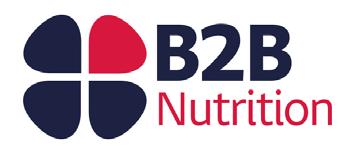
(A division of the Denis Brinicombe Group)
Tel. 01363 775115
Tom Butler (Technical) 07803 736194
Email: tbutler@brinicombe.co.uk Web: www.b2bnutrition.co.uk
PACKAGING SOLUTIONS
Fischbein
Tel: +44 (0)20 8344 6600
E-mail: salesuk@fischbein.com Web: www.fischbein.com
PELLETING EQUIPMENT
Compound Feed Engineering Ltd
5 Haydock Lane, Haydock, St Helens, Merseyside, WA11 9UY
Tel: +44 (0) 1942 728188 Fax: +44 (0) 1942 408430
E-mail: info@cfegroup.com
Web: www.cfegroup.com
PROCESS CONTROL SYSTEMS
DSL Systems Ltd

Adbolton Hall, Adbolton Lane, West Bridgford, Nottingham NG2 5AS
Tel: 0115 981 3700 Fax: 0115 981 3702
E-mail: sales@dsl-systems.com
Web: www.dsl-systems.com
Promtek Ltd

Fisher Street, Brindley Ford, Stoke-on-Trent, Staffordshire ST8 7QJ
Tel: 01782 375600 Fax: 01782 375605
E-mail: info@promtek.com Web: www.promtek.com
SALMONELLA CONTROL
Adesco Nutricines, 23 Strandside South, Abbeyside, Dungarvan, Co. Waterford X35 W778, Ireland
Jack: +353 87 2208816 Seán: +353 85 1667512
Email: info@adesco.ie Web: www.adesco.ie
Trouw Nutrition GB, Blenheim House, Blenheim Road, Ashbourne DE6 1HA
Tel: 01335 341100 Fax: 01335 341171
E-mail: customerservices.gb@nutreco.com
Web: www.trouwnutrition.co.uk
SELENIUM
Adisseo
Tel: +353 87 766 8848
E-mail: info.nauk@adisseo.com


Web: www.adisseo.com
SIEVING & PRECLEANING
Turner Process Equipment Ltd 5 De Grey Square, De Grey Road, Colchester, Essex CO4 5YQ
Tel: 01206 752017 Fax: 01206 854484
E-mail: sales@turnerprocessequipment.co.uk
Web: turnerprocessequipment.co.uk
SILAGE ADDITIVES
Trouw Nutrition GB, Blenheim House, Blenheim Road, Ashbourne DE6 1HA




Tel: 01335 341100 Fax: 01335 341171
E-mail: customerservices.gb@nutreco.com
Web: www.trouwnutrition.co.uk
Feed Compounder September/OctOber 2023 page 65
At Condex you’re not just buying a pellet mill:





Peace of mind:
No bearings, seals or service down time
… Guaranteed for 5 YEARS for UK
Single V-Belt drive;
High inertia, smooth and efficient
No oil leaks into feed or on press floor
Designed, fabricated and built in Italy
Support:
Design and installation services
UK based stock and engineers
2-3 day die and roll refurbishment
Dies held in stock on request
24 hours, 365 days a year
…If the phone works, we do

Experience:
Sales technicians who understand the dayto-day requirements of a busy mill
>50 years manufacturing at La Meccanica

Condex Ltd - established in 1980





Working together since 1986
www.lameccanica.it
……
WHITE CROSS, LANCASTER, LA1 4XQ Email: info@condex.co.uk Telephone: 01524 61601 Web: www.condex.co.uk
Contact us to discuss your requirements











 CPM 24-LT-10 Conditioner
CPM 24-LT-10 Conditioner





























































































 By Robert Ashton
By Robert Ashton





























 By Andrew Mounsey
By Andrew Mounsey































































































